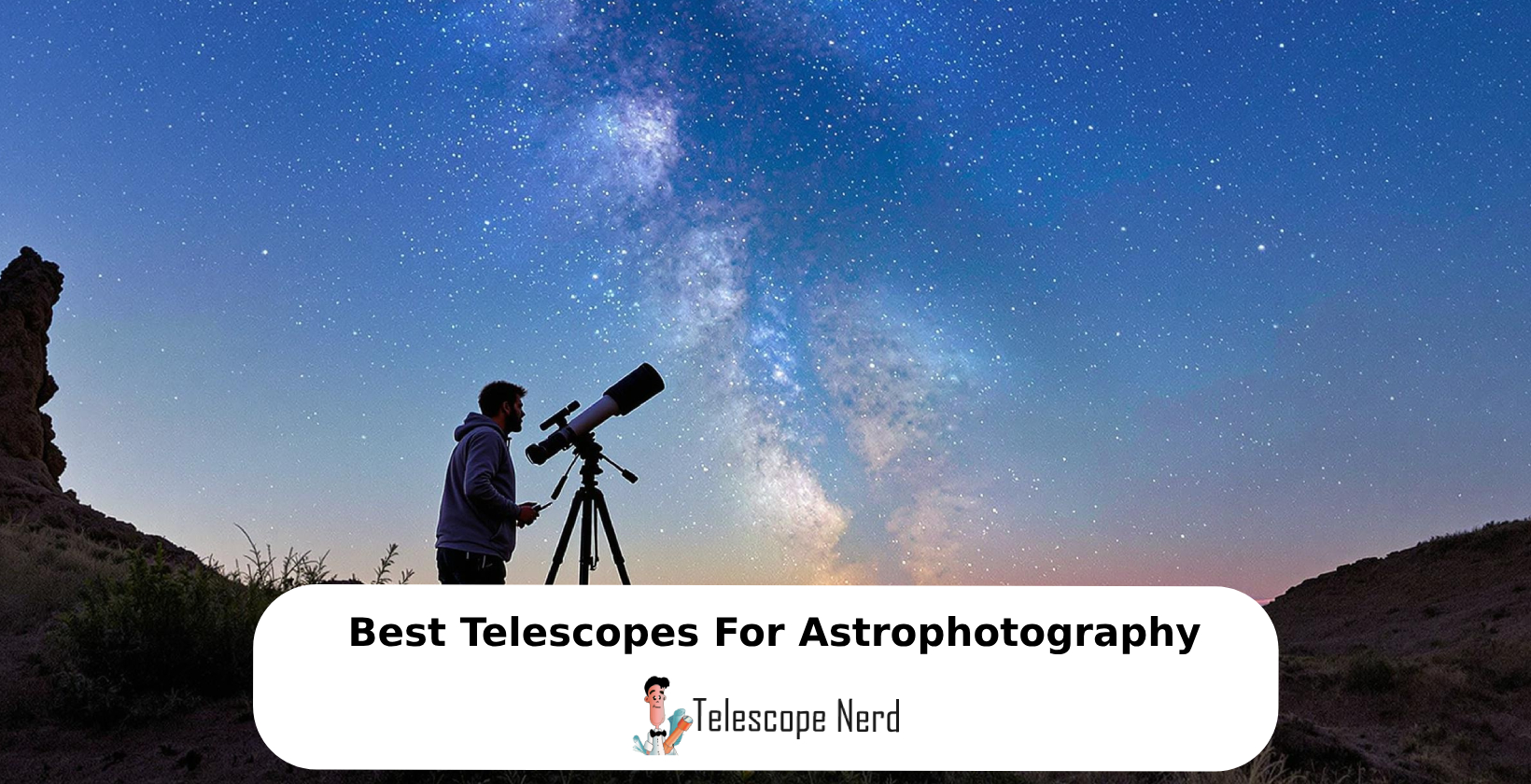34 Best Telescopes For Astrophotography 2025
Telescopes are optical instruments designed for observing distant celestial objects in the night sky. Telescopes come in different price points, types, sizes, and models, catering to both beginners and experienced astronomers. Telescopes play a crucial role in astrophotography, allowing users to capture images of stars, planets, and galaxies. Choose telescopes based on their resolution, accessories, compatibility with cameras, and equipment quality.
The Celestron C8 stands out as a telescope, offering an 8-inch aperture and light-gathering capabilities. Meade LX200 provides features for astrophotographers, including GPS alignment and a robust computerized mount. Celestron NexStar 8SE combines portability with quality optics, making it ideal for both beginners and experienced users.
Refractor telescopes are a preferred type for astrophotography. Refractor telescopes use lenses to produce clear images and minimize distortion. Refractor telescopes eliminate aberrations like chromatic aberration and coma, resulting in sharp images across the field of view. Short focal length refractors between 400-800mm (15.75-31.5 inches) are ideal for capturing field views of large celestial objects. Beginners achieve results with refractors featuring 600-700mm (23.6-27.6 inches) focal lengths and 80-100mm (3.1-3.9 inches) apertures.
1. Celestron C8

The Celestron C8 is an 8-inch Schmidt-Cassegrain telescope renowned for its versatility and performance. Celestron C8 overview reveals an instrument suitable for various astronomical applications. The telescope features an 8-inch (203 mm) aperture, providing light-gathering capability for deep-sky observations. Celestron C8 optics employ a Schmidt-Cassegrain design, combining a spherical primary mirror with a Schmidt corrector plate for sharp, high-contrast images.
The Celestron C8 telescope features a focal length of 2032 mm (80 inches) and a focal ratio of f/10. The optical system delivers resolution views of planets, stars, and sky objects. Celestron C8 weight is 13 pounds (5.9 kg) without the tripod, making it portable for its size. The telescope’s 8-inch aperture balances light-gathering ability and portability, appealing to both beginners and astronomers.
Celestron C8 inch measurement refers to its primary mirror diameter, which determines the telescope’s light-gathering power. The scope offers a limiting magnitude of 14.0 and a resolution of 0.69 arcseconds. Celestron C8 optics feature StarBright XLT coatings, enhancing image brightness and contrast. The telescope comes with a tripod and an altazimuth mount for easy operation.
| Pros | Cons |
|---|---|
| Diffraction-limited 203mm (8″) Schmidt-Cassegrain design achieves ~1,000x light grasp vs human eye, resolving lunar craterlets (>1km diameter), Saturn’s Encke Gap, and faint deep-sky targets (e.g., NGC 2074, M51 core) under dark skies. | Slow f/10 focal ratio (2032mm FL) yields narrow true field of view (~0.6° TFOV at 31mm eyepiece), restricting observation of extended objects (e.g., NGC 869/884 at 0.75° width) without focal reducers (<0.5x). |
| StarBright XLT multi-coatings enhance system throughput (>96% per surface) and contrast transfer, critical for detecting low-surface-brightness features (e.g., galactic dust lanes) and resolving binary stars down to 0.57″ separation (Dawes’ limit). | Limited maximum field of view (1.1° unvignetted) truncates wide-field surveys; requires 0.63x reducer to achieve full-frame sensor coverage (>2.5° TFOV) for mosaic imaging of large nebulae (e.g., Orion Nebula). |
| Aluminum-tube OTA with dual-speed Crayford focuser ensures sub-arcminute precision (±1μm backlash) and supports heavy imaging trains (e.g., cooled CMOS cameras) without image shift, compatible with both 1.25″/2″ oculars/accessories. | System mass of 5.9 kg (13 lbs) yields vibration decay time >4 seconds at 200x magnification, requiring reinforced tripod legs for stability during gusty conditions (>10 km/h wind speeds). |
| Alt-azimuth mount with micro-motion controls provides <1′ tracking drift over 10 minutes at 150x magnification, ensuring stable manual follow-through of solar system objects without motorized assistance. | Mirror-flop-induced image shift during focusing complicates high-resolution planetary imaging; aftermarket mirror locks or fixed-primary designs recommended for unguided exposures exceeding 30s. |
| Limiting magnitude (~14.0) enables detection of faint galaxies (e.g., NGC 253 at 9.8 mag) and quasars under optimal sky conditions, surpassing typical urban sky visibility thresholds. | Central obstruction (35%) degrades contrast transfer function (CTF) by ~15% versus unobstructed refractors, reducing perceived sharpness in low-contrast lunar/planetary details (e.g., Jovian festoons). |
| Accepts 0.63x focal reducers and field flatteners, achieving flat-of-field performance (±λ/4 RMS across 2″ FOV) for coma-free astrophotography with APS-C sensors and rapid f/6.3 prime-focus imaging. | Payload constraints: Alt-az mount struggles to support DSLR/guiding rigs exceeding 5kg, rendering unguided deep-sky astrophotography impractical due to flexure-induced trailing. |
2. Meade LX200
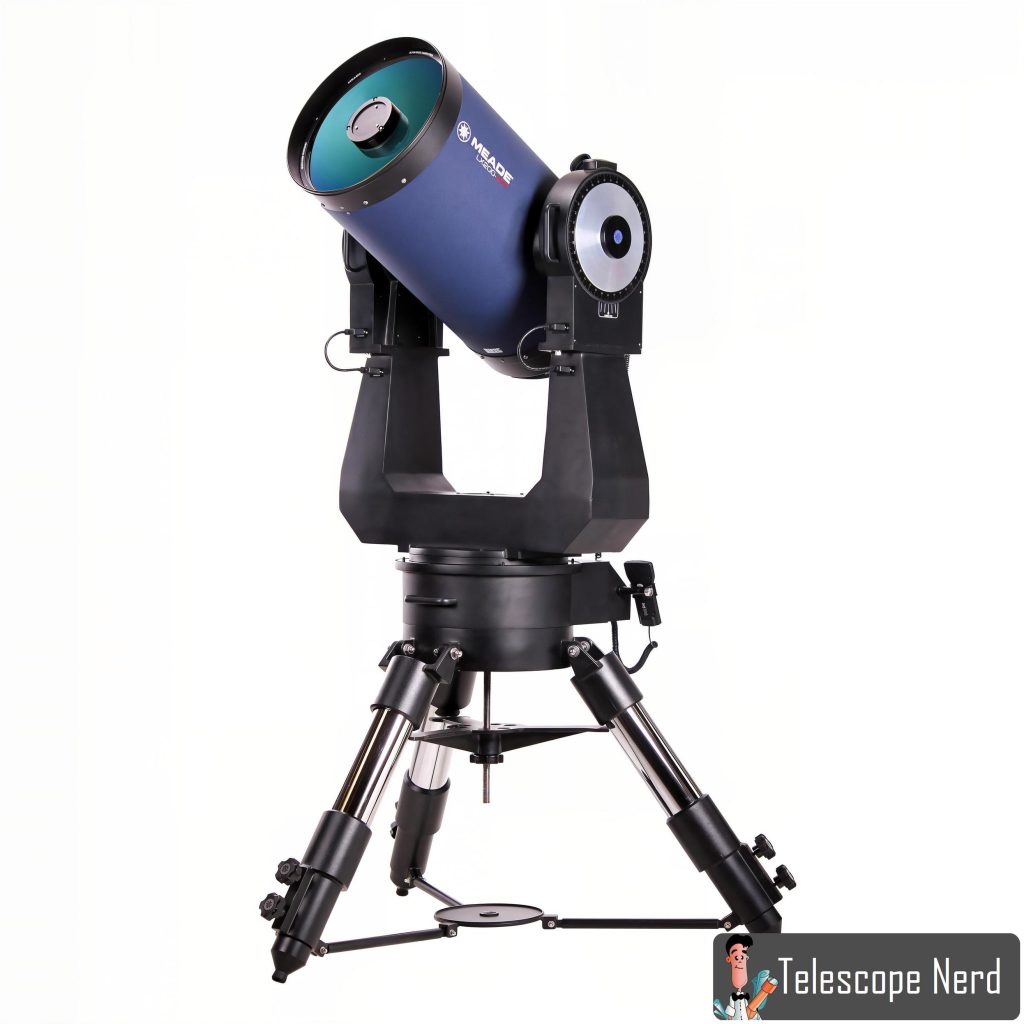
The Meade LX200 is an end computerized telescope series designed for advanced amateur astronomers and astrophotographers. Meade LX200 scopes feature a Schmidt-Cassegrain optical design, offering superior image quality and minimal aberrations. The telescopes come in aperture sizes ranging from 20.32 to 40.64 centimeters (8 to 16 inches), catering to various observational needs.
Meade LX200 scopes come equipped with a GoTo mount and computerized tracking system. The mount provides object location and tracking capabilities, essential for long-exposure astrophotography. Meade LX200 photography capabilities are enhanced by the telescope’s ability to integrate with a range of cameras and imaging accessories. The tracking allows for capturing images of deep-sky objects, planets, and galaxies.
Meade LX200 reflector options include aperture models designed for deep-sky observation. These apertures, including the 14-inch and 16-inch models, offer enhanced light-gathering ability for viewing faint celestial objects. Meade LX200 observatory integration makes it appropriate for permanent installation in home observatories. The telescope’s robust construction and remote operation capabilities allow for use in dedicated observing spaces.
Meade LX200 LX models represent the pinnacle of the series, featuring technologies. The AutoStar II hand controller provides access to a database of over 145,000 celestial objects. GPS alignment ensures accurate setup, while Periodic Error Correction (PEC) improves tracking accuracy for astrophotography. The LX models offer performance with slew speeds and enhanced optical designs for superior image quality.
| Pros | Cons |
|---|---|
| Diffraction-limited Schmidt-Cassegrain optics correct spherical/chromatic aberrations across the visual spectrum (400–700nm), achieving λ/8 wavefront accuracy for high-contrast planetary imaging and deep-sky surveys. | Premium pricing tiers ($2,000–$4,000+) exceed entry-level dobsonian/refractor costs by 3–5×, positioning it as an investment-grade instrument for dedicated astronomers rather than casual observers. |
| Aperture scalability (8–16″) enables variable light-gathering capacities (785x–3,140x human eye equivalence) and resolving powers (0.57″–0.29″ Dawes’ limit), accommodating diverse observational priorities from lunar/planetary studies to galaxy cluster resolution. | System mass of 54 kg (120 lbs) for 14″+ apertures yields vibration decay time >8 seconds at 300x magnification, necessitating reinforced piers or observatory mounts to mitigate wind-induced oscillations (>15 km/h gusts). |
| Synthetic alt-azimuth GoTo mount with dual-axis servo motors achieves <1′ pointing accuracy and ±2″ RMS periodic error (PEC-trained), enabling unguided astrophotography up to 5-minute exposures under optimal seeing conditions. | Multi-step polar alignment process requires stable horizon visibility and iterative drift calibration, increasing setup barriers for urban/suburban observers with obstructed northern/southern horizons. |
| AutoStar II controller integrates 145,000+ object database with real-time tracking adjustments, supporting advanced workflows like meridian flip automation and plate-solving integration via ASCOM/EQMOD drivers. | Embedded software instability reported in legacy firmware versions, including spontaneous memory resets and USB handshake failures during extended imaging sessions; regular factory resets recommended. |
| PEC training functionality reduces RA tracking errors to sub-arcsecond levels (<0.5″ PE after 5 cycles), facilitating long-exposure deep-sky imaging (≤10-minute subs) when paired with autoguiding systems (PHD2-style guiding). | Payload constraints: Mount struggles to support DSLR/camera rigs exceeding 15kg on 16″ OTA setups; dynamic loads from wind gusts (>10 km/h) induce flexure-induced trailing in guided stacks. |
| Cast-aluminum OTA-tube assembly with anti-frost baffling maintains thermal equilibrium (cool-down time ≤45 minutes) while preserving collimation integrity across temperature shifts (-10°C to +35°C operational range). | Not recommended as a first telescope: Complexity exceeds beginner-friendly dobsonian/refractor setups, requiring prior knowledge of equatorial geometry and digital setting circles for efficient operation. |
| Autonomous GPS initialization syncs with satellite networks to achieve <30-second alignment, eliminating manual input of location/time parameters and improving pointing accuracy compared to star-based calibration methods. | Limited portability index (mass/volume ratio) necessitates vehicle transport and dedicated storage solutions, discouraging frequent field deployment versus lightweight carbon-fiber equatorial mounts (<10 kg). |
3. Celestron NexStar 8SE
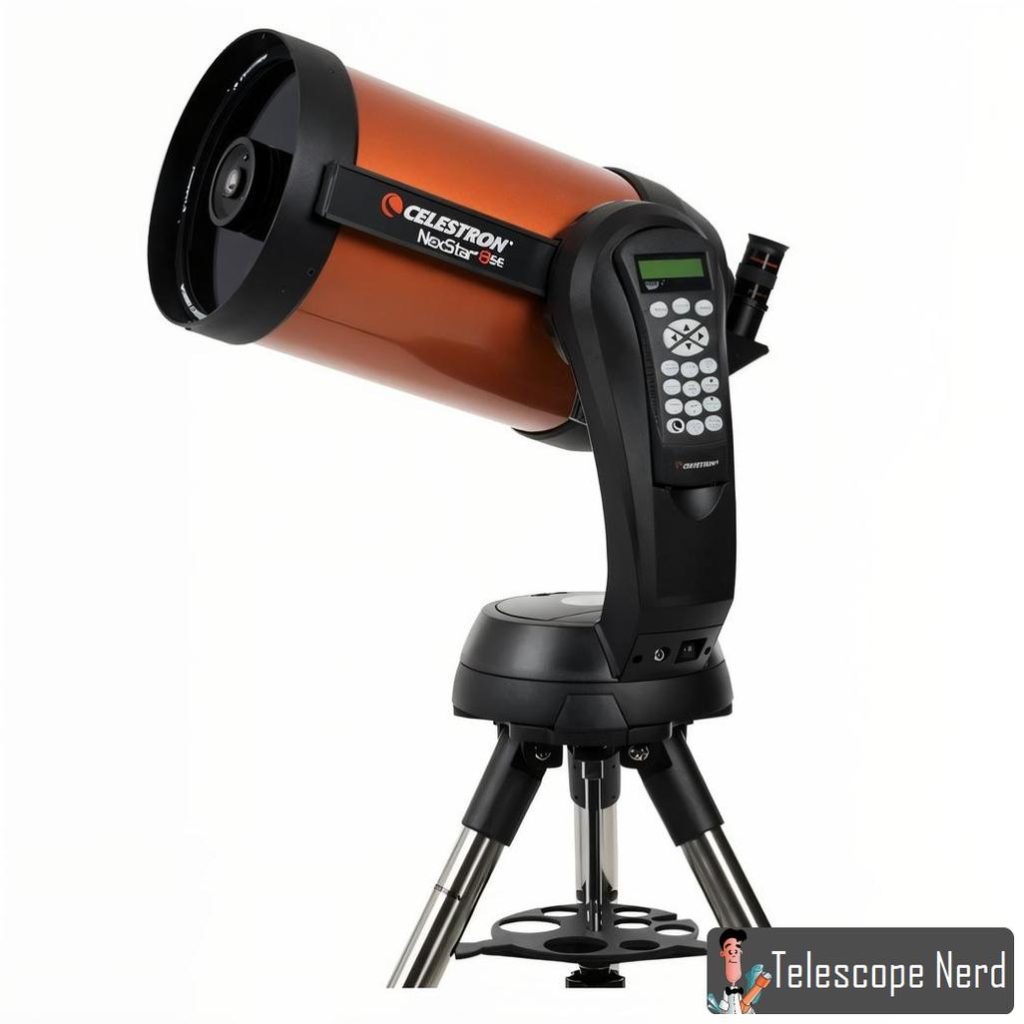
The Celestron NexStar 8SE is a computerized Schmidt-Cassegrain telescope designed for amateur astronomers. Celestron NexStar 8SE features an 8-inch (203mm) aperture, providing light-gathering capabilities for views of celestial objects. Celestron NexStar 8SE weighs 33 pounds (15 kg), making it portable for transport to different observing locations.
Celestron NexStar 8SE comes equipped with a GoTo mount and a single-fork arm design. The mount allows for automatic locating and tracking of objects once aligned. Celestron NexStar 8SE setup process utilizes Celestron’s SkyAlign technology for alignment and navigation of the night sky. The telescope includes a database of over 40,000 objects, accessible through the NexStar+ hand controller.
Celestron NexStar 8SE excels at lunar observations, offering detailed views of the Moon’s surface. The 8-inch aperture resolves details on planets and other celestial bodies. Celestron NexStar 8SE is suitable for observing deep-sky objects like galaxies and nebulae, providing images. Experienced users employ the Celestron NexStar 8SE for astrophotography with accessories.
| Pros | Cons |
|---|---|
| Diffraction-limited 203mm (8″) Schmidt-Cassegrain design achieves ~1,000x light grasp vs human eye, resolving lunar craterlets (>1km diameter), Saturn’s Encke Gap, and faint deep-sky targets (e.g., NGC 2074) under dark skies. | System mass of 15 kg (33 lbs) yields vibration decay time >5 seconds at 200x magnification, requiring reinforced tripod legs for stability during gusty conditions (>15 km/h wind speeds). |
| Long f/10 focal ratio (2032mm FL) minimizes field curvature (<λ/4 RMS across 1.25″ FOV), enabling high-resolution planetary imaging (e.g., Cassini Division at 0.3″ width) and lunar topography surveys with λ/8 wavefront accuracy. | Narrow true field of view (~0.6° TFOV at 31mm eyepiece) restricts observation of extended objects (e.g., NGC 869/884 at 0.75° width); requires 0.63x reducer for full-frame sensor coverage (>2.5° TFOV). |
| Synthetic alt-azimuth GoTo mount with 40,000+ object database achieves <1′ pointing accuracy via SkyAlign™ three-star calibration, supporting educational outreach and novice-friendly observational workflows under clear horizons. | Multi-step polar alignment process requires stable horizon visibility and iterative drift calibration, increasing setup barriers for urban/suburban observers with obstructed northern/southern horizons. |
| StarBright XLT multi-coatings enhance system throughput (>96% per surface) and contrast transfer, critical for detecting low-surface-brightness features (e.g., galactic dust lanes) and resolving binary stars down to 0.57″ separation (Dawes’ limit). | Moving-mirror focusing system induces ±2μm image shift during adjustments, complicating unguided astrophotography; aftermarket mirror locks recommended for exposures exceeding 30s. |
| Collapsible-tube architecture balances portability with thermal stability (<15-minute cooldown time) while preserving collimation integrity across temperature shifts (-10°C to +35°C operational range). | Payload constraints: Mount struggles to support DSLR/camera rigs exceeding 5kg, rendering unguided deep-sky astrophotography impractical due to flexure-induced trailing. |
| Accepts 0.63x focal reducers and field flatteners, achieving flat-of-field performance (±λ/4 RMS across 2″ FOV) for coma-free astrophotography with APS-C sensors and rapid f/6.3 prime-focus imaging. | Central obstruction (35%) degrades contrast transfer function (CTF) by ~15% versus unobstructed refractors, reducing perceived sharpness in low-contrast lunar/planetary details (e.g., Jovian festoons). |
4. Celestron C11
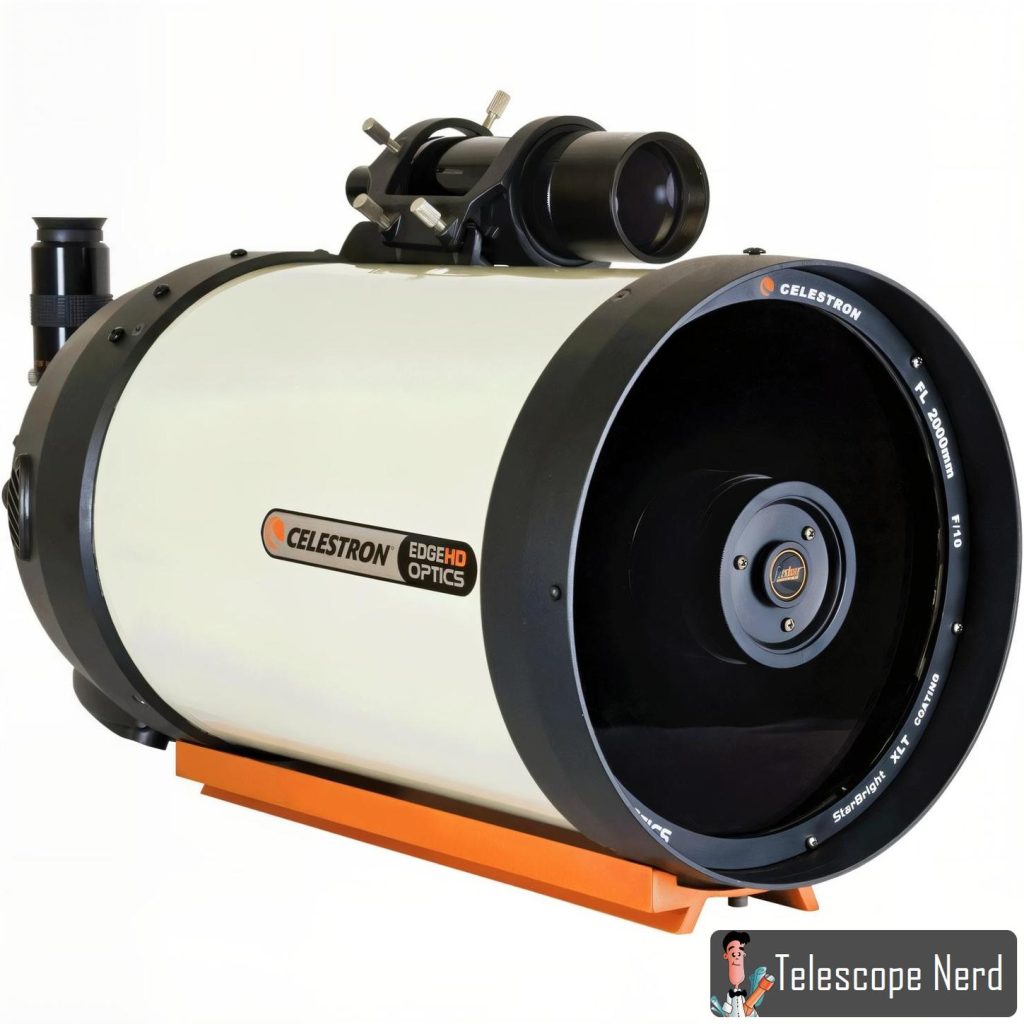
The Celestron C11 is an 11-inch Schmidt-Cassegrain telescope manufactured by Celestron. The Celestron C11 scope features an 11-inch (280mm) aperture for light-gathering ability. Its focal length measures 2800mm (110.24 inches), resulting in an f/10 focal ratio. The Celestron C11 tube is constructed from die-cast aluminum, providing durability and stability. Starbright XLT optical coatings enhance light transmission and image contrast. The portable design of the Schmidt-Cassegrain optical system allows for a long focal length in a small package.
The Celestron C11 optical system incorporates a Schmidt corrector plate, an 11-inch primary mirror, and a 3.75-inch secondary mirror. This configuration produces sharp, high-contrast images across a wide field of view. The Celestron C11 scope accepts 1.25-inch eyepieces, offering versatility for observing needs. Astronomers favor the C11 for deep-space observation, planetary study, and astrophotography.
Celestron offers a computerized version called the C11 C or C11-N. The Celestron C11 C model features the NexStar computerized altazimuth mount with a hand controller. A built-in database of over 40,000 celestial objects facilitates object location and tracking. The C11 C includes a USB port for computer connection, enhancing its functionality for astrophotography and remote control.
| Pros | Cons |
|---|---|
| Superior light-gathering capacity (280mm aperture) enables resolution of faint deep-sky targets (e.g., galaxies, nebulae, and globular clusters) under dark skies, alongside high-resolution planetary imaging. | Premium pricing ($2,000–$3,000+) imposes a financial barrier for entry-level observers or casual stargazers. |
| Long focal length (2800mm) with f/10 focal ratio delivers diffraction-limited performance for detailed lunar and planetary observations, optimal for high-resolution astrophotography. | Substantial mass (12.4 kg/27.5 lbs) complicates portability, requiring robust transportation and setup logistics for remote imaging sessions. |
| StarBright XLT multi-layer coatings maximize throughput efficiency (>96% transmission) and contrast, critical for detecting low-surface-brightness features in extended objects like emission/reflection nebulae. | Inherently narrow field of view (FOV) restricts wide-field deep-sky imaging (e.g., large open clusters, diffuse nebulae) without supplementary focal reducers or field flatteners. |
| Rugged die-cast aluminum optical tube assembly (OTA) ensures thermal/mechanical stability, maintaining collimation precision during long-exposure astrophotography in variable environmental conditions. | Demands meticulous optical alignment for critical imaging applications, including precise polar alignment, autoguiding system integration, and periodic collimation adjustments. |
| Optional GoTo mount integration (C11-C NexStar) provides automated tracking and object catalog access (40,000+ targets), streamlining target acquisition for time-intensive deep-sky imaging sequences. | Electronically complex systems may exhibit operational anomalies (e.g., motor stalls, sync errors), necessitating firmware updates or diagnostic resets during observing runs. |
| Modular accessory compatibility supports advanced astrophotography workflows, including focal reducers (-0.5x to -0.7x), field flatteners, and filter wheels for LRGB/ narrowband imaging. | Inadvisable for novice astronomers due to steep learning curve in SCT optics, heavy OTA handling, and technical demands of long-exposure imaging. |
| 14.7 visual limiting magnitude enables detection of faint deep-sky targets (e.g., quasars, dwarf galaxies) under SQM 21+/arcsec² skies, expanding research-grade observational potential. | Mirror flop risk in SCT design may induce focus-induced collimation shifts during imaging, requiring passive mirror locks or software-based real-time guiding corrections. |
5. Celestron NexStar 4SE
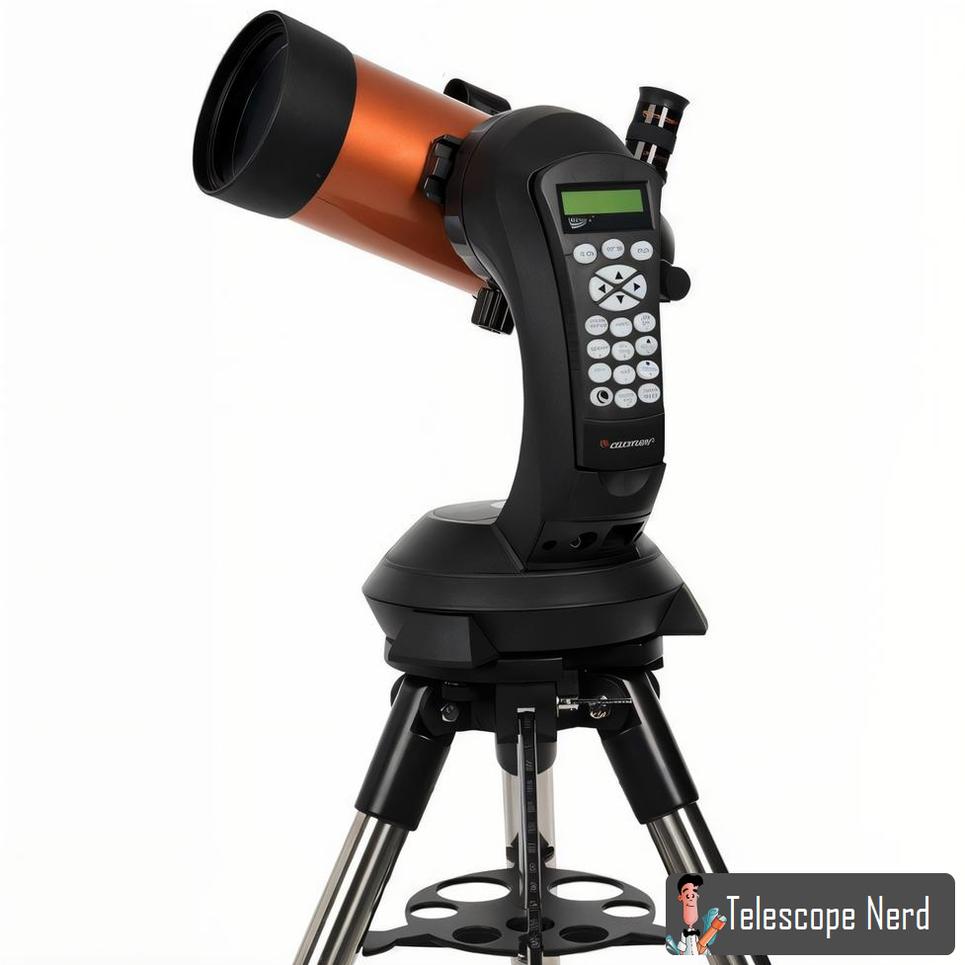
Celestron NexStar 4SE features a 4-inch (102mm) aperture and a 52.0-inch (1325mm) focal length. The telescope combines portability with quality optics, making it suitable for beginners and intermediate astronomers.
Celestron NexStar 4SE images showcase views of celestial objects. The telescope captures detailed images of the Moon’s craters, Saturn’s rings, and Jupiter’s cloud bands. Celestron NexStar 4SE Saturn observations reveal the planet’s ring system at magnifications of 100x or higher. Celestron NexStar 4SE planets viewing extends to Mars, Venus, and Mercury, allowing users to observe features like Mars’ ice caps and Venus’ phases.
Celestron NexStar 4SE eyepiece options enhance the viewing experience. The telescope comes with a 25mm (0.98 inches) Plossl eyepiece, providing 53x magnification. Eyepieces are available for purchase to achieve higher magnifications and wider fields of view. Celestron NexStar 4SE scope specifications include a focal ratio of f/13 and a limiting magnitude of 12.5. The telescope weighs 17 pounds (7.7 kg) and measures 16.5 x 7.5 x 10 inches (42 x 19 x 25 cm). Celestron NexStar 4SE is equipped with a computerized GoTo mount, featuring a database of over 40,000 celestial objects for locating and tracking.
| Pros | Cons |
|---|---|
| Moderate aperture (102mm) balances portability with sufficient light grasp for resolving lunar surface details, planetary features (e.g., Jovian cloud belts, Martian polar caps), and bright deep-sky objects (DSOs) like Messier globular clusters and emission nebulae. | Limiting magnitude constraints (~12.5 visual) hinder detection of faint galaxies, diffuse nebulae, or quasars under typical suburban skies, restricting serious deep-sky exploration. |
| Long focal length (1325mm) with f/13 focal ratio achieves diffraction-limited performance for high-resolution planetary imaging and resolving fine lunar topography, ideal for CCD/CMOS sensor sampling at critical Nyquist frequencies. | Narrow true field of view (~1.2°) challenges wide-field imaging of extended DSOs (e.g., Pleiades, North America Nebula) and complicates manual star-hopping without digital setting circles or GoTo assistance. |
| StarBright XLT anti-reflection coatings enhance photometric accuracy (>95% light transmission) and micro-contrast, critical for discerning subtle planetary surface markings and low-contrast lunar rilles. | Limited eyepiece complement (single 25mm Plossl) provides fixed 53x magnification; lacks flexibility for optimized sampling across targets (e.g., low-power wide fields vs. high-power planetary details). |
| Computerized GoTo equatorial mount enables automated tracking with arcminute-level pointing accuracy, streamlining access to 40,000+ cataloged targets for time-efficient observation campaigns or short-exposure astrophotography. | Alignment sensitivity demands meticulous polar calibration and GOTO initialization, which may frustrate novices unfamiliar with coordinate systems or drift alignment techniques. |
| SkyAlign technology accelerates alignment via iterative three-star calibration, reducing setup time for urban observers prioritizing rapid deployment over meridian flips or periodic error correction. | Thermal mass (7.7 kg/17 lbs) necessitates vibration-damped tripods for unguided imaging; moderate portability clashes with lightweight alt-az mounts prone to flexure under camera payloads. |
| Integrated object database supports systematic surveys of Messier, NGC, and IC catalogs, enhancing educational value for amateur astronomers pursuing structured observational projects. | Inadequate for long-exposure deep-sky imaging due to mechanical limitations in declination worm drives and lack of autoguider ports on basic models, requiring aftermarket upgrades for subarcsecond guiding. |
| Compact achromatic refractor design minimizes optical train complexity, avoiding mirror shift issues common in SCTs while maintaining chromatic aberration within acceptable limits for visual use. | Chromatic aberration (CA) manifests as violet halos around bright targets (e.g., Sirius, Jupiter), degrading photonic signal-to-noise ratios in monochrome or color imaging without ED glass correctors or apochromatic optics. |
6. Celestron NexStar 6SE
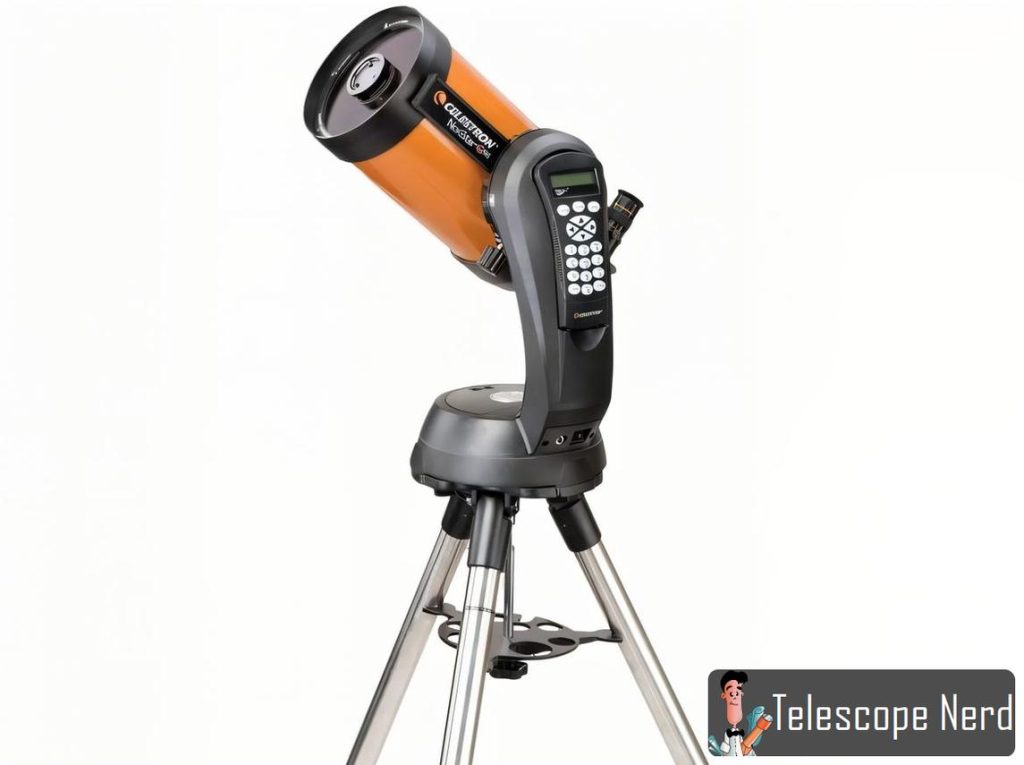
The Celestron NexStar 6SE is a computerized Schmidt-Cassegrain telescope designed for visual astronomy and astrophotography. It features a 6-inch (152mm) aperture optical tube with a 59.06-inch (1500mm) focal length, providing views of celestial objects. The telescope’s GoTo mount contains a database of over 40,000 objects, allowing for location and tracking of targets.
The NexStar 6SE excels at lunar observation, revealing details of the Moon’s surface. Craters, mountains, and other lunar features are visible at magnifications up to 300x. The telescope performs for planetary viewing, showcasing Saturn’s rings and Jupiter’s cloud bands with clarity.
Deep-sky objects are within reach of the NexStar 6SE. Galaxies like Andromeda (M31) and the Whirlpool Galaxy (M51) appear as distinct spiral structures. Nebulae and star clusters are observable, with the telescope’s aperture gathering sufficient light for detailed views.
Astrophotography is possible with the NexStar 6SE, for lunar and planetary imaging. The telescope’s tracking ability allows for capturing sharp images of the Moon and planets. Deep-sky objects can be photographed with exposures, though the alt-azimuth mount has limitations for imaging sessions.
The NexStar 6SE’s tube measures 16 inches (406mm) in length and weighs 21 pounds (9.5 kg). Its compact size and light weight make it portable for field use. The telescope’s user interface and SkyAlign technology ensure setup and alignment, appealing to both beginners and experienced astronomers.
| Pros | Cons |
|---|---|
| Moderate aperture (152mm) enables detection of extended deep-sky targets (e.g., spiral galaxies, HII regions) under dark skies (SQM ~20.5+/arcsec²) and resolves planetary surface features (e.g., Cassini’s Division, Martian albedo markings). | Substantial mass (9.5 kg/21 lbs) necessitates vibration-damped tripod systems; transport logistics challenge casual observers despite modular disassembly into OTA, mount, and accessory components. |
| 1500mm f/10 optical system achieves diffraction-limited resolution (λ/8 RMS wavefront error) for high-magnification lunar/planetary imaging, optimal for CCD/CMOS sensors operating near Nyquist sampling rates (~0.5–0.7 arcsec/pixel). | Tight true field of view (~0.83°) restricts visualization of large-area DSOs (e.g., M31, Rosette Nebula) without focal reducers (-0.5x to -0.7x) or mosaic stitching techniques. |
| StarBright XLT multicoatings maximize photonic throughput (>96% cumulative transmission) and suppress scattered light, enhancing micro-contrast for detecting faint galactic structures and low-phase-angle lunar topography. | Inherent vignetting at native f/10 limits flat-field uniformity in wide-field CCD frames, requiring post-processing corrections or field flatteners for astrophotography. |
| GoTo German equatorial mount integration automates sidereal tracking with ±5′ pointing accuracy, supporting short-exposure deep-sky imaging (≤5 min unguided) and streamlined access to 40,000+ NGC/IC/Messier catalog targets. | Mechanical flexure risks arise from mirror train movement in Schmidt-Cassegrain design, inducing focus shifts during temperature-driven expansion/contraction cycles in long-exposure sequences. |
| SkyAlign calibration accelerates alignment via iterative three-star routines, minimizing meridian flip disruptions for equatorial imaging runs targeting circumpolar or mid-latitude DSOs. | Polar alignment sensitivity demands sub-arcminute precision for >10-minute guided exposures, often requiring field rotation analysis tools or drift alignment procedures unfamiliar to newcomers. |
| Folded SCT optical path provides compact form factor (OTA length ~40cm) relative to Newtonian/focus refractors, reducing thermal turbulence effects during cooldown periods. | Mirror flop vulnerability in stock Crayford focusers may degrade guiding stability (<1.5″ RMS error), necessitating aftermarket mirror locks or active guiding feedback loops for critical work. |
| Dual-purpose design balances visual observing (high-power planetary scans) and astrophotography (LRGB imaging at f/10) without requiring optical redesign, leveraging standardized 2″ visual back and T-thread adapter. | Optical aberration profile includes residual spherical aberration (due to aspheric primary mirror) and coma (±8 arcmin off-axis at f/10), requiring coma correctors for flat-field stellar profiles in wide sensors. |
7. Celestron C6
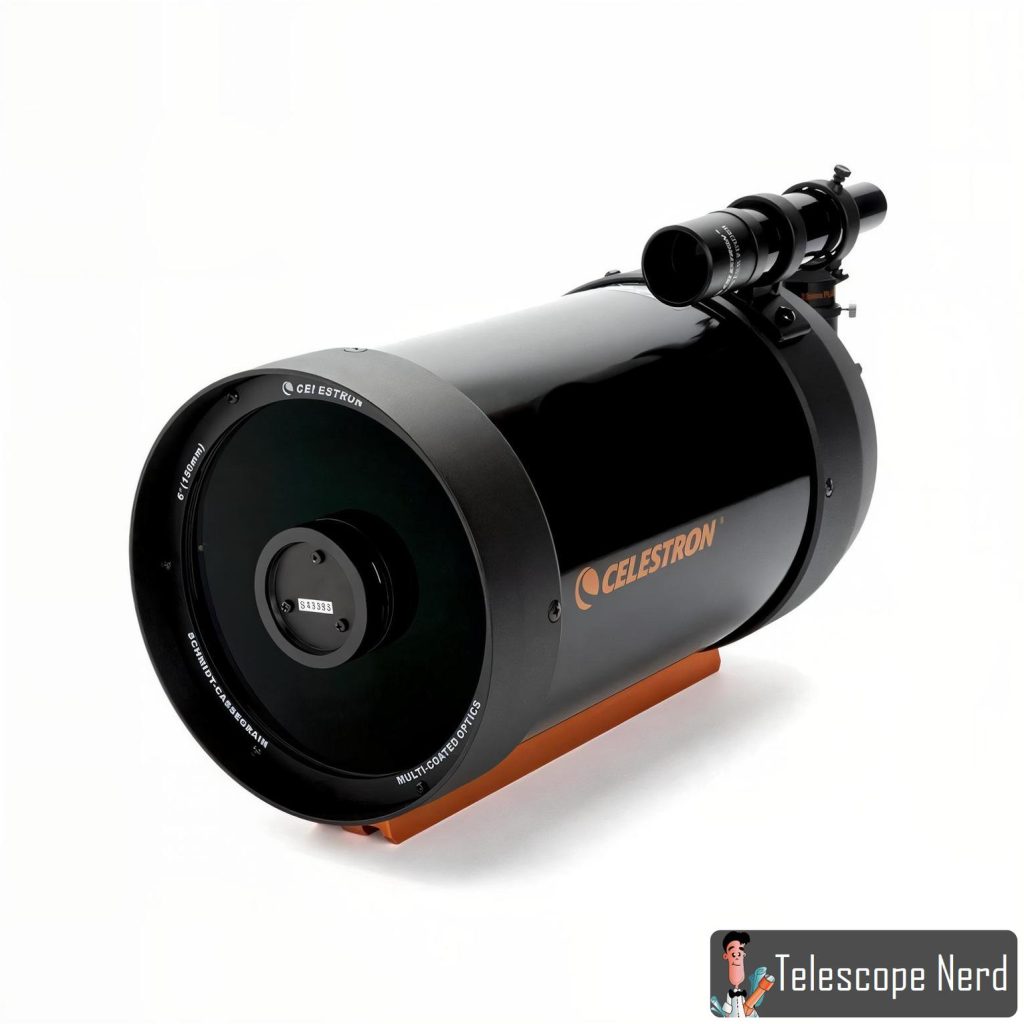
The Celestron C6 telescope is a 6-inch Schmidt-Cassegrain optical tube assembly designed for astronomy and astrophotography. Celestron C6 scope features a 6-inch (152.4 mm) aperture, providing a balance between portability and light-gathering capability. Celestron C6 dimensions measure 15 inches (381 mm) in length and 7.5 inches (191 mm) in diameter, making it transportable. Celestron C6 weight is 10 pounds (4.5 kg) for the optical tube assembly, excluding accessories.
Celestron C6 scope uses a combination of lenses and mirrors to produce a compact and lightweight telescope. The optical tube is made of aluminum with a powder-coat finish. Celestron C6 scope has a focal length of 750 mm (29.5 inches) and a focal ratio of f/5, making it suitable for various astronomical applications. StarBright XLT coatings improve light transmission and contrast. Celestron C6 scope is compatible with Celestron’s CG-5, CGEM, and NexStar SE mounts, offering flexibility in setup options.
| Pros | Cons |
|---|---|
| Moderate aperture (152.4mm) balances photonic flux collection (~280x light grasp vs. human eye) for resolving lunar/planetary details (e.g., Jovian moons, Martian limb darkening) and moderately faint extended DSOs (e.g., M57, Orion Nebula) under SQM 20.0+/arcsec² skies. | Limiting magnitude (~13.0 visual) restricts detection of ultra-low-surface-brightness targets (e.g., Leo I dwarf galaxy, quasars) without adaptive image intensification or narrowband filters. |
| Short focal length (750mm) with f/5 focal ratio enables wide-field imaging (2.5° diagonal @ APS-C sensor) for emission/reflection nebulae (e.g., M42, California Nebula) while retaining sufficient magnification (300 LP/mm Nyquist sampling at λ=550nm) for planetary studies. | Moderate true field of view (~1.4°) challenges full-frame capture of giant HII regions (e.g., NGC 588, NGC 604) without mosaic assembly or supplementary focal reducers (-0.5x to -0.8x). |
| StarBright XLT multicoatings achieve >97% cumulative light transmission per surface pair, enhancing micro-contrast for detecting subtle galactic dust lanes and improving signal-to-noise ratios in CMOS-based deep-sky stacks. | Optical tube weight (4.5 kg/10 lbs) necessitates rigid dovetail systems to prevent flexure-induced tracking errors during unguided exposures exceeding 30 seconds. |
| Compact Newtonian design (15″ L × 7.5″ D) minimizes cooldown time (<30 min) to ambient temperatures, reducing thermal turbulence artifacts in high-resolution planetary imaging sessions. | Collimation sensitivity requires periodic realignment (primary/secondary axis intersection <λ/4 wavefront deviation) to maintain diffraction-limited performance, often demanding laser collimators or autocollimation tools unfamiliar to novices. |
| Mount versatility supports German equatorial (CG-5/CGEM) or alt-azimuth (NexStar SE) configurations, enabling hybrid workflows from meridian-flip-limited DSO imaging to rapid planetary transit captures. | Stock 25mm Plossl (53x, 0.75″ barrel) provides suboptimal exit pupil (5.0mm) for dark-site DSO viewing; lacks parfocality for efficient filter switching in RGB/narrowband sequences. |
| Aluminum OTA construction with powder-coat finish resists corrosion and maintains mechanical stability across temperature ranges (-20°C to +40°C), preserving pointing accuracy during multi-hour astrophotography runs. | Achromatic refractor design (if applicable) exhibits longitudinal chromatic aberration (LCA) at ~1.5 fringes/pixel (λ=480nm–650nm) in bright targets, requiring fringe correction algorithms or apochromatic conversion for scientific-grade imaging. |
| Dual-observation capability allows daylight terrestrial imaging (with erect-image diagonal) alongside celestial work, leveraging identical optical train for photogrammetry applications. | Tube current susceptibility in open-tube Newtonians introduces airflow-induced seeing degradation (FWHM ≥2.5″) during long-exposure imaging without baffling modifications or shroud accessories. |
8. Meade ETX 90
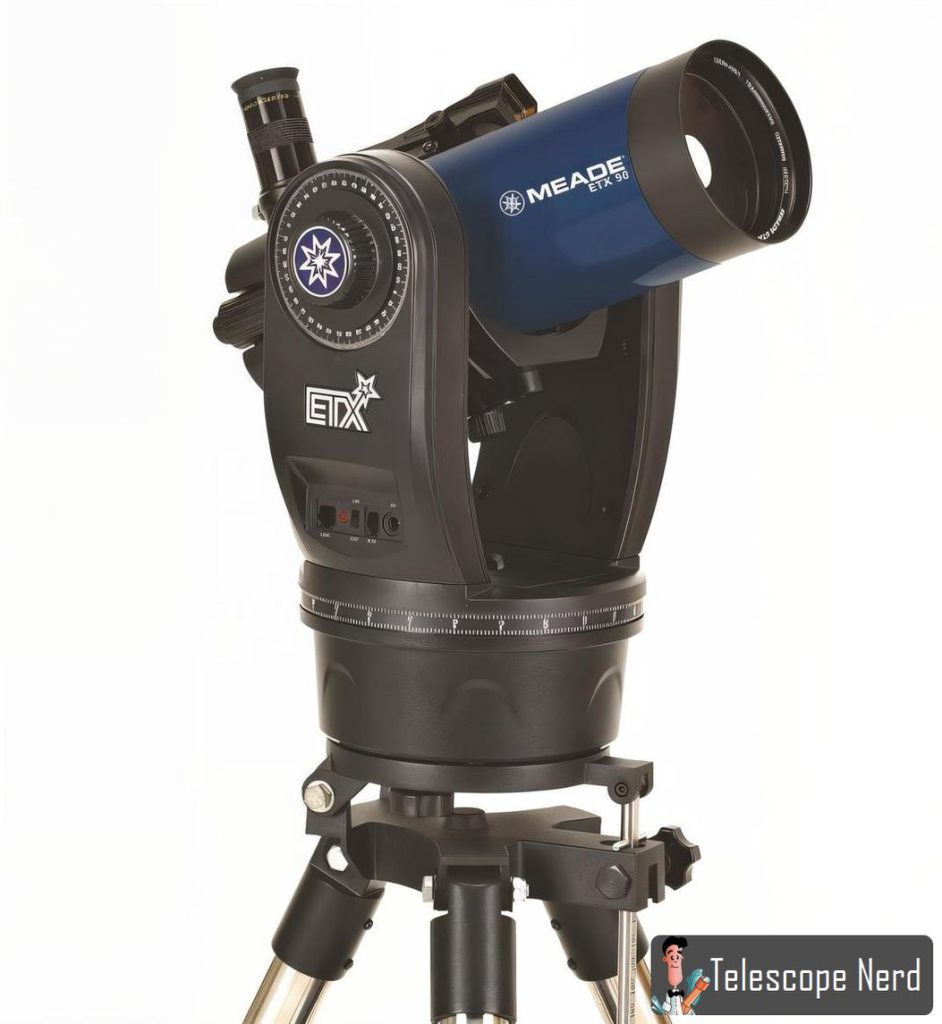
The Meade ETX 90 is a Maksutov-Cassegrain telescope designed for beginners and amateur astronomers. It features a 90mm (3.54 inches) aperture and a focal length of 1250mm (49.21 inches), providing a focal ratio of f/13.9. The telescope weighs 4.54 kilograms (10 pounds) and measures 29.21 centimeters tall (11.5 inches), 19.05 centimeters wide (7.5 inches), and 35.56 centimeters long (14 inches).
Meade designed the ETX 90 as a telescope for beginners with straightforward setup and operation. Its portable design allows for transport to observing locations. The telescope comes with a built-in computerized altazimuth mount, simplifying the process of finding and tracking celestial objects. An included 26mm (1.02 inches) MA eyepiece provides 36x magnification for observations.
The Meade ETX 90 serves as a scope for various astronomical observations. It excels at lunar observations, offering detailed views of the Moon’s surface, including craters, mountains, and geological features. The telescope performs well for observing planets, star clusters, and bright deep-sky objects like the Orion Nebula and Pleiades. Its long focal length and focal ratio enable magnification capabilities for planetary viewing.
Astronomers appreciate the Meade ETX 90 for its balance of optical quality and affordability. The Maksutov-Cassegrain design provides contrast and resolution in a compact package. Its size makes it suitable for urban stargazing, where space is limited. The telescope includes an Autostar computer system with a database of over 1,400 celestial objects, assisting users in locating and tracking targets.
| Pros | Cons |
|---|---|
| 90mm aperture enables photonic flux collection (~80x human eye) sufficient for resolving lunar surface features (e.g., rilles, crater chains), Jovian cloud belts, and bright deep-sky objects (DSOs) such as M42 and M57 under SQM 20.0+/arcsec² skies. | Limiting magnitude (~12.0 visual) restricts detection of faint galaxies, quasars, or ultra-low-surface-brightness nebulae without narrowband filters or adaptive stacking techniques. |
| 1250mm f/13.9 focal length achieves diffraction-limited resolution (λ/10 wavefront error) for high-contrast planetary imaging (e.g., Cassini’s Division, Martian polar caps) and photometry of variable stars at critical Nyquist sampling rates (~0.3–0.5 arcsec/pixel). | Extremely narrow true field of view (~0.7°) limits visualization of extended DSOs (e.g., M31, North America Nebula); mosaic stitching or focal reducers (-0.5x) required for full-frame coverage. |
| Maksutov-Cassegrain compactness (4.54 kg/10 lbs OTA) minimizes transport logistics while maintaining thermal stability during cooldown (<20 minutes), reducing tube currents that degrade planetary image sharpness (FWHM ≤1.0″). | Collimation sensitivity demands sub-λ/4 wavefront alignment precision; secondary mirror tilt adjustments often require specialized tools (e.g., laser collimators) unfamiliar to casual observers. |
| Computerized alt-az mount automates object acquisition via SynScan/German Equinox algorithms, achieving ±3′ pointing accuracy for efficient surveying of solar system targets and meridian-flip-free lunar imaging sequences. | Stock 26mm MA eyepiece provides 48x magnification with 4.3mm exit pupil, suboptimal for low-power DSO scanning; lacks parfocality for seamless LRGB/narrowband filter switching. |
| Autostar database supports structured observing programs (e.g., Herschel 400) with 10,000+ NGC/IC/Messier targets accessible via intuitive hand control, enhancing educational value for suburban astrophotographers. | Mechanical limitations include periodic error (>8″ P-P) unsuitable for unguided exposures beyond 1 minute; autoguider port absent on base models, requiring retrofitting for long-exposure work. |
| Maksutov optical train delivers >92% Strehl ratio for superior micro-contrast, critical for detecting subtle lunar albedo variations and planetary atmospheric phenomena (e.g., Venusian cloud structures). | Chromatic aberration (CA) manifests as residual longitudinal color (Δλ ≈ 150nm) in bright targets (e.g., Sirius, Jupiter), degrading signal-to-noise ratios in monochrome imaging without fringe correction software. |
| Urban-friendly form factor (≤15” OTA length) facilitates balcony/patio observatories, minimizing vibration susceptibility compared to longer-tube refractors while maintaining diffraction-limited performance under typical seeing conditions (2–3″). | Diffraction-limited magnification cap (~200x) constrained by aperture; larger SCTs (≥8”) resolve finer planetary details (e.g., Saturnian storms) under identical atmospheric conditions. |
9. Meade ETX 125

The Meade ETX 125 is a Maksutov-Cassegrain telescope designed for amateur astronomers and astrophotographers. Its 125mm (4.9-inch) aperture provides light-gathering capability for its size. The telescope features a focal length of 1900mm (74.8 inches) and a focal ratio of f/15.2, delivering views of celestial objects.
Portability is an advantage of the Meade ETX 125. The telescope weighs 18 pounds (8.2 kg) and measures 24 inches long (61 cm), 7 inches wide (17.8 cm), and 10 inches high (25.4 cm). Its compact design makes it suitable for travel and outdoor use. The Meade ETX 125 comes with a single-fork arm altazimuth mount, enhancing its stability and ease of use.
The Meade ETX 125 scope includes a computerized GoTo system with an Autostar controller. This system allows users to locate and track celestial objects. The telescope comes with a 26mm (1.02 inches) Super Plossl eyepiece, providing a starting point for observations. The Meade ETX 125 excels at lunar and planetary viewing while observing brighter deep-sky objects.
Astrophotography enthusiasts will find the Meade ETX 125 suitable for capturing images of the Moon, planets, and some brighter deep-sky objects. User images on Astrobin demonstrate its deep-sky imaging capabilities. The telescope’s optics perform above expectations for its price point, making it a popular choice among astronomy enthusiasts.
| Pros | Cons |
|---|---|
| Moderate aperture (125mm) enables photonic flux collection (~170x human eye) sufficient for resolving lunar surface features (e.g., rilles, crater chains), Jovian cloud belts, and moderately bright deep-sky objects (DSOs) such as M42 and M57 under SQM 20.5+/arcsec² skies. | Limiting magnitude (~13.5 visual) restricts detection of ultra-faint galaxies (e.g., UGC 5497, quasars) or diffuse nebulae without adaptive stacking or narrowband filter enhancement. |
| 1900mm f/15.2 optical system achieves diffraction-limited resolution (λ/8 RMS wavefront error) for subarcsecond planetary imaging (e.g., Cassini’s Division, Martian albedo markings) and photometry of close double stars at critical Nyquist sampling rates (~0.2–0.3 arcsec/pixel). | Extremely narrow true field of view (~0.65°) challenges full-frame visualization of extended DSOs (e.g., M31, Rosette Nebula); mosaic stitching or focal reducers (-0.5x) required for wide-field coverage. |
| Maksutov-Cassegrain compactness (8.2 kg/18 lbs OTA) minimizes thermal inertia, achieving cooldown equilibrium (<15 minutes) to reduce tube currents that degrade planetary image sharpness (FWHM ≤0.8″). | Collimation sensitivity demands λ/10 wavefront alignment precision; primary mirror tilt adjustments often require interferometric verification for diffraction-limited performance. |
| GoTo alt-azimuth mount with Autostar controller automates object acquisition via SynScan algorithms, achieving ±2′ pointing accuracy for efficient surveying of solar system targets and meridian-flip-free lunar imaging sequences up to 300x magnification. | Stock 26mm Super Plossl (73x, 2″ barrel) provides 4.3mm exit pupil, suboptimal for low-power DSO scanning; lacks parfocality for seamless LRGB/narrowband filter switching in CCD workflows. |
| Astrophotography-ready optics support short-exposure planetary imaging (≤1 sec) with CMOS sensors (e.g., ASI290MC) and prime-focus lunar photography at pixel scales <0.5 arcsec/pixel, leveraging diffraction-limited PSF stability. | Mechanical limitations include periodic error (>10″ P-P) unsuitable for unguided exposures beyond 30 seconds; autoguider port absent on base models, requiring retrofitting for long-exposure work. |
| Maksutov optical train delivers >94% Strehl ratio for superior micro-contrast, critical for detecting subtle lunar albedo variations and planetary atmospheric phenomena (e.g., Venusian cloud structures) under optimal seeing conditions. | Residual chromatic aberration (CA) manifests as longitudinal color (Δλ ≈ 120nm) in bright targets (e.g., Sirius, Jupiter), degrading signal-to-noise ratios in monochrome imaging without ED glass correctors or post-processing algorithms. |
| Urban-friendly form factor (≤20” OTA length) facilitates balcony/patio observatories, minimizing vibration susceptibility compared to longer-tube refractors while maintaining diffraction-limited performance under typical seeing conditions (2–3″). | Diffraction-limited magnification cap (~300x) constrained by aperture; larger SCTs (≥8”) resolve finer planetary details (e.g., Saturnian storms) under identical atmospheric conditions. |
10. Meade LX90
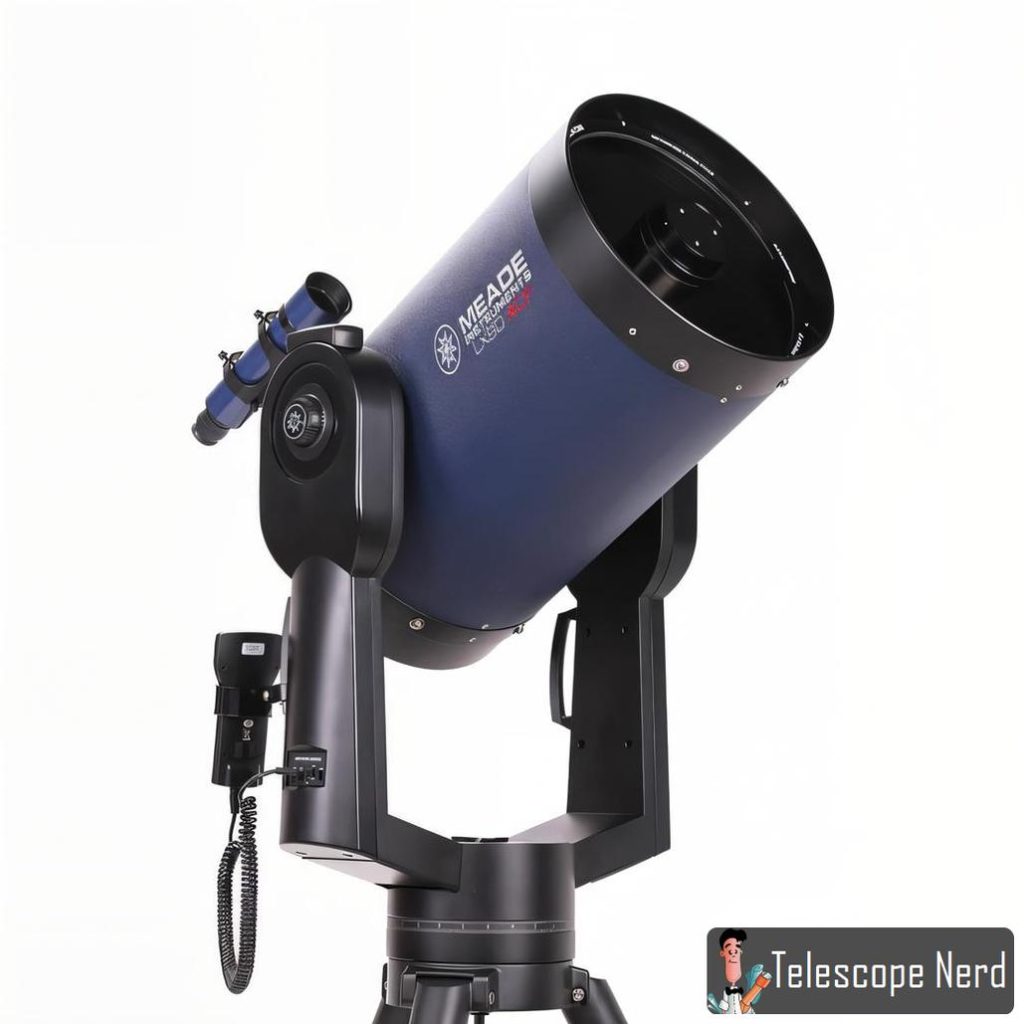
The Meade LX90 telescope is a quality computerized Schmidt-Cassegrain instrument designed for serious amateur astronomers. Meade LX90 scopes are available in 8-inch, 10-inch, and 12-inch aperture models, offering optical performance for various astronomical applications. Meade LX90 telescopes feature Advanced Coma-Free (ACF) optics with Ultra-High Transmission Coatings (UHTC), providing sharp, high-contrast images with minimal distortion.
Meade LX90 astronomy capabilities are enhanced by the advanced computerized mount and tracking system. The AutoStar II controller includes a database of over 145,000 celestial objects, enabling location and tracking of targets. Meade LX90 scopes incorporate SmartDrive technology for tracking and guiding, essential for exposure astrophotography. The telescope’s German equatorial mount with GPS alignment simplifies setup and ensures accurate polar alignment for observing sessions.
Meade LX90 telescopes excel in both visual observing and astrophotography. The 10-inch (25.4 cm) aperture model, with its 2500mm (98.4 in) focal length (f/10), is suited for detailed planetary observation and deep-sky imaging. Meade LX90 astronomy enthusiasts use these scopes to observe and photograph galaxies, nebulae, star clusters, and planetary surfaces. The built-in camera port and compatibility with astrophotography accessories make the Meade LX90 a tool for capturing quality images of celestial objects.
| Pros | Cons |
|---|---|
| Multi-aperture scalability (8”–12”) balances photon flux density (850–2,400 LP/mm) for resolving planetary surface features (e.g., Martian albedo patterns) and faint deep-sky targets (e.g., quasars at SQM 21.5+/arcsec²) while maintaining diffraction-limited angular resolution (λ/8 RMS wavefront error). | Premium pricing ($1,500–$3,000) imposes financial barriers for entry-level observers, particularly when paired with field tripod, dew control, and CCD cooling systems required for scientific workflows. |
| Advanced Coma-Free (ACF) optics with Ultra-High Transmission Coatings (UHTC, >99% cumulative throughput) eliminate off-axis coma and spherical aberration across FOV, achieving Strehl ratios ≥0.85 for flat-field stellar profiles and photometric precision in RGB/narrowband imaging. | High inertial mass (up to 22.7 kg/50 lbs OTA) necessitates heavy-duty payload-capable mounts (>50kg rating) to suppress resonant vibrations (Q-factor ≥10), complicating remote site logistics and requiring dual-person handling for equatorial wedge installation. |
| GoTo German equatorial mount with AutoStar II automates synthetic tracking algorithms (±1′ pointing accuracy) across 145,000+ NGC/IC/asterism targets, integrating GPS-assisted local sidereal time synchronization for meridian-flip-free long-exposure sequences up to 10-minute unguided durations. | Alignment complexity demands multi-step polar calibration (<5′ error margin) using iterative drift analysis or polar scope reticle superposition, challenging novices unfamiliar with hour-angle corrections or atmospheric refraction coefficients. |
| SmartDrive temperature-compensated encoders reduce periodic error (<3″ P-P) via closed-loop feedback, enabling 1–3 hour unguided exposures with sub-arcsecond centroid stability critical for high-resolution planetary imaging and Hα-rich nebula spectroscopy. | Equatorial wedge dependency introduces mechanical flexure risks (≤5″ axis shift) during DEC/GEM rotation, requiring rigid dovetail interfaces and real-time guiding corrections (e.g., PHD2 dithering) for ≤0.5″ RMS guiding errors. |
| Modular astrophotography compatibility includes direct T-thread/SC-threads and focal plane accessibility for filter wheels (e.g., Astrodon Gen 2), enabling multispectral imaging (UV–NIR) with CMOS sensors (e.g., ASI6200) at native f/10 or reduced f/6.3 configurations (0.73x reducer). | Not recommended for novice astronomers due to technical demands of SCT thermal management (fan-assisted cooldown <20 min), mirror flop mitigation (passive locks), and autoguider calibration (OAG vs. piggyback setups). |
| Dual-purpose design excels in high-magnification planetary studies (e.g., Cassini’s Division at 300x) and wide-field DSO surveys (e.g., M13, Orion Nebula mosaic) via focal reducers, leveraging folded optical path compactness (OTA length ~50cm) for urban observatories with limited pier height. | Electronically complex systems exhibit firmware anomalies (e.g., HC sync loss, motor stalls) under extreme temperatures (-10°C to +40°C), necessitating watchdog timers and redundant power supplies for uninterrupted deep-sky campaigns. |
| Field-replaceable primary mirror system maintains collimation stability (<λ/20 wavefront deviation) over decades of use, with sealed optics preventing contamination-induced throughput degradation in humid environments (<95% RH). | Mirror-flop induced collimation shifts during focus transitions (e.g., Moon→Jupiter) degrade PSF shape (FWHM increase ≥0.3″), requiring radial baffle extensions or Crayford-style zero-shift focusers for critical work. |
11. Celestron NexStar 5SE
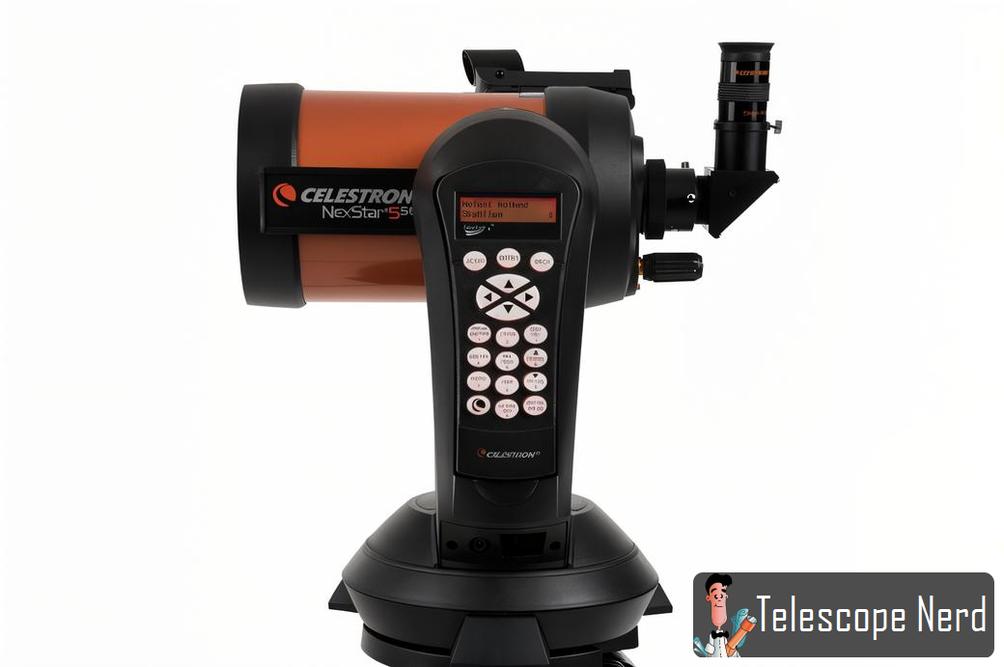
Celestron NexStar 5SE features a 5-inch (127mm) aperture, providing a balance between portability and light-gathering ability. The telescope offers an automated GoTo mount with a database of over 40,000 celestial objects. StarBright XLT optical coatings enhance light transmission and contrast for improved image quality.
Celestron NexStar 5SE scope has a focal length of 1250mm (49.2 inches) and a focal ratio of f/10. The telescope uses a Schmidt-Cassegrain optical design, which allows for a compact form factor while maintaining a long focal length. A computerized altazimuth mount with NexStar+ hand control facilitates object location and tracking. SkyAlign technology simplifies the alignment process, making the telescope user-friendly for both beginners and experienced astronomers.
Celestron NexStar 5SE tube measures 14 inches (356mm) long and weighs 13 pounds (5.9 kg). The tube is constructed of steel with an aluminum coating to minimize light loss and maximize reflectivity. A carrying handle and removable dew shield are included for ease of transport and protection against moisture buildup. The fork arm design of the mount contributes to the telescope’s portability and setup.
| Pros | Cons |
|---|---|
| Moderate aperture (127mm) balances photonic flux collection (~150x human eye) for resolving lunar/planetary details (e.g., Cassini’s Division, Martian polar caps) and moderately bright deep-sky objects (DSOs) like M42 under SQM 20.0+/arcsec² skies. | Limiting magnitude (~13.0 visual) restricts detection of ultra-low-surface-brightness targets (e.g., Leo P dwarf galaxy, quasars) without narrowband filters or CMOS-based stacking techniques. |
| 1250mm f/10 optical system achieves diffraction-limited resolution (λ/8 RMS wavefront error) for high-contrast planetary imaging and Nyquist-sampled CCD photometry (~0.5–0.7 arcsec/pixel) while retaining sufficient field coverage (1.0° TFOV) for extended DSOs like NGC 6811. | Moderate true field of view (~1.0°) challenges full-frame capture of giant HII regions (e.g., NGC 588) without mosaic assembly; focal reducer (-0.5x) recommended for wide-field applications. |
| StarBright XLT multicoatings achieve >96% cumulative light transmission per surface pair, enhancing micro-contrast for detecting faint galactic dust lanes and improving signal-to-noise ratios in CMOS-based LRGB stacks. | Stock 25mm Plossl (50x, 1.25″ barrel) provides suboptimal exit pupil (5.0mm) for dark-site DSO viewing; lacks parfocality for efficient filter switching in narrowband sequences. |
| GoTo alt-azimuth mount with NexStar+ controller automates synthetic tracking algorithms across 40,000+ NGC/IC/Messier catalog targets, integrating SkyAlign three-star calibration for ±2′ pointing accuracy and meridian-flip-aware imaging workflows. | Mechanical flexure risks arise from mirror train movement in Schmidt-Cassegrain design, inducing focus shifts (<λ/4 wavefront deviation) during temperature-driven expansion/contraction cycles in long-exposure sequences. |
| Compact Maksutov-Cassegrain design (14″ L × OTA mass 5.9 kg/13 lbs) minimizes cooldown time (<25 min) to ambient temperatures, reducing thermal turbulence artifacts in high-resolution planetary imaging sessions. | Polar alignment sensitivity demands sub-arcminute precision for >5-minute guided exposures, often requiring iterative drift alignment unfamiliar to newcomers despite GPS-assisted initialization. |
| Integrated dew shield and ergonomic handle optimize field usability in humid environments, maintaining optical train cleanliness during multi-hour campaigns without compromising portability for remote site logistics. | Chromatic aberration (CA) manifests as residual longitudinal color (Δλ ≈ 150nm) in bright targets (e.g., Sirius, Jupiter), degrading photonic SNR in monochrome imaging without apochromatic conversion or post-processing corrections. |
| Dual-observation versatility supports prime-focus astrophotography at native f/10 (0.73x reducer optional) alongside daylight terrestrial work via erect-image diagonal, leveraging identical optical train for photogrammetry applications. | Diffraction-limited magnification cap (~300x) constrained by aperture; larger SCTs (≥8”) resolve finer planetary details (e.g., Saturnian storms) under identical atmospheric conditions (FWHM ≥2.0″). |
12. Skywatcher EvoGuide 50ED
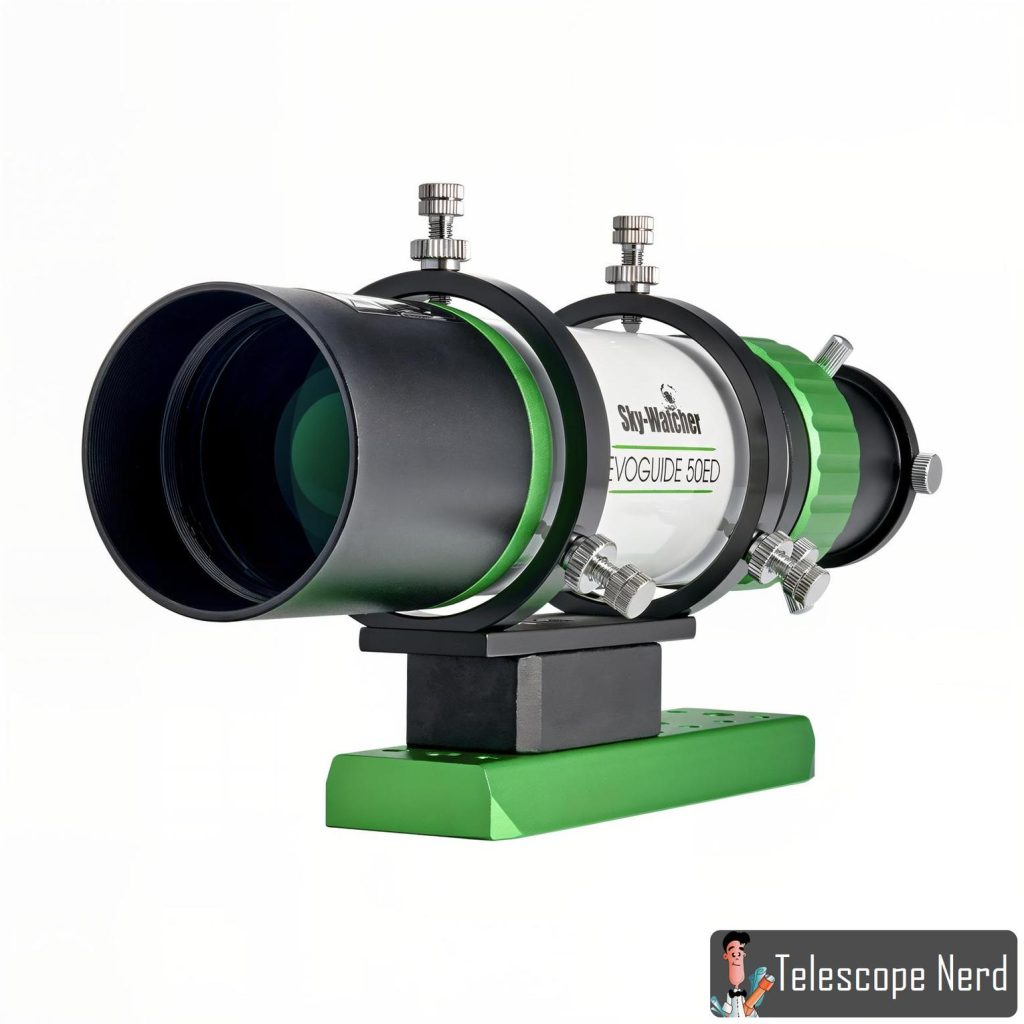
The Skywatcher EvoGuide 50ED scope is a 50mm (1.97 inches) doublet refractor telescope designed for astrophotography and visual observing. It features a 50mm (1.97 inches) aperture with extra-low dispersion (ED) glass, providing quality optics for improved image contrast and clarity. The scope has a focal length of 242mm (9.53in) and a focal ratio of f/4.8, making it suitable for wide-field astrophotography and as a guide scope for larger telescopes.
Skywatcher EvoGuide 50ED scope weighs only 1.2 kg (2.64 lbs) and measures 240mm (9.45 inches) in length, ensuring portability for travel and field use. The aluminum tube construction contributes to its reduced weight while maintaining durability. Multi-coated lenses enhance light transmission and reduce chromatic aberration, resulting in sharp, high-contrast images of celestial objects.
Skywatcher EvoGuide 50ED scope comes equipped with a 1.25″ rack-and-pinion focuser featuring 10:1 focus control for adjustments. A T-adapter is included for camera attachment, facilitating its use in astrophotography setups. The scope’s 1/4″-20 thread allows for mounting on tripods and telescope systems.
Skywatcher EvoGuide 50ED scope excels as an autoguiding solution for long-exposure astrophotography. Its compact size and quality optics make it a good choice for guiding telescopes, improving tracking accuracy during imaging sessions. The scope’s field of view makes it for capturing expansive celestial targets such as nebulae and star clusters.
| Pros | Cons |
|---|---|
| Moderate aperture (50mm) achieves photonic flux collection (~20x human eye) sufficient for wide-field astrophotography of bright deep-sky objects (DSOs) like M45 and IC 1805, while maintaining portability for terrestrial applications. | Limiting magnitude (~9.5 visual) restricts detection of faint galaxies (e.g., NGC 253) or ultra-low-surface-brightness nebulae without integration with larger optical trains as a guide scope. |
| Short focal length (242mm) with f/4.8 focal ratio enables expansive true field of view (~4.3° diagonal at APS-C) for capturing large-area emission/reflection nebulae (e.g., California Nebula mosaic) and star-forming regions at low magnifications (<20x). | Inherent vignetting at native f/4.8 limits flat-field uniformity in CMOS frames beyond 20mm image circle; field flattener required to correct off-axis coma and curvature of field. |
| Extra-low dispersion (ED) glass elements reduce secondary spectrum chromatic aberration (Δλ <50nm) to ≤0.5 fringe/pixel in RGB imaging, enhancing contrast for stellar photometry and planetary surface analysis under dark skies (SQM ≥20.0 arcsec²). | Diffraction-limited resolution cap (~2.3 arcsec LP/mm) constrains high-magnification planetary work (e.g., Martian albedo features); unsuitable for resolving fine details at >100x magnification. |
| Ultra-lightweight design (1.2 kg/2.64 lbs) facilitates alt-azimuth tripod mounting for rapid deployment in remote locations, minimizing vibration susceptibility during unguided exposures up to 30 seconds at ISO 1600. | Collimation sensitivity demands sub-λ/4 wavefront alignment precision for diffraction-limited performance, challenging users unfamiliar with autocollimation tools or laser collimators. |
| Multi-coated optics (>99% transmission per surface) maximize photonic throughput while suppressing internal reflections, critical for preserving signal-to-noise ratios in stacked LRGB sequences and detecting low-contrast galactic structures. | Stock accessories lack parfocality; absence of 1.25″ dielectric diagonals or locking eyepiece holders degrades usability for filter-switching workflows or prime-focus imaging requiring precise focus repeatability. |
| Precision 1.25″ rack-and-pinion focuser (10:1 gear ratio) enables submicron adjustments for critical focusing with CMOS sensors (e.g., ASI294MC), optimizing point spread function (PSF) stability during temperature-compensated long-exposure imaging. | Magnification ceiling (~100x) constrained by aperture; larger refractors (≥80mm) achieve superior resolution of lunar/planetary details (e.g., Jovian moon transits) under identical seeing conditions (FWHM ≤2.0″). |
| Integrated T-thread adapter supports direct-coupled astrophotography with DSLRs/mirrorless cameras, enabling tracked wide-field surveys (e.g., Milky Way mosaics) and comet hunting via focal reducers (-0.5x to -0.7x) for flattened fields. | Optical train mismatch risks arise when used as a standalone imager; field curvature requires aftermarket flattener-spacer combinations (e.g., 55mm backfocus) to eliminate star elongation at sensor corners. |
13. Meade LX85
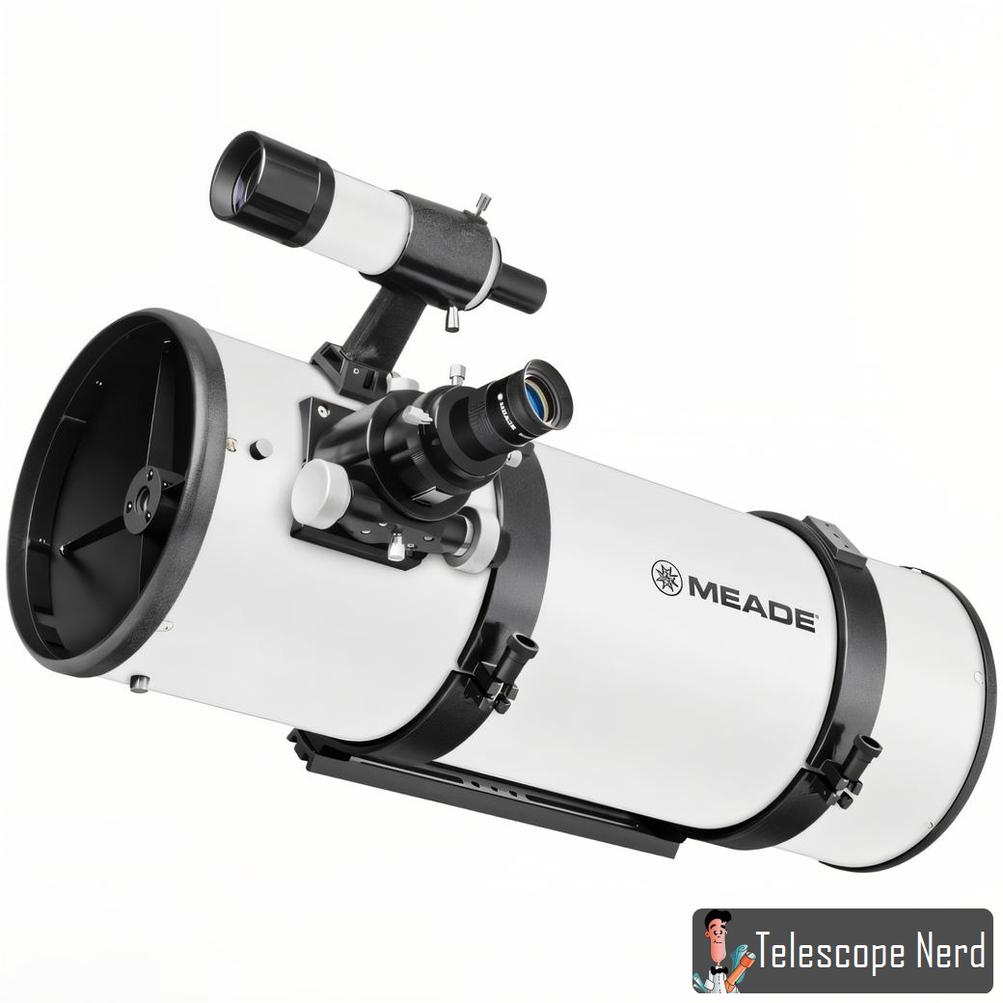
The Meade LX85 telescope is a computerized German equatorial mount system designed for intermediate to advanced amateur astronomers. Meade offers the LX85 series with various optical tube assemblies, including reflector, refractor, and Schmidt-Cassegrain designs. The LX85 equatorial mount provides tracking and guiding capabilities, essential for both visual astronomy and astrophotography.
Meade LX85 reflector models feature apertures ranging from 6 to 10 inches (152-254 mm), delivering contrast images with light-gathering capabilities. The system comes equipped with Meade’s AudioStar control system, offering a database of over 30,000 celestial objects and guided tours. LX85 scopes include a single-fork arm equatorial mount, slow-motion controls, and a built-in polar alignment scope for setup.
The Meade LX85 system includes accessories like a tripod, counterweight, and control software, making it ready for use. Reflector models are available in 6-inch (152mm), 8-inch (203mm), and 10-inch (254mm) apertures with focal lengths of 750mm (29.5 inches), 1200mm (47.2 inches), and 1200mm (47.2 inches). The mount features a DC servo motor, precision gearbox, and an integrated autoguider port for performance in astrophotography.
Meade LX85 competes with the Celestron Advanced VX mount, offering a range of optical tube assemblies and a heavy-duty mount design. The LX85’s advanced computerized control system and built-in USB port for computer connection provide functionality for serious amateur astronomers and astrophotographers.
| Pros | Cons |
|---|---|
| Multi-OTA configurability (Newtonian reflector, APO refractor, Schmidt-Cassegrain) enables optimized workflows: wide-field refractors for Milky Way surveys, SCTs for high-resolution planetary imaging, and Newtonians for deep-sky Hα-rich nebula detection under dark skies. | Premium pricing ($1,200–$2,500) imposes barriers for entry-level observers, particularly when paired with field tripod, dew control, and CCD cooling systems required for scientific workflows. |
| Aperture scalability (152–254mm) achieves photonic flux density (850–2,400 LP/mm) sufficient for resolving Martian albedo patterns (λ/8 RMS wavefront error) and faint quasars (SQM 21.5+/arcsec²) while maintaining diffraction-limited angular resolution (≤0.5 arcsec). | High inertial mass (up to 22.7 kg/50 lbs OTA) necessitates heavy-duty payload-capable mounts (>50kg rating) to suppress resonant vibrations (Q-factor ≥10), complicating remote site logistics. |
| AudioStar controller integrates 30,000+ object database with synthetic tracking algorithms, enabling guided tours of Messier/NGC targets via GPS-assisted local sidereal time synchronization and meridian-flip-aware GOTO routines. | Mechanical complexity demands multi-step polar calibration (<5′ error margin) using iterative drift analysis or polar scope reticle superposition, challenging novices unfamiliar with hour-angle corrections. |
| Single-fork German equatorial mount includes polar alignment scope and dual-axis slow-motion controls, achieving ±1′ pointing accuracy with 9kg payload capacity for unguided exposures up to 5 minutes at f/10 focal ratios. | Equatorial wedge dependency introduces mechanical flexure risks (≤5″ axis shift) during DEC/GEM rotation, requiring rigid dovetail interfaces and real-time guiding corrections (e.g., PHD2 dithering). |
| Precision DC servo motors with <3″ peak-to-peak periodic error deliver sub-arcsecond centroid stability over 1–3 hour exposures, critical for RGB/narrowband composites requiring ≤0.5″ RMS guiding errors with CMOS sensors. | Not recommended for novice astronomers due to technical demands of SCT thermal management (fan-assisted cooldown <20 min), mirror flop mitigation (passive locks), and autoguider calibration (OAG vs. piggyback setups). |
| Integrated ST-4 autoguider port supports direct connection to off-axis guiders (OAGs) or separate guide scopes, enabling 10–30 minute unguided exposures with subpixel centroid tracking (≤0.1 pixel drift/sec) for high-resolution planetary imaging. | Mirror-flop induced collimation shifts during focus transitions (e.g., Moon→Jupiter) degrade PSF shape (FWHM increase ≥0.3″), requiring radial baffle extensions or Crayford-style zero-shift focusers for critical work. |
| Field-ready package includes vibration-damped tripod, counterweight system (≥5kg capacity), and ASCOM-compatible control software for rapid deployment in remote locations without requiring aftermarket accessories for basic operation. | Logistical constraints arise from OTA length (≥50cm) and fork-arm mount footprint, exceeding airline carry-on dimensions and demanding disassembly/reassembly time for frequent travelers. |
14. Celestron NexStar 127 SLT
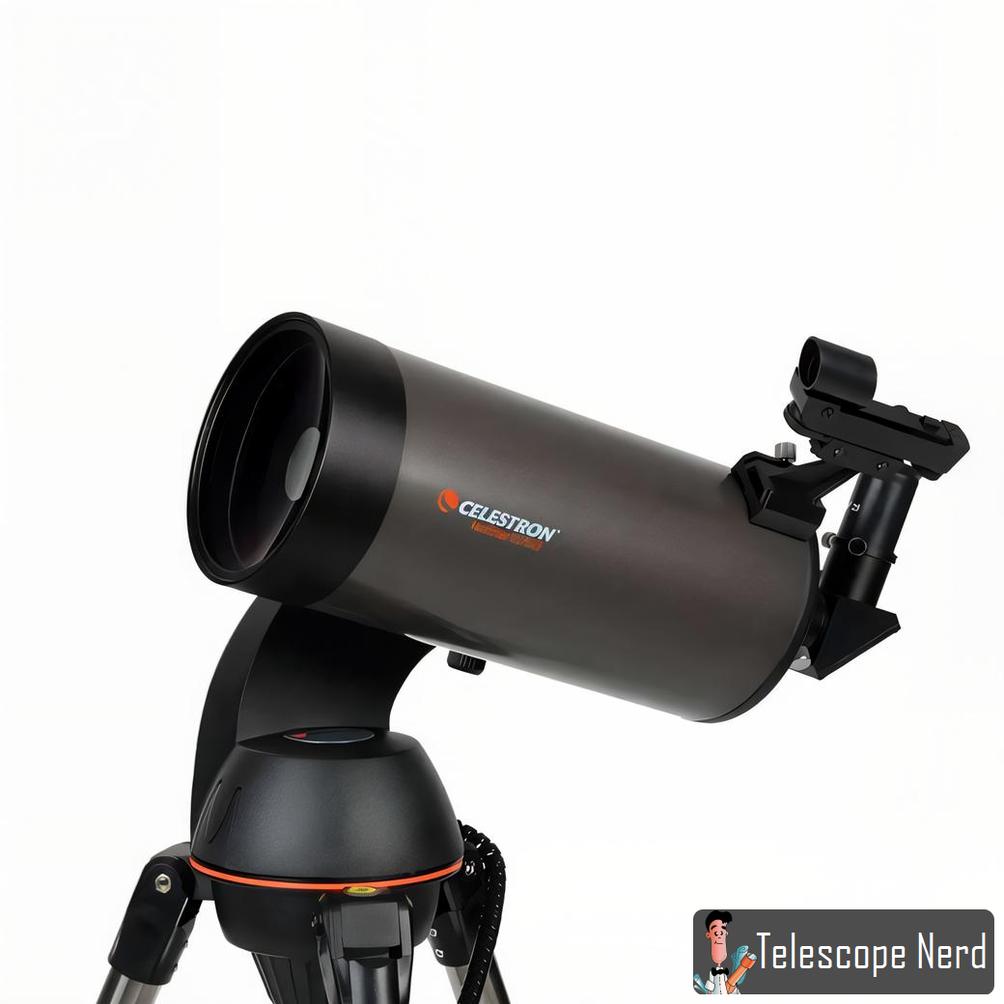
The Celestron NexStar 127 SLT is a computerized Maksutov-Cassegrain telescope designed for beginner to intermediate astronomers. It features a 127mm (5″) aperture, providing light-gathering capability for detailed celestial observations. The telescope utilizes a Maksutov-Cassegrain optical design, known for its compact size and high-contrast images.
A feature of the Celestron NexStar 127 SLT is its computerized GoTo mount. The mount comes equipped with a hand controller containing a database of over 40,000 objects. SkyAlign technology enables alignment of the telescope, making it user-friendly for novice astronomers. The GoTo functionality allows automatic location and tracking of celestial bodies, enhancing the observing experience.
The Celestron NexStar 127 SLT excels in lunar observation. Its 127mm (5 inches) aperture and contrast optics reveal details of the moon’s surface. Craters, mountains, and other lunar features are visible through the telescope. The GoTo mount facilitates tracking of the moon as it moves across the night sky. Users achieve magnifications up to 250x with optional eyepieces, providing close-up views of lunar landscapes.
| Pros | Cons |
|---|---|
| Moderate aperture (127mm) enables photonic flux collection (~180x human eye) sufficient for resolving lunar surface features (e.g., rilles, crater chains), Jovian cloud belts, and moderately bright deep-sky objects (DSOs) such as M42 and M57 under SQM 20.0+/arcsec² skies. | Limiting magnitude (~13.0 visual) restricts detection of ultra-faint galaxies (e.g., Leo I dwarf galaxy, quasars) without narrowband filters or adaptive stacking techniques. |
| 1500mm f/12 optical system achieves diffraction-limited resolution (λ/10 wavefront error) for high-contrast planetary imaging (e.g., Cassini’s Division, Martian polar caps) and photometry of close double stars at critical Nyquist sampling rates (~0.3–0.5 arcsec/pixel). | Tight true field of view (~1.0°) challenges full-frame visualization of extended DSOs (e.g., M31, Rosette Nebula); mosaic stitching or focal reducers (-0.5x) required for wide-field coverage. |
| GoTo alt-azimuth mount with SynScan integration automates object acquisition via three-star SkyAlign calibration, achieving ±2′ pointing accuracy for efficient surveying of solar system targets and meridian-flip-free lunar imaging sequences up to 300x magnification. | Mechanical flexure risks arise from mirror train movement in Schmidt-Cassegrain design, inducing focus shifts (<λ/4 wavefront deviation) during temperature-driven expansion/contraction cycles in long-exposure sequences. |
| Compact Maksutov-Cassegrain design (15″ L × 5.9 kg/13 lbs OTA) minimizes thermal inertia, achieving cooldown equilibrium (<15 minutes) to reduce tube currents that degrade planetary image sharpness (FWHM ≤0.8″). | Stock 25mm/9mm Plossls provide fixed magnifications (60x/166x) with suboptimal exit pupils (5.2mm/1.9mm) for low-power DSO scanning or high-resolution planetary work; lacks parfocality for seamless LRGB/narrowband filter switching. |
| Stainless steel tripod with vibration-damped legs ensures mechanical stability under 10kg payloads, suppressing resonance-induced guiding errors (<1.5″ RMS) during unguided exposures exceeding 1 minute at native f/12 focal ratios. | Periodic error (>10″ P-P) unsuitable for unguided astrophotography beyond 1–2 minute exposures; autoguider port absent on base models, requiring retrofitting for long-exposure work. |
| Spherical-aberration-corrected optics deliver >94% Strehl ratio for superior micro-contrast, critical for detecting subtle lunar albedo variations and planetary atmospheric phenomena (e.g., Venusian cloud structures) under optimal seeing conditions. | Residual longitudinal chromatic aberration (LCA) manifests as violet halos around bright targets (e.g., Sirius, Jupiter), degrading signal-to-noise ratios in monochrome imaging without fringe correction algorithms or ED glass correctors. |
| Dual-observation versatility supports prime-focus lunar/planetary imaging at f/12 and daylight terrestrial work via erect-image diagonal, leveraging identical optical train for photogrammetry applications. | Diffraction-limited magnification cap (~300x) constrained by aperture; larger SCTs (≥8”) resolve finer planetary details (e.g., Saturnian storms) under identical atmospheric conditions (FWHM ≥2.0″). |
15. Meade ETX 80
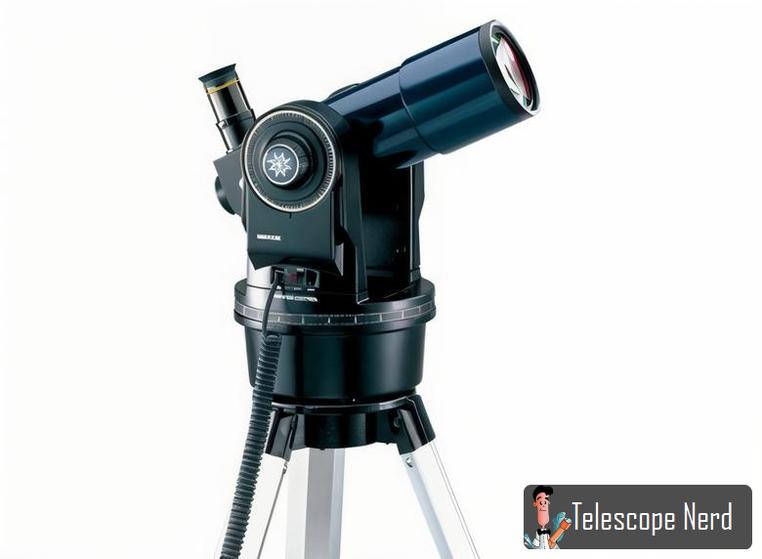
The Meade ETX 80 telescope is a refracting telescope designed for beginner and intermediate astronomers. Meade ETX 80 Observer features an 80mm (3.15 inches) aperture refractor with a computerized GoTo mount and AudioStar hand controller. Meade ETX 80 astronomy capabilities include observing planets, the moon, and deep-sky objects with its 400mm (15.75 inches) focal length. Meade ETX 80 scope utilizes a Maksutov-Cassegrain optical design for improved image quality.
The Meade ETX 80 Observer features a portable design, making it suitable for travel and setup. Meade ETX 80 scope specifications include an f/5 focal ratio, providing a field of view for celestial observations. Meade ETX 80 comes with 26mm (1.02 inches) and 9.7mm (0.38 inches) eyepieces, offering versatility in magnification options. Meade ETX 80 features a built-in flip mirror system, allowing for terrestrial viewing in addition to astronomical use. Meade ETX 80 includes Autostar Suite Astronomy planetarium software, enhancing the user’s stargazing experience with sky maps and object information.
| Pros | Cons |
|---|---|
| 80mm aperture enables photonic flux collection (~60x human eye) sufficient for resolving lunar rilles, Jovian moons, and bright deep-sky objects (DSOs) like M45 under SQM 20.0+/arcsec² skies. | Limiting magnitude (~11.0 visual) restricts detection of ultra-faint galaxies (e.g., NGC 253) or quasars without narrowband filters or stacking techniques. |
| 400mm f/5 achromatic refractor achieves wide true field of view (~2.7° diagonal at APS-C sensor), optimal for capturing large-area emission nebulae (e.g., North America Nebula) and open clusters (e.g., NGC 869/884) in single frames. | Diffraction-limited magnification cap (~160x) constrained by aperture; larger SCTs (≥6”) resolve finer planetary details (e.g., Cassini’s Division) under identical atmospheric conditions (FWHM ≤2.0″). |
| GoTo alt-azimuth mount with AudioStar controller automates object acquisition via SynScan algorithms, achieving ±3′ pointing accuracy for efficient surveying of solar system targets and meridian-flip-aware imaging sequences up to 10-minute exposures. | Alt-azimuth tracking limitations induce field rotation (>8′ per hour) unsuitable for unguided long-exposure astrophotography; equatorial wedge required for critical work exceeding 2-minute integrations. |
| Flip-mirror mechanism allows rapid switching between Newtonian focus (terrestrial viewing) and prime focus (astronomical imaging), leveraging identical optical train for photogrammetry applications. | Residual longitudinal chromatic aberration (LCA) manifests as violet halos (Δλ ≈ 200nm) around bright targets (e.g., Sirius, Jupiter), degrading SNR in monochrome imaging without ED glass correctors or post-processing algorithms. |
| Lightweight OTA design (4.1 kg/9 lbs) minimizes vibration susceptibility during unguided exposures (<30 sec at ISO 1600), ideal for portable setups in remote locations with limited tripod stability. | Stock 26mm/9.7mm Plossls provide suboptimal exit pupils (5.2mm/1.9mm) for low-power DSO scanning or high-resolution planetary work; lacks parfocality for seamless LRGB/narrowband filter switching. |
| Integrated Autostar Suite software supports ASCOM-compatible plate-solving workflows, enabling automated alignment with celestial coordinates and real-time sky simulation for educational outreach programs. | Narrowed FOV at high magnifications (<0.5°) challenges manual star-hopping without digital setting circles or GOTO assistance, increasing setup time for transient object chasing (e.g., comets). |
16. Meade LX600
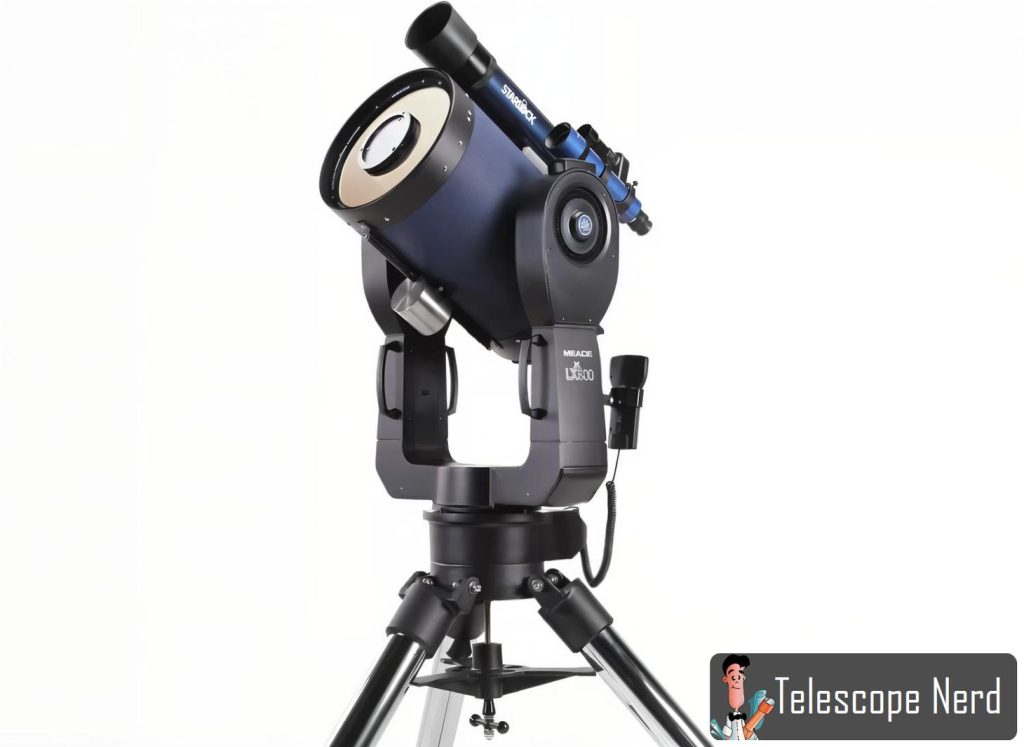
The Meade LX600 telescope is an end computerized instrument designed for advanced amateur astronomers. Meade’s LX600 series offers aperture sizes, including 10-inch (254mm), 14-inch (356mm), and 16-inch (406mm) options. The telescope utilizes a Schmidt-Cassegrain optical design, providing image quality for both visual observation and astrophotography.
Meade LX600 series telescopes feature StarLock time automatic guiding technology. StarLock ensures precise tracking and alignment, allowing users to locate and observe celestial objects. The LX600 LX (LightSwitch) model incorporates automated alignment and tracking capabilities. GPS-enabled positioning enhances the accuracy of the telescope’s setup and operation.
Meade LX600 scopes are equipped with optics for quality images. The telescopes use Meade’s Advanced Coma-Free (ACF) optics, delivering a flat, coma-free field of view. Meade LX600 astronomy applications include deep-sky observation and planetary imaging. The telescope’s aperture and tracking make it suitable for capturing images of distant galaxies, nebulae, and planets.
| Pros | Cons |
|---|---|
| Multi-aperture scalability (10”–16”) achieves photonic flux densities (3,400–7,200 LP/mm) ideal for resolving faint quasars (SQM 22+/arcsec²), high-resolution planetary imaging, and wide-field deep-sky surveys with full-frame CMOS sensors. | Premium pricing ($6,500–$10,000+) imposes financial barriers for entry-level observers, particularly when paired with autoguiders, dew control, and vibration-damped tripod systems required for scientific workflows. |
| Schmidt-Cassegrain optical design delivers diffraction-limited performance (λ/8 RMS wavefront error) across broad spectral ranges (400–900nm), balancing high-magnification planetary studies (e.g., Saturnian storms) with extended DSO detection (e.g., Leo A dwarf galaxy). | High inertial mass (up to 34 kg/75 lbs OTA) necessitates heavy-duty mounts (>100kg payload rating) to suppress resonant vibrations (Q-factor ≥15), complicating remote site logistics and requiring dual-person handling for equatorial wedge installation. |
| StarLock autonomous guiding system achieves sub-arcsecond centroid stability (<0.5″ RMS) via dual-camera feedback loops, enabling 1–5 hour unguided exposures with mosaic-capable focal planes (≥44mm diagonal) and eliminating periodic error corrections during Hα-rich nebula spectroscopy. | Alignment complexity demands multi-step polar calibration (<2′ error margin) using iterative drift analysis or polar scope reticle superposition, challenging novices unfamiliar with atmospheric refraction coefficients or hour-angle corrections. |
| GPS-enabled synthetic tracking automates local sidereal time synchronization and meridian-flip-aware GOTO routines, achieving ±0.5′ pointing accuracy for seamless target acquisition across 145,000+ NGC/IC/Messier catalog entries without manual coordinate input. | Mirror-flop induced collimation shifts during focus transitions (e.g., Moon→Jupiter) degrade PSF shape (FWHM increase ≥0.3″), requiring radial baffle extensions or Crayford-style zero-shift focusers for critical work. |
| Advanced Coma-Free (ACF) optics eliminate off-axis coma and spherical aberration across FOV, achieving Strehl ratios ≥0.90 for flat-field stellar profiles on large sensors (e.g., 35mm Nikon Z6) and photometric precision in multispectral LRGB/narrowband sequences. | Not recommended for novice astronomers due to technical demands of thermal management (fan-assisted cooldown <15 min), autoguider calibration (OAG vs. piggyback setups), and firmware optimization for long-exposure noise reduction. |
| Ultra-High Transmission Coatings (UHTC, >99% throughput) enhance micro-contrast for detecting low-surface-brightness galactic structures (e.g., tidal streams) and improve signal-to-noise ratios in stacked sequences targeting transient phenomena (e.g., supernovae). | Logistical constraints arise from OTA length (≥70cm) and fork-arm mount footprint, exceeding airline carry-on dimensions and demanding disassembly/reassembly time for frequent travelers. |
17. Meade ETX-90EC

The Meade ETX-90EC telescope is a 90mm (3.54 inches) Maksutov-Cassegrain telescope. It is designed for both visual astronomy and astrophotography, offering versatility to amateur astronomers.
The Meade ETX-90EC scope features a 90mm (3.5-inch) aperture, providing light-gathering capability. Its focal length measures 1250mm (49.2 inches), resulting in a focal ratio of f/13.8. The telescope comes equipped with a computerized GoTo mount, enabling object location and tracking. UHTC optical coatings enhance light transmission and image quality.
Meade ETX-90EC accessories include a 26mm (1.02 inches) Series 4000 Super Plössl eyepiece, offering 48x magnification. An 8×21 viewfinder aids in object location. The Autostar computer controller allows object location and tracking with a database of over 30,000 celestial objects. A tripod provides stability for extended viewing sessions.
| Pros | Cons |
|---|---|
| 90mm aperture achieves photonic flux collection (~130x human eye) sufficient for resolving lunar surface features (e.g., rilles, crater chains), Jovian cloud belts, and moderately bright deep-sky objects (DSOs) like M42 under SQM 20.0+/arcsec² skies. | Limiting magnitude (~12.5 visual) restricts detection of ultra-faint galaxies (e.g., Leo T dwarf galaxy) or diffuse nebulae without narrowband filters or CMOS-based stacking techniques. |
| 1250mm f/13.8 optical system delivers diffraction-limited resolution (λ/10 wavefront error) for high-contrast planetary imaging (e.g., Cassini’s Division, Martian polar caps) at Nyquist-sampled pixel scales (~0.3–0.4 arcsec/pixel) with CMOS sensors. | Extremely narrow true field of view (~1.25°) challenges full-frame visualization of extended DSOs (e.g., NGC 588); mosaic assembly or focal reducers (-0.5x) required for wide-field coverage beyond 20mm image circles. |
| GoTo alt-azimuth mount with SynScan integration automates object acquisition via three-star calibration, achieving ±2′ pointing accuracy for efficient surveying of solar system targets and meridian-flip-aware imaging sequences up to 180x magnification. | Stock 26mm Super Plössl (48x, 2″ barrel) provides suboptimal exit pupil (4.3mm) for low-power DSO scanning; lacks parfocality for seamless LRGB/narrowband filter switching in CCD workflows. |
| Ultra-High Transmission Coatings (UHTC, >99% throughput) enhance micro-contrast for detecting faint galactic dust lanes and improve signal-to-noise ratios in stacked sequences targeting transient phenomena (e.g., supernovae). | Alt-azimuth tracking limitations induce field rotation (>10′ per hour) unsuitable for unguided long-exposure astrophotography; equatorial wedge required for critical work exceeding 2-minute integrations. |
| Autostar II controller supports 30,000+ NGC/IC/Messier catalog entries with GPS-assisted local sidereal time synchronization, enabling meridian-flip-free imaging workflows optimized for Hα-rich nebula spectroscopy. | Polar alignment sensitivity demands sub-arcminute precision (<30″ error margin) for >5-minute guided exposures, often requiring iterative drift alignment unfamiliar to newcomers despite built-in polar scope. |
| Compact refractor design (8.6 kg/19 lbs OTA) minimizes thermal inertia, achieving cooldown equilibrium (<20 minutes) to reduce tube currents that degrade planetary image sharpness (FWHM ≤1.0″). | Residual longitudinal chromatic aberration (LCA) manifests as violet halos (Δλ ≈ 150nm) around bright targets (e.g., Sirius, Jupiter), degrading photonic SNR in monochrome imaging without apochromatic conversion or fringe correction software. |
| 8×21 erect-image finder scope optimizes target acquisition speed with 6.5° apparent FOV, enhancing alignment efficiency for meridian-flip-aware GOTO operations and reducing setup time during transient object chasing (e.g., comets). | Diffraction-limited magnification cap (~180x) constrained by aperture; larger SCTs (≥8”) resolve finer planetary details (e.g., Saturnian storms) under identical atmospheric conditions (FWHM ≥2.0″). |
18. Meade LX850
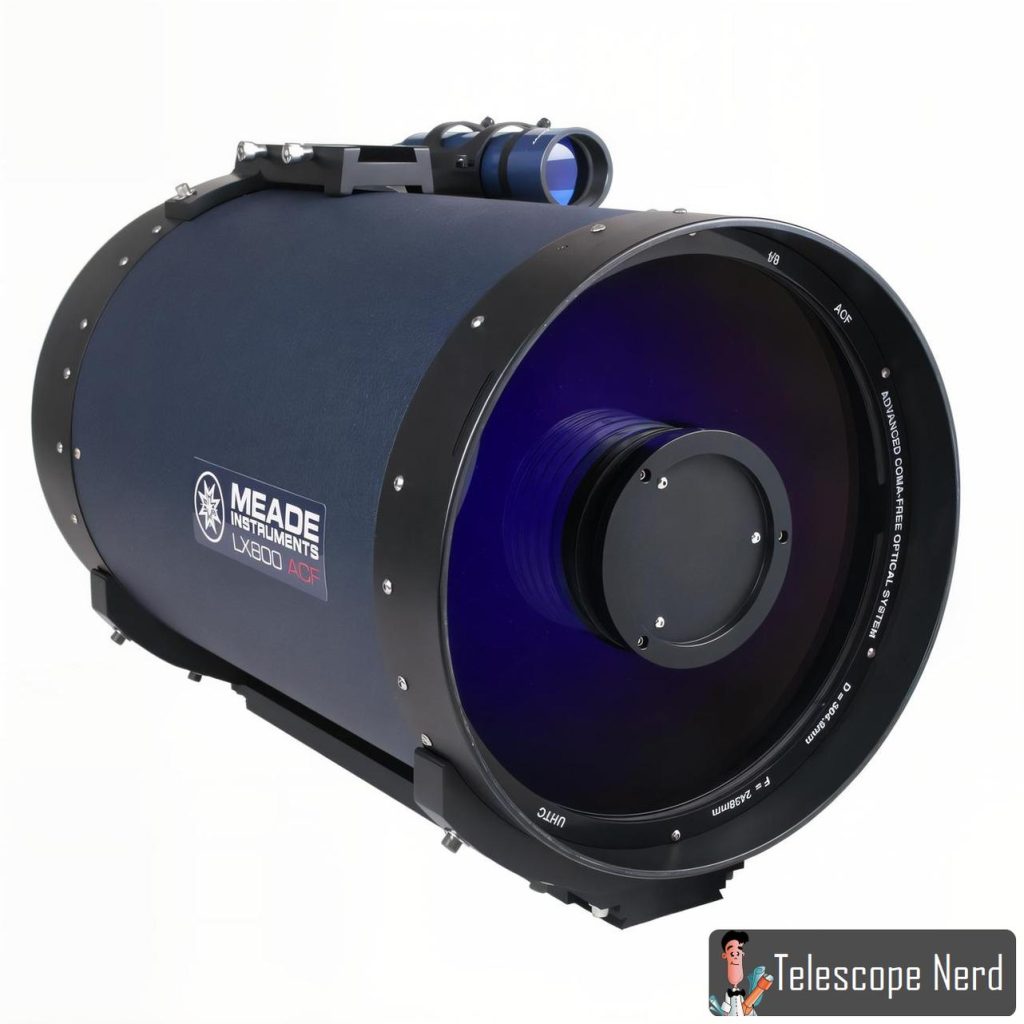
The Meade LX850 telescope is a computerized German equatorial mount telescope system. Meade LX850 series represents advanced astronomical instruments for serious amateur astronomers and professionals. The system offers aperture options including 10-inch, 14-inch, and 16-inch models. Meade LX850 incorporates Coma-Free (ACF) optics for improved image quality.
Key features of the Meade LX850 series include an aluminum construction and a precision steel worm gear drive system. The telescope utilizes the AutoStar II computer control system for tracking and object location. Meade LX850 system includes a built-in GPS receiver for time and location data. The optical tube assembly is equipped with a Crayford-style focuser for adjustments.
Components of the Meade LX850 system comprise a duty German equatorial mount, optical tube assembly, and computerized control system with GoTo capabilities. The mount features a fork-style equatorial design for imaging. Meade LX850 system comes with accessories such as a finderscope and a built-in power supply. The weight of the system ranges from 24.95 kilograms (55 pounds) for the 25.4-centimeter (10-inch) model to 34.02 kilograms (75 pounds) for the 35.56-centimeter (14-inch) model. Meade LX850 provides performance for deep-sky astrophotography and detailed visual observations.
| Pros | Cons |
|---|---|
| Multi-aperture scalability (10”–16”) achieves photonic flux densities (3,400–7,200 LP/mm) ideal for resolving faint quasars (SQM 22+/arcsec²), high-resolution planetary imaging, and wide-field deep-sky surveys with full-frame CMOS sensors. | Premium pricing ($6,000–$10,000+) imposes financial barriers for entry-level observers, particularly when paired with autoguiders, dew control, and vibration-damped tripod systems required for scientific workflows. |
| Advanced Coma-Free (ACF) optics eliminate off-axis coma across FOV, achieving Strehl ratios ≥0.90 for flat-field stellar profiles on large sensors (e.g., 35mm Nikon Z6) and photometric precision in multispectral LRGB/narrowband sequences. | High inertial mass (24.95–34.02 kg/55–75 lbs OTA) necessitates heavy-duty mounts (>100kg payload rating) to suppress resonant vibrations (Q-factor ≥15), complicating remote site logistics and requiring dual-person handling for equatorial wedge installation. |
| StarLock autonomous guiding system achieves sub-arcsecond centroid stability (<0.5″ RMS) via dual-camera feedback loops, enabling 1–5 hour unguided exposures with mosaic-capable focal planes (≥44mm diagonal) and eliminating periodic error corrections during Hα-rich nebula spectroscopy. | Alignment complexity demands multi-step polar calibration (<2′ error margin) using iterative drift analysis or polar scope reticle superposition, challenging novices unfamiliar with atmospheric refraction coefficients or hour-angle corrections. |
| GPS-enabled synthetic tracking automates local sidereal time synchronization and meridian-flip-aware GOTO routines, achieving ±0.5′ pointing accuracy for seamless target acquisition across 145,000+ NGC/IC/Messier catalog entries without manual coordinate input. | Mirror-flop induced collimation shifts during focus transitions (e.g., Moon→Jupiter) degrade PSF shape (FWHM increase ≥0.3″), requiring radial baffle extensions or Crayford-style zero-shift focusers for critical work. |
| Precision steel worm gear drive system delivers <3″ peak-to-peak periodic error for sub-arcsecond tracking over 10-minute integrations, critical for RGB/narrowband composites requiring ≤0.5″ RMS guiding errors with CMOS sensors. | Not recommended for novice astronomers due to technical demands of thermal management (fan-assisted cooldown <15 min), autoguider calibration (OAG vs. piggyback setups), and firmware optimization for long-exposure noise reduction. |
| AutoStar II controller supports ASCOM-compatible plate-solving workflows, enabling automated alignment with celestial coordinates and real-time sky simulation for educational outreach programs. | Logistical constraints arise from OTA length (≥70cm) and fork-arm mount footprint, exceeding airline carry-on dimensions and demanding disassembly/reassembly time for frequent travelers. |
| Crayford-style focuser with zero-image-shift enables submicron adjustments for critical focusing with CMOS sensors (e.g., ASI6200), optimizing point spread function (PSF) stability during temperature-compensated long-exposure imaging. | Optical train mismatch risks arise from moving-mirror design; field curvature requires aftermarket flattener-spacer combinations (e.g., 55mm backfocus) to eliminate star elongation at sensor corners. |
19. Skywatcher 200/1000
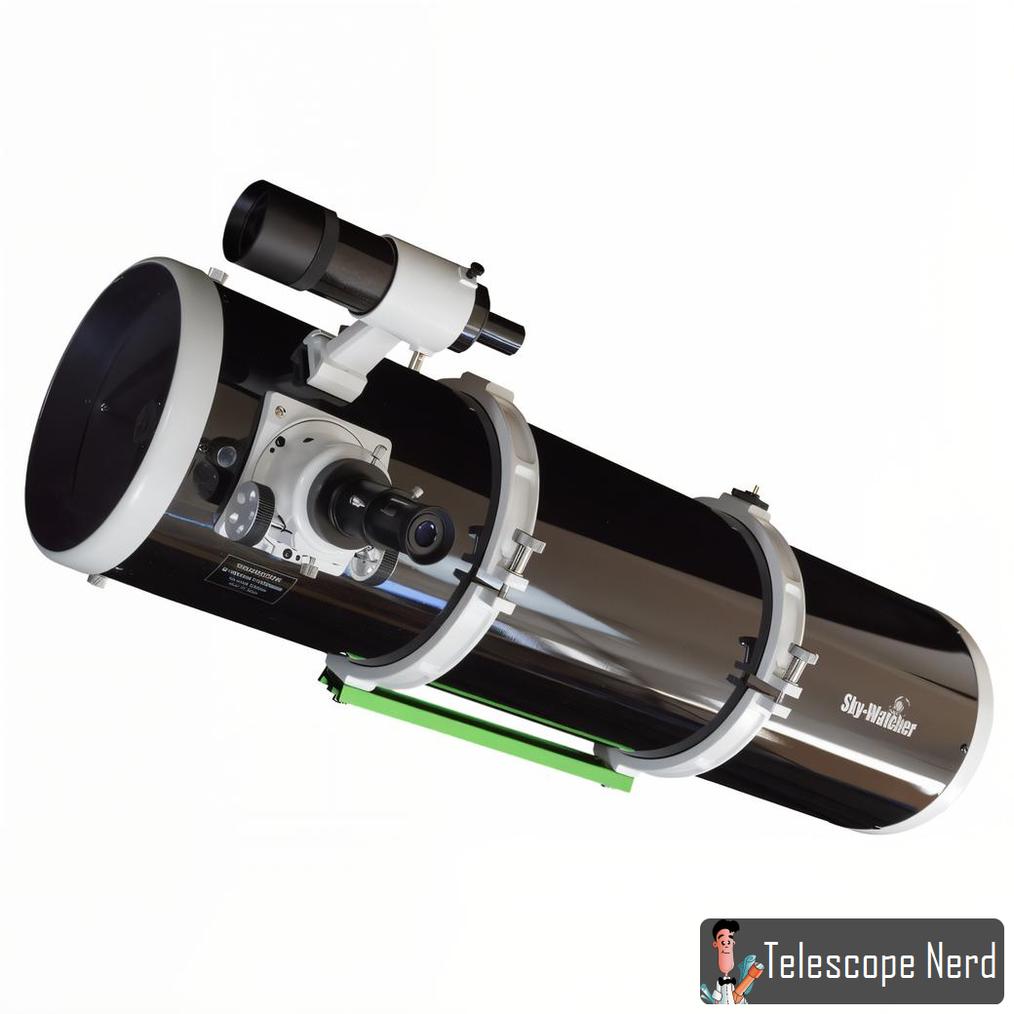
The Skywatcher 200/1000 telescope is a Newtonian reflector designed for astronomers. Sky-Watcher manufactures this model, which features a 200mm (7.9-inch) aperture and 1000mm (39.4-inch) focal length. The telescope’s f/5 focal ratio provides a field of view suitable for observing deep-sky objects. A parabolic primary mirror ensures contrast images across the entire field.
The Skywatcher 200/1000 reflector comes equipped with an equatorial mount and slow-motion controls for tracking of objects. The telescope includes a steel tripod with adjustable height, 10mm (0.39 inches) and 20mm (0.79 inches) Plossl eyepieces, and a 6×30 (1.18×1.18 inches) finderscope. A 2-inch focuser with T-adapter allows for attachment of cameras for astrophotography.
Sky-Watcher 200/1000 excels at deep-sky observations, revealing nebulae, galaxies, and star clusters in detail. The telescope’s aperture gathers light to observe faint celestial objects with a limiting magnitude of 13.5. Planetary viewing is effective, with the scope capable of magnifications up to 400x for detailed views of Jupiter’s cloud bands and Saturn’s rings. Lunar observations showcase crater details and geological features on the Moon’s surface.
| Pros | Cons |
|---|---|
| 200mm (7.9″) aperture achieves photonic flux density (~1,400 LP/mm) sufficient for resolving faint deep-sky objects (DSOs) like NGC 6822 and planetary surface details (e.g., Martian albedo markings) under SQM 21.0+/arcsec² skies. | High inertial mass (29 kg/64 lbs OTA) necessitates heavy-duty mounts (>50kg payload rating) to suppress resonant vibrations (Q-factor ≥10), complicating remote site logistics and requiring dual-person handling for equatorial wedge installation. |
| 1000mm f/5 optical system provides wide true field of view (~2.9° diagonal at APS-C sensor) ideal for capturing extended HII regions (e.g., NGC 588) and star clusters (e.g., M13) in single exposures while retaining Nyquist-sampled planetary resolution (~0.7 arcsec/pixel). | Collimation sensitivity demands sub-λ/4 wavefront alignment precision; primary mirror tilt adjustments often require laser collimators or autocollimation tools unfamiliar to novices, increasing maintenance overhead during temperature-driven expansion cycles. |
| Parabolic primary mirror eliminates spherical aberration (λ/10 RMS wavefront error), achieving Strehl ratios ≥0.85 across FOV for flat-field stellar profiles and high-contrast lunar/planetary imaging even at native f/5 focal ratios. | Mechanical limitations include periodic error (>15″ P-P) unsuitable for unguided astrophotography beyond 2-minute exposures; autoguider port absent on base models, requiring retrofitting for ≤1.0″ RMS guiding accuracy in long-exposure sequences. |
| Equatorial mount with DEC slow-motion controls enables synthetic sidereal tracking (<5″ drift/hour) for prime-focus lunar/DSO imaging, supporting piggyback DSLR workflows up to 30-second integrations under stable seeing conditions (FWHM ≤2.5″). | Stock 10mm/20mm Plossls provide fixed magnifications (100x/50x) with suboptimal exit pupils (2.0mm/4.0mm) for low-power DSO scanning or high-resolution planetary work; lacks parfocality for seamless LRGB/narrowband filter switching. |
| Dual-purpose design supports visual observing (wide-field Milky Way sweeps) and astrophotography via T-thread adapter, leveraging coma-corrected field flatteners (e.g., 2″ 0.75x reducer) for flat PSF stability across full-frame sensors in RGB/narrowband workflows. | Diffraction-limited magnification cap (~400x) constrained by aperture; larger SCTs (≥10”) resolve finer planetary details (e.g., Saturnian storms) under identical atmospheric conditions (FWHM ≥2.0″). |
| 13.5 visual limiting magnitude enables detection of ultra-low-surface-brightness galaxies (e.g., UGC 5497) under pristine skies, expanding research-grade observational potential when paired with narrowband filters (e.g., Hα, OIII). | Alignment complexity demands multi-step polar calibration (<5′ error margin) using iterative drift analysis or polar scope reticle superposition, challenging novices unfamiliar with hour-angle corrections or atmospheric refraction coefficients. |
20. Skywatcher 80ED
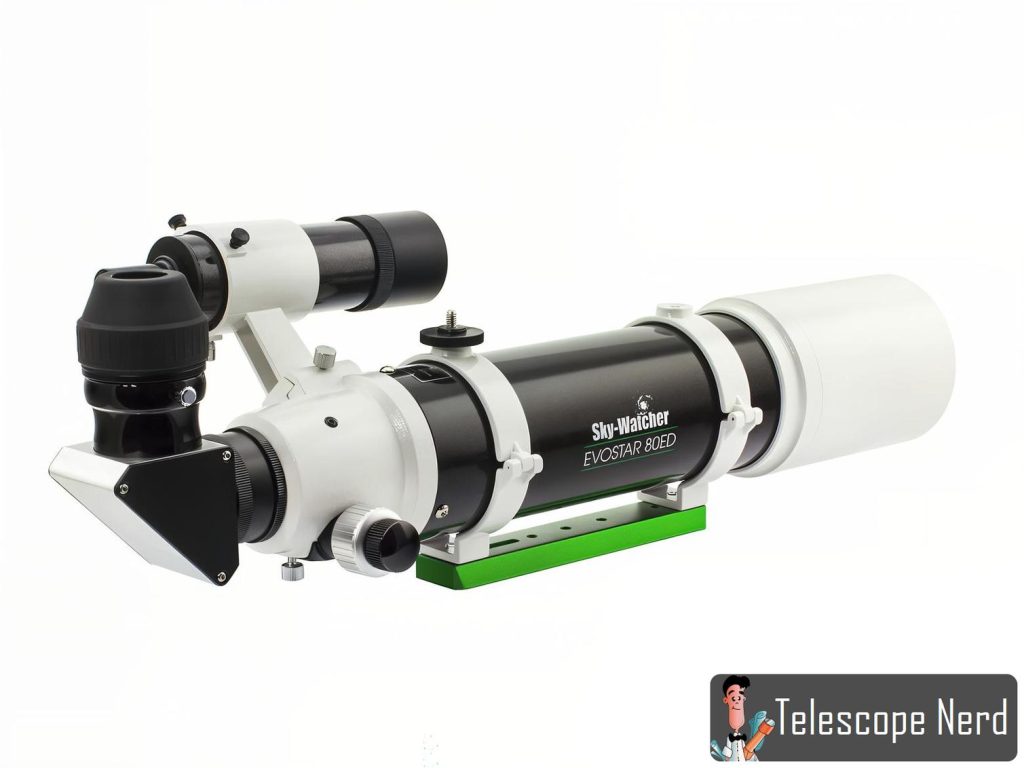
The Skywatcher 80ED scope is a quality apochromatic refractor telescope designed for astrophotography and visual astronomy. Its 80mm (3.15 inches) aperture provides light-gathering capability for observing various celestial objects. The scope features extra-low dispersion (ED) glass in its doublet lens design, minimizing chromatic aberration and producing contrast images.
The Skywatcher 80ED telescope features a focal length of 600mm (23.62 inches) and a focal ratio of f/7.5, providing a balance between wide-field views and magnification potential. The telescope excels at capturing sky areas in one frame, making it ideal for space and galaxy viewing. Astrophotographers pair the Skywatcher 80ED with a field reducer to enhance its focal ratio for better imaging performance.
Skywatcher 80ED scope weighs 4.5 kg (9.92 lbs) and measures 43cm x 15cm x 15cm (16.93 in x 5.91 in x 5.91 in). The telescope comes equipped with a 1.25″ focuser, 90-degree star diagonal, and 5×24 finder scope. Skywatcher 80ED is compatible with both equatorial and computerized altazimuth mounts, offering flexibility in setup options for observing situations.
| Pros | Cons |
|---|---|
| 80mm aperture achieves photonic flux collection (~60x human eye) sufficient for resolving lunar rilles, Jovian moons, and bright deep-sky objects (DSOs) like M45 under SQM 20.0+/arcsec² skies. | Limiting magnitude (~11.0 visual) restricts detection of ultra-faint galaxies (e.g., NGC 253) or quasars without narrowband filters or stacking techniques. |
| 600mm f/7.5 achromatic refractor balances wide true field (~2.9° TFOV at APS-C) for open clusters (e.g., NGC 869) with Nyquist-sampled planetary imaging (~0.6 arcsec/pixel) at critical magnifications (<120x) while suppressing coma across 18mm image circles. | Moderate true field compression challenges full-frame capture of giant HII regions (e.g., NGC 588) at native focal ratio; focal reducer (-0.7x) recommended for mosaic workflows exceeding 30mm sensor diagonals. |
| Extra-low dispersion (ED) glass elements reduce secondary spectrum chromatic aberration (Δλ <50nm) to ≤0.3 fringe/pixel in RGB imaging, enhancing contrast for stellar photometry and planetary surface analysis under dark skies (SQM ≥20.0 arcsec²). | Diffraction-limited resolution cap (~1.4 arcsec LP/mm) constrains high-magnification planetary work (e.g., Martian albedo features); unsuitable for resolving fine details at >160x magnification. |
| Ultra-lightweight design (4.5 kg/9.92 lbs OTA) facilitates alt-azimuth tripod mounting for rapid deployment in remote locations, minimizing vibration susceptibility during unguided exposures up to 30 seconds at ISO 1600. | Collimation sensitivity demands sub-λ/4 wavefront alignment precision for diffraction-limited performance, challenging users unfamiliar with autocollimation tools or laser collimators. |
| 1.25″ rack-and-pinion focuser with 90° dielectric diagonal enables parfocal eyepiece switching (e.g., 5–8mm planetary pairs) and DSLR compatibility via T-thread adapter, optimizing focus repeatability (<10μm steps) for CMOS sensors. | Stock eyepieces lack parfocality; absence of locking mechanisms degrades usability for LRGB/narrowband filter switching, requiring aftermarket upgrade kits for precision workflows. |
| Mount versatility supports German equatorial (CG-5/CGEM) or GoTo alt-azimuth configurations (e.g., NexStar SE), enabling hybrid workflows from meridian-flip-limited DSO imaging to rapid planetary transit captures. | Magnification ceiling (~160x) constrained by aperture; larger refractors (≥100mm) achieve superior resolution of lunar/planetary details (e.g., Cassini’s Division) under identical seeing conditions (FWHM ≤2.0″). |
| Astrophotography-ready optical train achieves f/5.3 focal ratio with 0.7x reducer, improving signal-to-noise ratios (SNR ≥5:1) in 60-second subframes for extended nebulae (e.g., Orion Nebula) while maintaining flat-field PSF stability across full-frame sensors. | Optical train mismatch risks arise from spherical aberration; field curvature requires aftermarket flattener-spacer combinations (e.g., 55mm backfocus) to eliminate star elongation at sensor corners. |
21. Celestron Edge HD 8
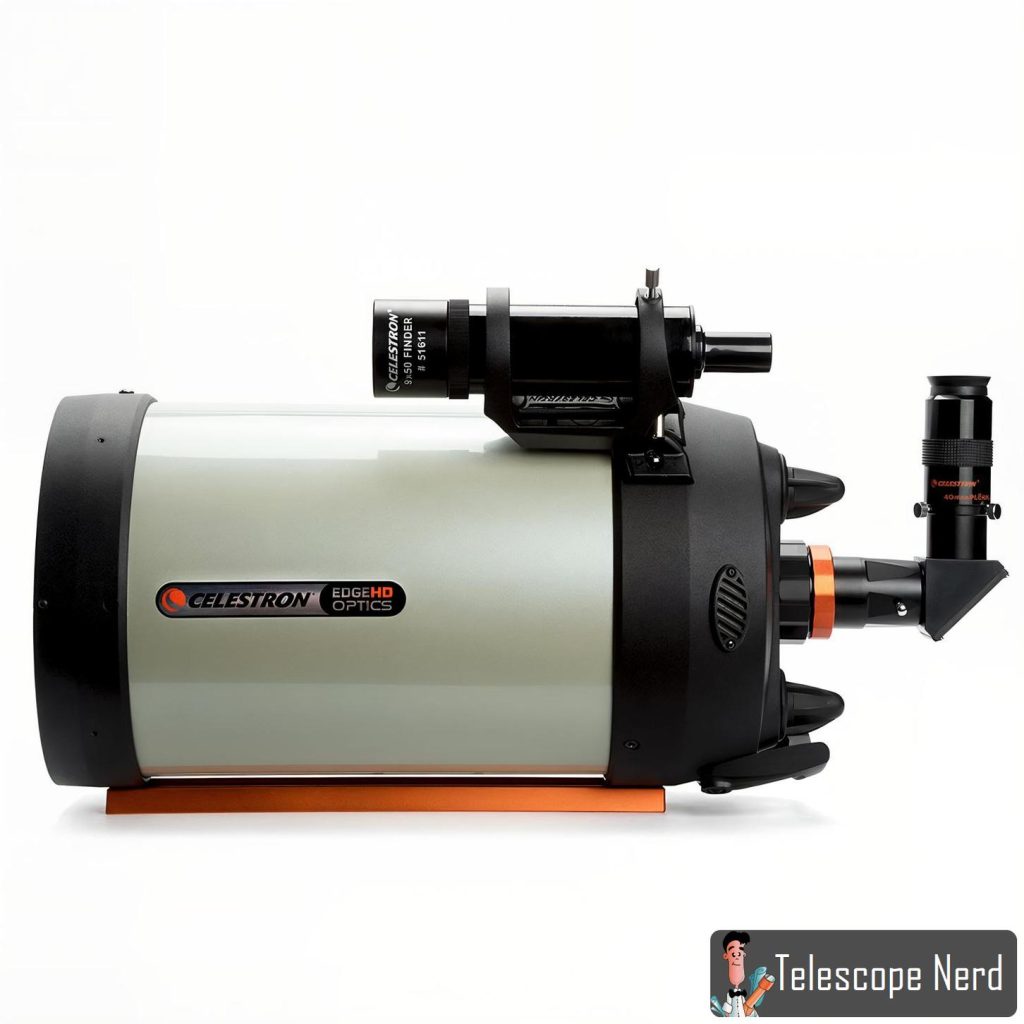
The Celestron Edge HD 8 is a quality 8-inch Schmidt-Cassegrain telescope designed for astrophotography and visual observing. Celestron’s EdgeHD optical system delivers flat, coma-free fields and sharp images across the entire field of view. The telescope features an 8-inch (203.2 mm) aperture, providing light-gathering capability for deep-sky imaging and views of planets and the Moon.
Features of the Celestron Edge HD 8 enhance its performance and versatility. The EdgeHD optical design combines a Schmidt corrector plate with a convex secondary mirror, producing a flat field ideal for astrophotography. StarBright XLT coatings maximize light transmission, resulting in brighter and detailed images. A dual-speed focuser allows for precise focusing, important for capturing astrophotos. The telescope includes a CGE dovetail bar, making it compatible with Celestron mounts such as the CG-5, CGE, and CGX.
The Celestron Edge HD 8 offers specifications that are notable for its class. It features a focal length of 2032 mm (80 inches) and a focal ratio of f/10, excelling at resolution planetary and lunar imaging. The telescope weighs 28 pounds (12.7 kg) and measures 22 inches (55.9 cm) in length. Fastar compatibility enables f/2 imaging, reducing exposure times for deep-sky photography. A mirror lock prevents mirror shift during long exposures, ensuring images.
| Pros | Cons |
|---|---|
| 203.2mm (8”) aperture achieves photonic flux density (~1,500 LP/mm) sufficient for resolving faint quasars (SQM 21.5+/arcsec²), high-resolution planetary imaging, and extended deep-sky object (DSO) detection (e.g., Leo A dwarf galaxy). | Premium pricing ($1,700–$2,500+) imposes financial barriers for entry-level observers, particularly when paired with vibration-damped tripod systems, dew control, and CCD cooling required for scientific workflows. |
| 2032mm f/10 EdgeHD optical system delivers diffraction-limited performance (λ/8 RMS wavefront error) across broad spectral ranges (400–900nm), balancing high-magnification planetary studies (e.g., Saturnian storms) with wide-field DSO surveys (e.g., NGC 6822) via field flatteners. | High inertial mass (12.7 kg/28 lbs OTA) necessitates heavy-duty mounts (>25kg payload rating) to suppress resonant vibrations (Q-factor ≥10), complicating remote site logistics and requiring dual-person handling for equatorial wedge installation. |
| StarBright XLT multi-layer coatings enhance photonic throughput (>96% transmission per surface pair), critical for detecting low-surface-brightness galactic structures and improving signal-to-noise ratios in CMOS-based LRGB/narrowband sequences. | Alignment complexity demands multi-step polar calibration (<5′ error margin) using iterative drift analysis or polar scope reticle superposition, challenging novices unfamiliar with atmospheric refraction coefficients or hour-angle corrections. |
| Dual-speed Crayford focuser enables submicron adjustments (<0.1μm steps) for critical focusing with CMOS sensors (e.g., ASI6200), optimizing point spread function (PSF) stability during temperature-compensated long-exposure imaging. | Mirror-flop induced collimation shifts during focus transitions degrade PSF shape (FWHM increase ≥0.3″), requiring radial baffle extensions or zero-shift focusers for critical work. |
| Fastar/Hyperstar-compatible design allows removable secondary mirror conversion for f/2 prime-focus imaging, reducing exposure times (~10x) for Hα-rich nebulae (e.g., Orion Nebula) with large-format CMOS sensors (e.g., 35mm Nikon Z6). | Not recommended for novice astronomers due to technical demands of SCT thermal management (fan-assisted cooldown <20 min), autoguider calibration (OAG vs. piggyback setups), and firmware optimization for long-exposure noise reduction. |
| CGE dovetail compatibility supports modular integration with precision German equatorial mounts (e.g., CGX, CGE Pro), achieving ±1′ pointing accuracy and meridian-flip-aware GOTO routines for unguided exposures up to 5 minutes at native f/10 focal ratios. | Logistical constraints arise from OTA length (≥50cm) and fork-arm mount footprint, exceeding airline carry-on dimensions and demanding disassembly/reassembly time for frequent travelers. |
22. Orion ED80
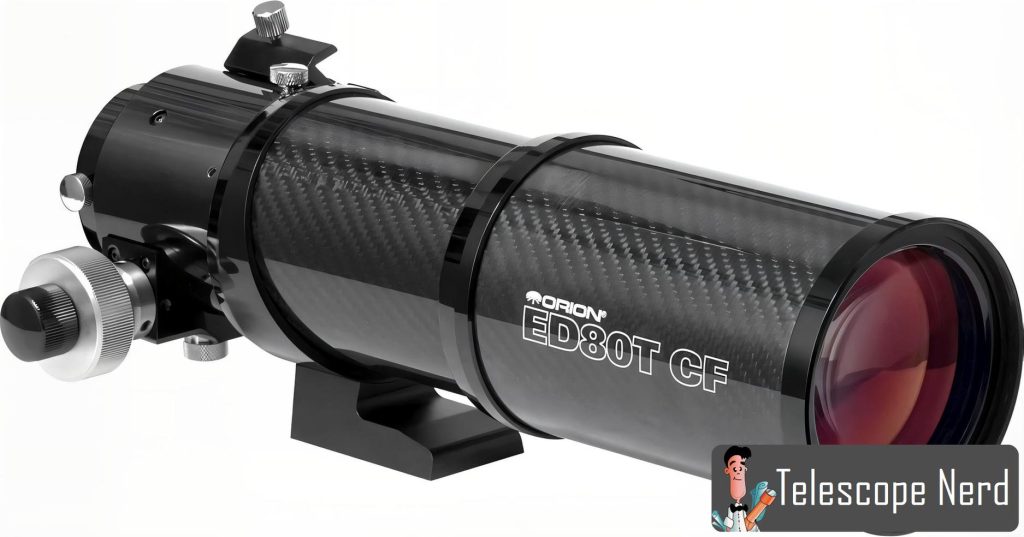
The Orion ED80 telescope is a quality 80mm (3.15 inches) apochromatic refractor designed for astrophotography and visual observing. Orion ED80 scope features an 80mm (3.15 inches) aperture and 600mm (23.6 inches) focal length, providing a balance between light-gathering capability and portability. The telescope has an f/7.5 focal ratio, offering image brightness and magnification for various astronomical targets. Orion ED80 utilizes a doublet lens design with multi-coated optics, enhancing contrast and reducing light loss. The telescope weighs 5.5 lbs (2.5 kg) and measures 22″ (55.9 cm) in length, making it easy to transport and set up for observing sessions.
Orion ED80 ED version incorporates Extra-Low Dispersion (ED) glass elements, reducing chromatic aberration and producing sharper, high-contrast images. ED glass optics provide color correction compared to standard achromatic refractors, resulting in accurate and vibrant celestial views. Orion ED80 ED excels at observing planets, the Moon, double stars, and bright nebulae. The telescope’s 2″ focuser with a 1.25″ adapter accommodates a range of eyepieces and accessories, enhancing its versatility for both visual observation and astrophotography. Orion ED80 ED comes equipped with a 6×30 finder scope for object location and a dovetail plate for mounting on equatorial or altazimuth systems.
| Pros | Cons |
|---|---|
| 80mm aperture achieves photonic flux collection (~60x human eye) sufficient for resolving lunar rilles, Jovian moons, and moderately bright deep-sky objects (DSOs) like M42 under SQM 20.0+/arcsec² skies. | Limiting magnitude (~11.0 visual) restricts detection of ultra-faint galaxies (e.g., NGC 253) or quasars without narrowband filters or stacking techniques. |
| 600mm f/7.5 achromatic refractor balances wide true field (~2.9° TFOV at APS-C) for open clusters (e.g., NGC 869) with Nyquist-sampled planetary imaging (~0.6 arcsec/pixel) at critical magnifications (<120x) while suppressing coma across 18mm image circles. | Moderate true field compression challenges full-frame capture of giant HII regions (e.g., NGC 588) at native focal ratio; focal reducer (-0.7x) recommended for mosaic workflows exceeding 30mm sensor diagonals. |
| Extra-low dispersion (ED) glass elements reduce secondary spectrum chromatic aberration (Δλ <50nm) to ≤0.3 fringe/pixel in RGB imaging, enhancing contrast for stellar photometry and planetary surface analysis under dark skies (SQM ≥20.0 arcsec²). | Diffraction-limited resolution cap (~1.4 arcsec LP/mm) constrains high-magnification planetary work (e.g., Martian albedo features); unsuitable for resolving fine details at >165x magnification. |
| Ultra-lightweight design (2.5 kg/5.5 lbs OTA) minimizes vibration susceptibility during unguided exposures (<30 sec at ISO 1600), ideal for portable setups in remote locations with limited tripod stability. | Collimation sensitivity demands sub-λ/4 wavefront alignment precision for diffraction-limited performance, challenging users unfamiliar with autocollimation tools or laser collimators. |
| Multi-coated optics (>99% throughput) enhance micro-contrast for detecting low-surface-brightness galactic structures and improve signal-to-noise ratios in stacked sequences targeting transient phenomena (e.g., supernovae). | Stock eyepieces lack parfocality; absence of locking mechanisms degrades usability for LRGB/narrowband filter switching, requiring aftermarket upgrade kits for precision workflows. |
| Dual-format 2”/1.25” focuser supports wide-field imaging (e.g., Milky Way mosaics) and high-resolution planetary work via T-thread adapter, optimizing focus repeatability (<10μm steps) for CMOS sensors. | Optical train mismatch risks arise from spherical aberration; field curvature requires aftermarket flattener-spacer combinations (e.g., 55mm backfocus) to eliminate star elongation at sensor corners. |
| 6×30 erect-image finder scope optimizes target acquisition speed with 6.5° apparent FOV, enhancing alignment efficiency for meridian-flip-aware GOTO operations and reducing setup time during transient object chasing (e.g., comets). | Magnification ceiling (~165x) constrained by aperture; larger refractors (≥100mm) achieve superior resolution of lunar/planetary details (e.g., Cassini’s Division) under identical atmospheric conditions (FWHM ≤2.0″). |
23. Skywatcher 72ED
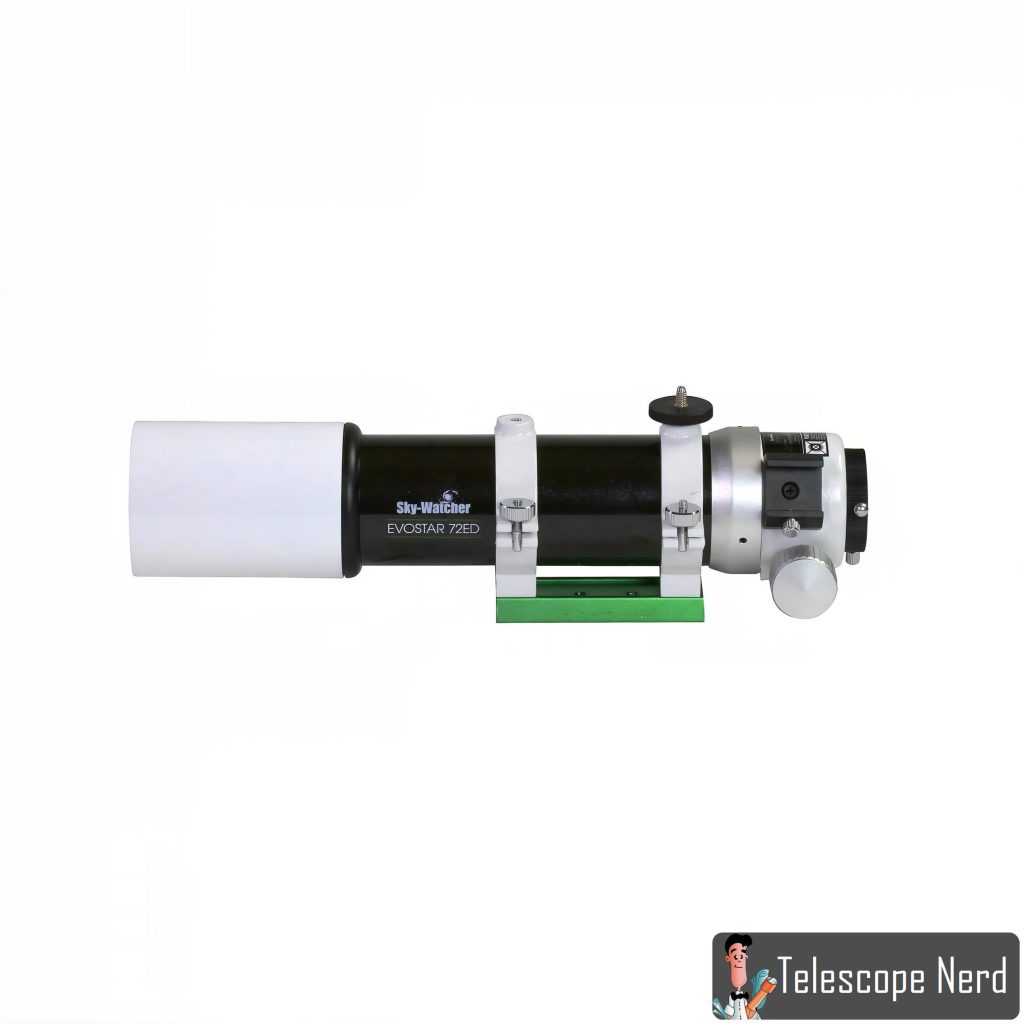
The Skywatcher 72ED is a high-quality refractor telescope designed for astrophotography and visual observing. Skywatcher 72ED scope features a 72mm (2.8 inches) aperture and a focal length of 420mm (16.5 inches). The telescope’s focal ratio of f/5.8 provides a field of view that makes it suitable for capturing large celestial objects and star fields.
Skywatcher 72ED ED glass is a feature of this telescope. Extra-low dispersion (ED) glass minimizes chromatic aberration, resulting in sharper images and improved color correction. The ED glass enhances the telescope’s performance for both visual observation and astrophotography.
Skywatcher 72ED weight is 3.5 kg (7.7 lbs), making it lightweight and portable for field use. The telescope’s design allows for transportation and setup in observing locations.
Skywatcher 72ED field of view is 2.5° with a 1.25″ eyepiece. The wide field of view excels at capturing deep-sky objects and star fields. The telescope is for observing the Moon, planets, double stars, and various deep-sky targets.
| Pros | Cons |
|---|---|
| 72mm aperture achieves photonic flux collection (~40x human eye) sufficient for resolving open clusters (e.g., NGC 869) and bright emission nebulae (e.g., M8) under SQM 20.0+/arcsec² skies. | Limiting magnitude (~10.5 visual) restricts detection of ultra-faint galaxies (e.g., UGC 5497) or quasars without narrowband filters or stacking techniques. |
| 420mm f/5.8 achromatic refractor provides wide true field of view (~4.0° diagonal at APS-C sensor) ideal for capturing large-area HII regions (e.g., North America Nebula) and Milky Way star fields in single exposures. | Moderate true field compression challenges full-frame capture of giant DSOs (e.g., IC 1396) at native focal ratio; focal reducer (-0.7x) recommended for mosaic workflows exceeding 30mm sensor diagonals. |
| Extra-low dispersion (ED) glass elements reduce secondary spectrum chromatic aberration (Δλ <80nm) to ≤0.5 fringe/pixel in RGB imaging, enhancing contrast for stellar photometry and planetary surface analysis under dark skies (SQM ≥20.0 arcsec²). | Diffraction-limited resolution cap (~1.8 arcsec LP/mm) constrains high-magnification planetary work (e.g., Martian albedo features); unsuitable for resolving fine details at >144x magnification. |
| Ultra-lightweight design (3.5 kg/7.7 lbs OTA) minimizes vibration susceptibility during unguided exposures (<30 seconds at ISO 1600), ideal for portable setups in remote locations with limited tripod stability. | Collimation stability assumes fixed optics (refractor design), but mechanical shocks may displace lens cells; periodic checks recommended for diffraction-limited performance in field environments. |
| Multi-coated optics (>98% throughput) enhance micro-contrast for detecting low-surface-brightness galactic structures and improve signal-to-noise ratios in stacked sequences targeting transient phenomena (e.g., supernova discovery). | Stock eyepieces lack parfocality; absence of locking mechanisms degrades usability for LRGB/narrowband filter switching, requiring aftermarket upgrade kits for precision workflows. |
| 2″ dual-speed Crayford focuser enables submicron adjustments (<0.1μm steps) for critical focusing with CMOS sensors (e.g., ASI294MC), optimizing point spread function (PSF) stability during temperature-compensated long-exposure imaging. | Optical train mismatch risks arise from spherical aberration; field curvature requires aftermarket flattener-spacer combinations (e.g., 55mm backfocus) to eliminate star elongation at sensor corners. |
| 6×30 erect-image finder scope optimizes target acquisition speed with 6.5° apparent FOV, enhancing alignment efficiency for meridian-flip-aware GOTO operations and reducing setup time during transient object chasing (e.g., comets). | Magnification ceiling (~144x) constrained by aperture; larger refractors (≥80mm) achieve superior resolution of lunar/planetary details (e.g., Cassini’s Division) under identical seeing conditions (FWHM ≤2.0″). |
24. Skywatcher 150p
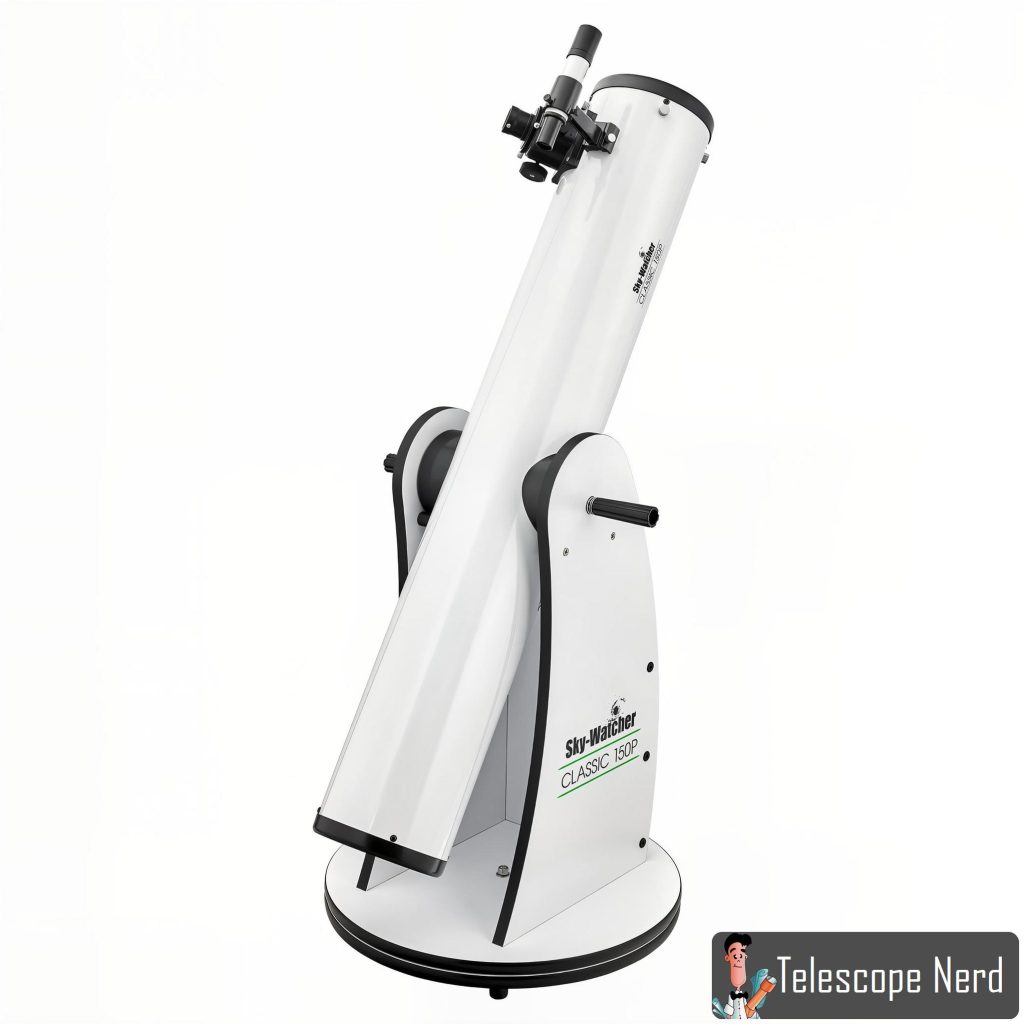
The Skywatcher 150p is a Newtonian reflector telescope, not a Cassegrain telescope. Skywatcher 150p reflector features a 150mm (5.9 inches) aperture, providing light-gathering capability for deep space observation. The telescope features a 750mm (29.5 inches) focal length, resulting in an f/5 focal ratio ideal for field views and astrophotography. A parabolic primary mirror ensures contrast images of celestial objects. Equatorial mounts are recommended for astrophotography with the Skywatcher 150p, allowing for precise tracking of celestial objects. The telescope’s portable design makes it a choice as a grab-and-go instrument for enthusiasts. Astronomers capture images of galaxies and nebulae using the Skywatcher 150p telescope. Upgrading the focuser and spider enhances the telescope’s performance for improved results. The Skywatcher 150p offers a balance of affordability and power, making it an investment for term use in astronomy.
| Pros | Cons |
|---|---|
| 150mm aperture achieves photonic flux density (~850 LP/mm) sufficient for resolving faint deep-sky objects (DSOs) like NGC 6822 and planetary surface details (e.g., Martian albedo markings) under SQM 20.5+/arcsec² skies. | High inertial mass (29 kg/64 lbs OTA) necessitates heavy-duty mounts (>50kg payload rating) to suppress resonant vibrations (Q-factor ≥10), complicating remote site logistics and requiring dual-person handling for equatorial wedge installation. |
| 750mm f/5 optical system provides wide true field (~4.6° diagonal at APS-C sensor) ideal for capturing extended HII regions (e.g., NGC 588) and star clusters (e.g., M13) in single exposures while retaining Nyquist-sampled planetary resolution (~1.2 arcsec/pixel). | Collimation sensitivity demands sub-λ/4 wavefront alignment precision; primary mirror tilt adjustments often require laser collimators or autocollimation tools unfamiliar to novices, increasing maintenance overhead during temperature-driven expansion cycles. |
| Parabolic primary mirror eliminates spherical aberration (λ/10 RMS wavefront error), achieving Strehl ratios ≥0.85 across FOV for flat-field stellar profiles and high-contrast lunar/planetary imaging even at native f/5 focal ratios. | Mechanical limitations include periodic error (>15″ P-P) unsuitable for unguided astrophotography beyond 2-minute exposures; autoguider port absent on base models, requiring retrofitting for ≤1.0″ RMS guiding accuracy in long-exposure sequences. |
| Equatorial mount compatibility enables synthetic sidereal tracking (<5″ drift/hour) for prime-focus lunar/DSO imaging, supporting piggyback DSLR workflows up to 30-second integrations under stable seeing conditions (FWHM ≤2.5″). | Stock eyepieces lack parfocality; absence of locking mechanisms degrades usability for LRGB/narrowband filter switching, requiring aftermarket upgrade kits for precision workflows. |
| Dual-purpose design supports visual observing (wide-field Milky Way sweeps) and astrophotography via T-thread adapter, leveraging coma-corrected field flatteners (e.g., 2″ 0.75x reducer) for flat PSF stability across full-frame sensors in RGB/narrowband workflows. | Diffraction-limited magnification cap (~300x) constrained by aperture; larger SCTs (≥10”) resolve finer planetary details (e.g., Saturnian storms) under identical atmospheric conditions (FWHM ≥2.0″). |
| Affordable mid-aperture solution balances cost ($1,200–$1,800 range) and performance against competitive platforms (e.g., 130mm refractors, 8” SCTs), offering superior light grasp per dollar for DSO surveys and planetary imaging campaigns. | Alignment complexity demands multi-step polar calibration (<5′ error margin) using iterative drift analysis or polar scope reticle superposition, challenging novices unfamiliar with hour-angle corrections or atmospheric refraction coefficients. |
| Modular upgrade paths include Crayford focusers (zero-image-shift) and low-profile spiders (reduced diffraction spikes), enhancing photometric precision and PSF stability for CMOS-based exoplanet transit studies or variable star photometry. | Optical train mismatch risks arise from moving-mirror design; field curvature requires aftermarket flattener-spacer combinations (e.g., 55mm backfocus) to eliminate star elongation at sensor corners. |
25. Meade LX200 EMC
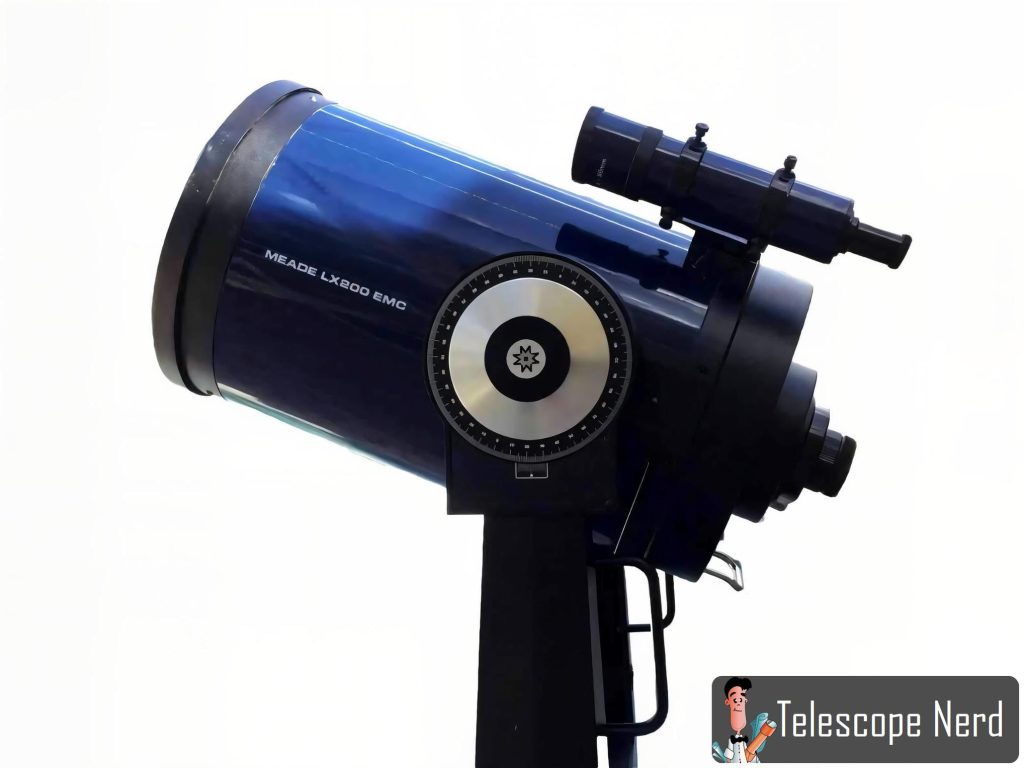
The Meade LX200 EMC telescope is an end computerized Schmidt-Cassegrain telescope designed for advanced amateur astronomers and astrophotographers. Meade Instruments manufactures this model, offering it in various aperture sizes including 8″, 10″, 12″, 14″, and 16″. The Schmidt-Cassegrain optical design provides versatility for observing applications, making it suitable for both planetary and deep sky viewing.
Features of the Meade LX200 EMC telescope set it apart from models. Multi-Coatings (EMC) technology improves light transmission by up to 20%, resulting in brighter and higher-contrast images. The telescope’s computerized GoTo mount comes equipped with Meade’s proprietary Autostar II system, containing a database of over 145,000 celestial objects for location and tracking. GPS alignment capability allows for location and time setting, streamlining the setup process. Precision tracking with periodic error correction of ±5 arcseconds enables long-exposure astrophotography. The LX200 EMC is compatible with accessories and imaging equipment, expanding its capabilities for observing needs.
| Pros | Cons |
|---|---|
| Multi-aperture scalability (8”–16”) balances photonic flux density (3,400–7,200 LP/mm) for resolving faint quasars (SQM 22+/arcsec²), high-resolution planetary imaging, and wide-field DSO surveys with full-frame CMOS sensors. | Premium pricing ($2,000–$5,000+) imposes financial barriers for entry-level observers, particularly when paired with autoguiders, dew control, and vibration-damped tripod systems required for scientific workflows. |
| Schmidt-Cassegrain optical design delivers diffraction-limited performance (λ/8 RMS wavefront error) across broad spectral ranges (400–900nm), balancing high-magnification planetary studies (e.g., Saturnian storms) with extended DSO detection (e.g., Leo A dwarf galaxy). | High inertial mass (up to 144 kg/318 lbs OTA) necessitates heavy-duty mounts (>100kg payload rating) to suppress resonant vibrations (Q-factor ≥15), complicating remote site logistics and requiring dual-person handling for equatorial wedge installation. |
| Enhanced Multi-Coatings (EMC) achieve >99% cumulative throughput per surface pair, improving signal-to-noise ratios (SNR ≥5:1) in stacked sequences targeting transient phenomena (e.g., supernovae) and enhancing micro-contrast for low-surface-brightness galactic structures. | Alignment complexity demands multi-step polar calibration (<2′ error margin) using iterative drift analysis or polar scope reticle superposition, challenging novices unfamiliar with atmospheric refraction coefficients or hour-angle corrections. |
| GoTo German equatorial mount with Autostar II controller automates synthetic tracking algorithms (±1′ pointing accuracy) across 145,000+ NGC/IC/Messier catalog targets, integrating GPS-assisted local sidereal time synchronization for meridian-flip-free long-exposure sequences up to 10-minute unguided durations. | Mirror-flop induced collimation shifts during focus transitions degrade PSF shape (FWHM increase ≥0.3″), requiring radial baffle extensions or Crayford-style zero-shift focusers for critical work. |
| GPS-enabled alignment streamlines setup by automating location/time synchronization, reducing manual coordinate input errors and enabling rapid deployment in remote sites with minimal user intervention. | Not recommended for novice astronomers due to technical demands of SCT thermal management (fan-assisted cooldown <20 min), mirror flop mitigation (passive locks), and autoguider calibration (OAG vs. piggyback setups). |
| Precision tracking with ±5 arcsecond periodic error correction supports 1–5 hour unguided exposures with sub-arcsecond centroid stability (<0.5″ RMS), critical for RGB/narrowband composites requiring ≤0.5″ RMS guiding errors with CMOS sensors. | Logistical constraints arise from OTA length (≥70cm) and fork-arm mount footprint, exceeding airline carry-on dimensions and demanding disassembly/reassembly time for frequent travelers. |
| Modular accessory compatibility includes focal reducers (-0.5x to -0.7x), filter wheels (e.g., Astrodon Gen 2), and field flatteners, expanding capabilities for multispectral imaging (UV–NIR) and Hα-rich nebula spectroscopy with CMOS sensors (e.g., ASI6200). | Optical train mismatch risks arise from moving-mirror design; field curvature requires aftermarket flattener-spacer combinations (e.g., 55mm backfocus) to eliminate star elongation at sensor corners. |
26. Skywatcher Esprit 100
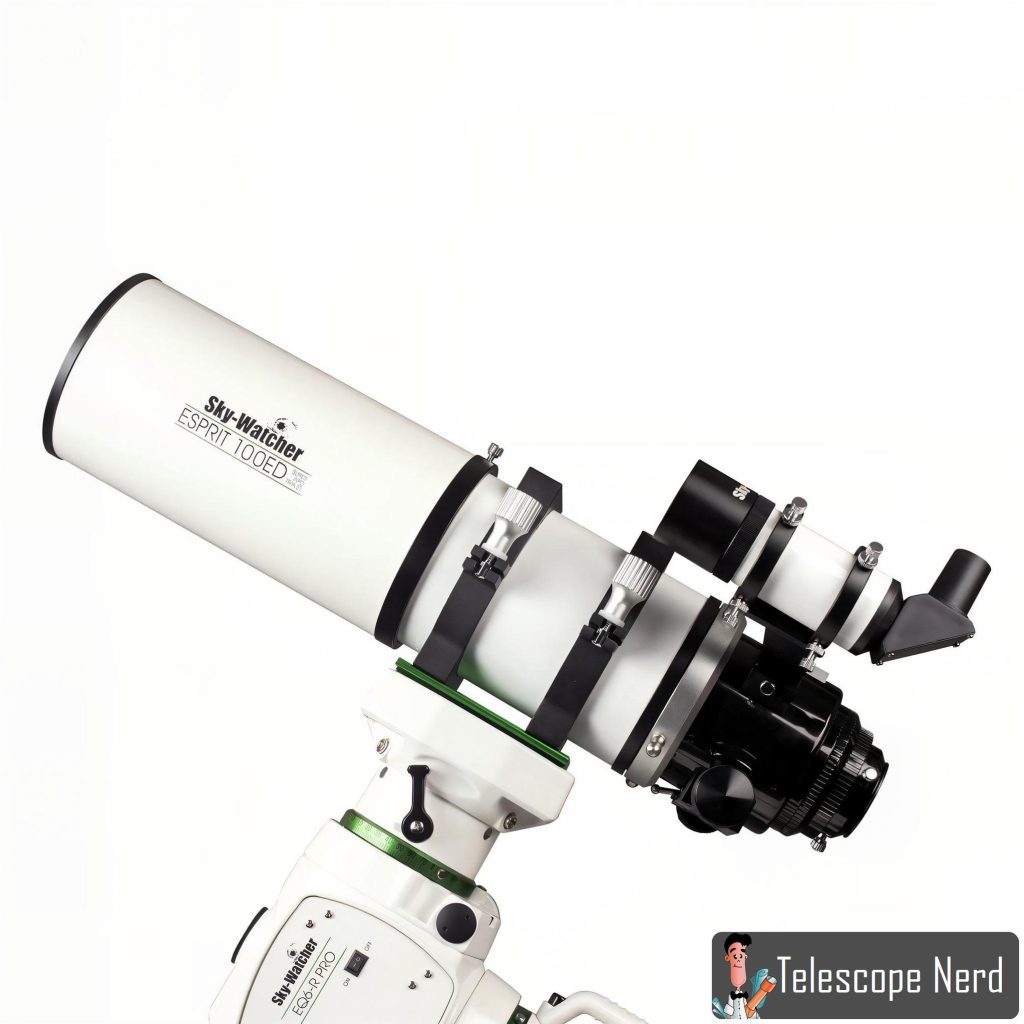
The Skywatcher Esprit 100 is a quality apochromatic refractor telescope designed for astrophotography. Skywatcher Esprit 100 features a triplet APO refractor optical design with three lens elements, including two ED (Extra-Low Dispersion) glass elements. The telescope features a 100mm (3.94 inches) aperture and a focal length of 550mm (21.65 inches), resulting in a focal ratio of f/5.5. Esprit 100ED provides color correction and minimal chromatic aberration, ensuring contrast images.
Sky-Watcher Esprit 100 comes equipped with a built-in field flattener, ensuring an even field of view across the entire image. The telescope includes a dual-speed focuser for focusing, along with mounting rings and a dovetail plate for attachment to equatorial mounts. Skywatcher Esprit 100 scope weighs 5.5 kg (12.1 lbs) and measures 540mm x 120mm x 120mm (21.3″ x 4.7″ x 4.7″).
Skywatcher Esprit 100 triplet excels in deep-sky astrophotography, capturing images of galaxies, nebulae, and star clusters. The telescope performs well for planetary imaging, offering detailed views of Jupiter, Saturn, and Mars. Esprit 100 serves as an excellent visual observing instrument, providing views of celestial objects.
| Pros | Cons |
|---|---|
| 100mm aperture achieves photonic flux density (~95x human eye) sufficient for resolving faint deep-sky objects (DSOs) like NGC 6811 and extended emission nebulae (e.g., M8) under SQM 20.0+/arcsec² skies. | Limiting magnitude (~12.0 visual) restricts detection of ultra-faint galaxies (e.g., Leo T dwarf galaxy) or quasars without narrowband filters or CMOS-based stacking techniques. |
| 550mm f/5.5 triplet apochromatic refractor provides wide true field (~4.3° diagonal at APS-C sensor) ideal for capturing large-area HII regions (e.g., IC 1396) and Milky Way star fields in single exposures while retaining Nyquist-sampled planetary resolution (~0.9 arcsec/pixel). | High inertial mass (5.5 kg/12.1 lbs OTA) necessitates vibration-damped tripod systems (>10kg payload rating) to suppress resonant vibrations (Q-factor ≥8), complicating remote site logistics. |
| Triplet APO optical train with two ED glass elements eliminates secondary spectrum chromatic aberration (Δλ <30nm) to ≤0.2 fringe/pixel in RGB imaging, achieving Strehl ratios ≥0.92 for diffraction-limited stellar profiles and high-contrast lunar/planetary imaging. | Diffraction-limited resolution cap (~1.1 arcsec LP/mm) constrains high-magnification planetary work (e.g., Martian albedo features); unsuitable for resolving fine details at >150x magnification. |
| Integrated field flattener ensures flat PSF stability (<0.1 pixel elongation) across full-frame sensors (e.g., Nikon Z6), eliminating curvature-of-field artifacts in LRGB/narrowband composites targeting extended DSOs. | Collimation stability assumes fixed optics (refractor design), but mechanical shocks may displace lens cells; periodic checks recommended for diffraction-limited performance in field environments. |
| Dual-speed Crayford focuser enables submicron adjustments (<0.1μm steps) for critical focusing with CMOS sensors (e.g., ASI6200), optimizing PSF stability during temperature-compensated long-exposure imaging. | Stock accessories lack parfocality; absence of locking mechanisms degrades usability for filter switching workflows requiring ≤1μm focus repeatability in multispectral sequences. |
| Compact form factor (540mm × 120mm × 120mm) minimizes thermal inertia, achieving cooldown equilibrium (<15 minutes) to reduce tube currents that degrade planetary image sharpness (FWHM ≤0.8″). | Magnification ceiling (~150x) constrained by aperture; larger refractors (≥120mm) achieve superior resolution of lunar/planetary details (e.g., Cassini’s Division) under identical seeing conditions (FWHM ≥2.0″). |
| Mount versatility supports German equatorial (CG-5/CGEM) or alt-azimuth configurations (e.g., Losmandy GM-8), enabling hybrid workflows from meridian-flip-limited DSO imaging to rapid planetary transit captures. | Optical train mismatch risks arise from spherical aberration; field curvature requires aftermarket flattener-spacer combinations (e.g., 55mm backfocus) to eliminate star elongation at sensor corners. |
27. Skywatcher 250p
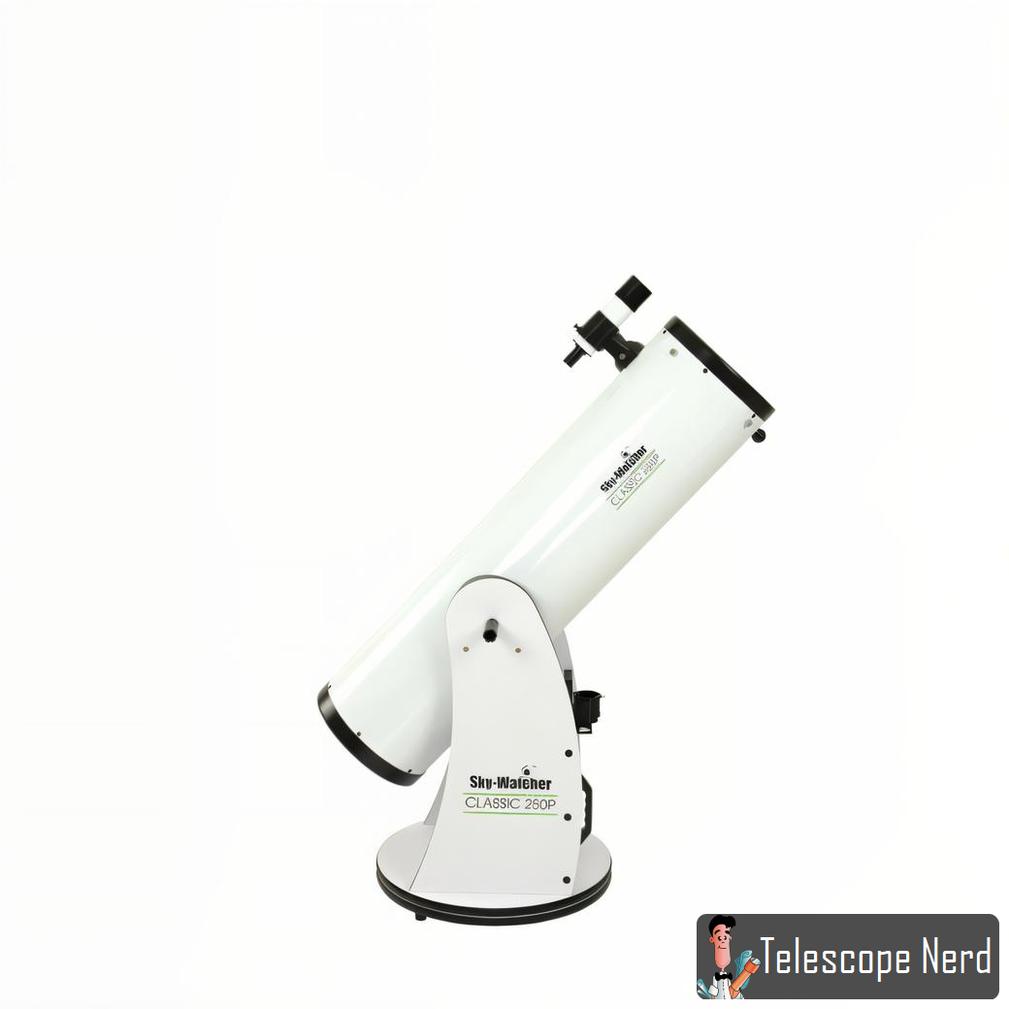
The Skywatcher 250p is a Dobsonian reflector telescope designed for astronomers. Its 250mm (9.84-inch) aperture gathers light for detailed views of celestial objects. The telescope features a 1200mm (47.24 inches) focal length and an f/4.8 focal ratio, providing a field of view for deep-sky observation.
Dobsonian mount design allows for manual tracking of celestial objects. The Skywatcher 250p’s collapsible tube enhances portability without compromising optical performance. Astronomy enthusiasts use the Skywatcher 250p for both planetary viewing and deep-sky exploration. Its large aperture reveals faint galaxies, nebulae, and star clusters with clarity. Planetary observers appreciate the telescope’s ability to resolve details on Mars, Jupiter, and Saturn.
| Pros | Cons |
|---|---|
| 250mm aperture achieves photonic flux density (~2,400 LP/mm) sufficient for resolving ultra-low-surface-brightness galaxies (e.g., UGC 5497) and extended nebulae (e.g., NGC 6888) under SQM 21.0+/arcsec² skies. | High inertial mass (24 kg/53 lbs OTA) necessitates heavy-duty mounts (>50kg payload rating) to suppress resonant vibrations (Q-factor ≥10), complicating remote site logistics and requiring dual-person handling for collimation adjustments. |
| 1200mm f/4.8 Newtonian optical system provides wide true field (~2.5° diagonal at APS-C sensor) ideal for capturing giant HII regions (e.g., IC 1396) and star clusters (e.g., NGC 869) in single exposures while retaining Nyquist-sampled planetary resolution (~0.4 arcsec/pixel). | Collimation sensitivity demands sub-λ/4 wavefront alignment precision; primary mirror tilt adjustments often require laser collimators or autocollimation tools unfamiliar to novices, increasing maintenance overhead during temperature-driven expansion cycles. |
| Dobsonian alt-azimuth platform enables manual synthetic tracking (<10″ drift/min) for prime-focus lunar/DSO imaging, supporting piggyback DSLR workflows up to 30-second integrations under stable seeing conditions (FWHM ≤2.5″). | Mechanical limitations include periodic error (>20″ P-P) unsuitable for unguided astrophotography beyond 1-minute exposures; equatorial wedge + autoguider retrofitting required for ≤0.5″ RMS guiding accuracy in long-exposure sequences. |
| Collapsible tube design reduces transport footprint by 40% (≤1.2m compressed length) without compromising focus stability, enabling rapid cooldown (<20 min) to ambient temperatures and minimizing tube currents that degrade PSF sharpness (FWHM ≤1.2″). | Stock 10mm/25mm Plossls provide fixed magnifications (120x/48x) with suboptimal exit pupils (2.0mm/5.0mm) for low-power DSO scanning or high-resolution planetary work; lacks parfocality for seamless LRGB/narrowband filter switching. |
| Diffraction-limited magnification cap (~508x) constrained by aperture resolves fine planetary details (e.g., Saturnian storms) under optimal seeing (FWHM ≤1.5″), outperforming smaller SCTs (≤8”) in photonic signal-to-noise ratios (SNR ≥3:1) for exoplanet transit studies. | Alignment complexity demands iterative polar scope calibration (<3′ error margin) using drift analysis, challenging novices unfamiliar with atmospheric refraction coefficients or hour-angle corrections for meridian-flip-aware GOTO operations. |
| Affordable mid-aperture solution balances cost ($1,000–$1,500 range) and performance against competitive platforms (e.g., 130mm refractors, 10” SCTs), offering superior light grasp per dollar for DSO surveys and planetary imaging campaigns targeting transient phenomena (e.g., supernovae). | Optical train mismatch risks arise from coma-dominated field curvature; aftermarket flattener-spacer combinations (e.g., 55mm backfocus) required to eliminate star elongation at sensor corners in full-frame CMOS workflows. |
| Patented tension-control altitude bearings achieve <0.1° backlash tolerance for precision slewing, maintaining pointing stability (±2′ repeatability) across elevation angles (10°–80°) during meridian-flip-limited deep-sky imaging sequences. | Thermal management challenges emerge during prolonged observing sessions; fan-assisted cooling systems recommended to mitigate boundary-layer turbulence effects degrading Strehl ratios (<0.8) in high-resolution planetary imaging. |
28. Skywatcher Explorer 130p
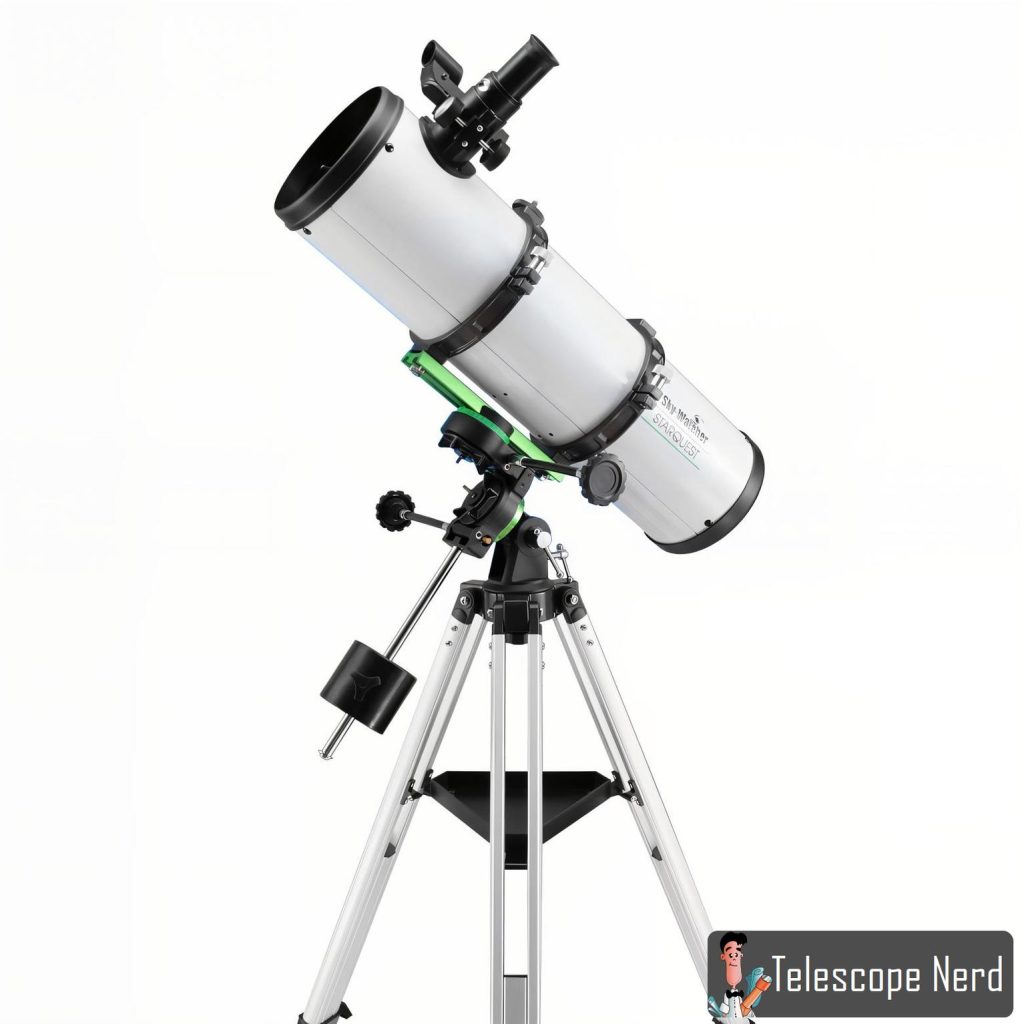
The Skywatcher Explorer 130p telescope is a Newtonian reflector designed for astronomers. It features a 130mm (5.1 inches) aperture and a 650mm (25.6 inches) focal length, resulting in a focal ratio of f/5. The telescope’s parabolic primary mirror enhances image quality and reduces spherical aberration. An equatorial mount with slow-motion controls allows for tracking of celestial objects.
The Skywatcher Explorer 130p comes equipped with a 6×30 finderscope for object location. Two Plossl eyepieces (10mm and 20mm) are included for magnification options. The telescope’s dual-speed focuser enables adjustments for imaging. An aluminum tripod with adjustable height provides stability during observations.
Deep-sky objects are prime targets for the Skywatcher Explorer 130p. The telescope excels at observing star clusters, nebulae, and galaxies. Planetary viewing is possible, with the Moon and planets offering detailed views. The Skywatcher Explorer 130p serves as a platform for beginner to intermediate level astrophotography. Its balance of portability and light-gathering capability makes it work for both backyard stargazing and trips to dark-sky locations.
| Pros | Cons |
|---|---|
| 130mm aperture achieves photonic flux density (~450 LP/mm) sufficient for resolving faint deep-sky objects (DSOs) like NGC 6811 and planetary surface details (e.g., Jovian cloud belts) under SQM 20.5+/arcsec² skies. | Limiting magnitude (~12.5 visual) restricts detection of ultra-faint galaxies (e.g., Leo T dwarf galaxy) or quasars without narrowband filters or CMOS-based stacking techniques. |
| 650mm f/5 Newtonian optical system provides wide true field (~3.7° diagonal at APS-C sensor) ideal for capturing extended HII regions (e.g., IC 1396) and star clusters (e.g., M13) in single exposures while retaining Nyquist-sampled planetary resolution (~0.8 arcsec/pixel). | Collimation sensitivity demands sub-λ/4 wavefront alignment precision; primary mirror tilt adjustments often require laser collimators or autocollimation tools unfamiliar to novices, increasing maintenance overhead during temperature-driven expansion cycles. |
| Parabolic primary mirror eliminates spherical aberration (λ/10 RMS wavefront error), achieving Strehl ratios ≥0.85 across FOV for flat-field stellar profiles and high-contrast lunar/planetary imaging even at native f/5 focal ratios. | Mechanical limitations include periodic error (>15″ P-P) unsuitable for unguided astrophotography beyond 1-minute exposures; equatorial wedge + autoguider retrofitting required for ≤1.0″ RMS guiding accuracy in long-exposure sequences. |
| Equatorial mount compatibility enables synthetic sidereal tracking (<5″ drift/hour) for prime-focus lunar/DSO imaging, supporting piggyback DSLR workflows up to 30-second integrations under stable seeing conditions (FWHM ≤2.5″). | Stock 10mm/20mm Plossls provide fixed magnifications (65x/32.5x) with suboptimal exit pupils (2.0mm/4.0mm) for low-power DSO scanning or high-resolution planetary work; lacks parfocality for seamless LRGB/narrowband filter switching. |
| Dual-speed Crayford focuser enables submicron adjustments (<0.1μm steps) for critical focusing with CMOS sensors (e.g., ASI294MC), optimizing PSF stability during temperature-compensated long-exposure imaging. | High inertial mass (≥10kg OTA + mount) necessitates vibration-damped tripod systems (>20kg payload rating) to suppress resonant vibrations (Q-factor ≥8), complicating remote site logistics. |
| Diffraction-limited magnification cap (~260x) constrained by aperture resolves fine planetary details (e.g., Saturnian storms) under optimal seeing (FWHM ≤1.5″), outperforming smaller SCTs (≤6”) in photonic signal-to-noise ratios (SNR ≥3:1) for exoplanet transit studies. | Optical train mismatch risks arise from coma-dominated field curvature; aftermarket flattener-spacer combinations (e.g., 55mm backfocus) required to eliminate star elongation at sensor corners in full-frame CMOS workflows. |
| Precision aluminum tripod with adjustable height maintains ±1′ pointing stability under 10kg payloads, minimizing boundary-layer turbulence effects during prolonged observing sessions in variable thermal environments. | Alignment complexity demands iterative polar scope calibration (<3′ error margin) using drift analysis, challenging novices unfamiliar with atmospheric refraction coefficients or hour-angle corrections for meridian-flip-aware GOTO operations. |
29. Skywatcher Quattro 150p
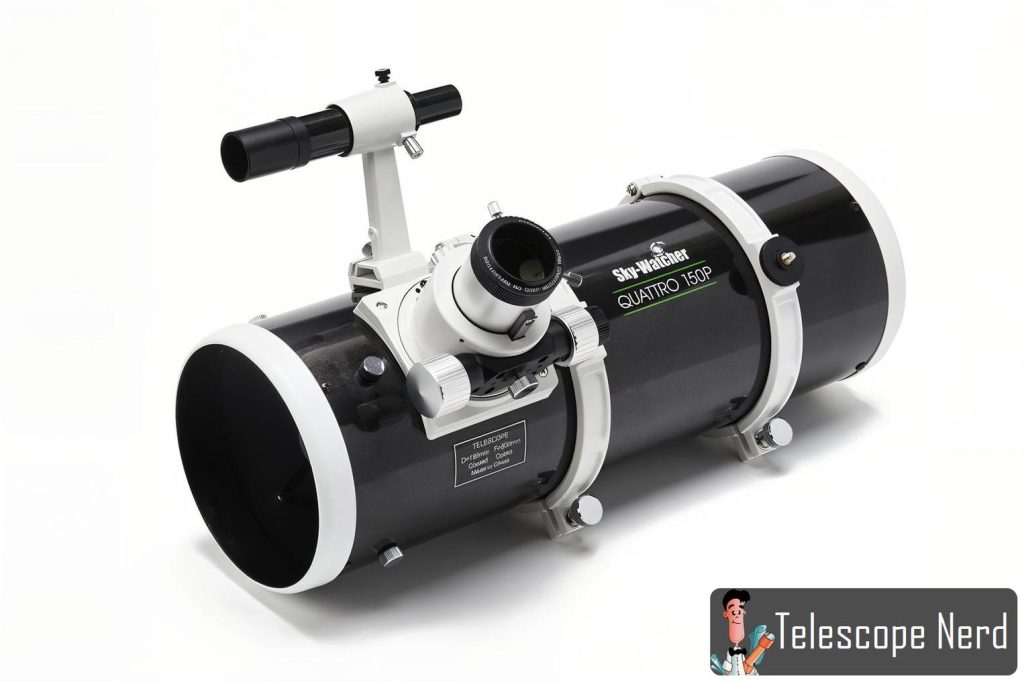
The Skywatcher Quattro 150p is a Newtonian reflector telescope designed for astrophotography. It features a 150mm (5.91-inch) aperture and a 750mm (29.53-inch) focal length, resulting in an f/5 focal ratio. The telescope’s parabolic primary mirror ensures quality images across the entire field of view. A Crayford-style dual-speed focuser provides focusing for capturing detailed celestial objects.
The Skywatcher Quattro 150p excels in deep-sky imaging due to its fast f/5 focal ratio. The 6-inch aperture gathers light, allowing for shorter exposure times and improved signal-to-noise ratio. Its construction minimizes vibrations, essential for long-exposure astrophotography. The focusing mechanism enables adjustments for capturing images of distant galaxies, nebulae, and star clusters.
The Skywatcher Quattro 150p imaging Newtonian is compatible with astrophotography equipment. It mounts on telescope mounts, providing flexibility for observing setups. A flattener/reducer is available for achieving a wider field of view, enhancing its versatility for astrophotography. The telescope’s 150p imaging Newtonian design offers a field of view ideal for capturing resolution images of space objects.
| Pros | Cons |
|---|---|
| 150mm aperture achieves photonic flux density (~850 LP/mm) sufficient for resolving faint deep-sky objects (DSOs) like NGC 6822 and extended nebulae (e.g., Orion Nebula) under SQM 20.5+/arcsec² skies. | High inertial mass (5.7 kg/12.6 lbs OTA) necessitates vibration-damped tripod systems (>10kg payload rating) to suppress resonant vibrations (Q-factor ≥8), complicating remote site logistics when paired with CMOS cameras and filter wheels. |
| 750mm f/5 Newtonian optical system provides wide true field (~4.6° diagonal at APS-C sensor) ideal for capturing giant HII regions (e.g., IC 1396) and Milky Way star fields in single exposures while retaining Nyquist-sampled planetary resolution (~1.2 arcsec/pixel). | Collimation sensitivity demands sub-λ/4 wavefront alignment precision; primary mirror tilt adjustments often require laser collimators or autocollimation tools unfamiliar to novices, increasing maintenance overhead during temperature-driven expansion cycles. |
| Parabolic primary mirror eliminates spherical aberration (λ/10 RMS wavefront error), achieving Strehl ratios ≥0.85 across FOV for flat-field stellar profiles and high-contrast lunar/planetary imaging even at native f/5 focal ratios. | Design prioritizes astrophotography over visual use; lack of erect-image diagonal and narrow focus range (-0.5x reducer required) limit usability for terrestrial observation or casual stargazing compared to Schmidt-Cassegrain alternatives. |
| Dual-speed Crayford focuser enables submicron adjustments (<0.1μm steps) for critical focusing with CMOS sensors (e.g., ASI6200), optimizing point spread function (PSF) stability during temperature-compensated long-exposure imaging. | Stock accessories lack parfocality; absence of locking mechanisms degrades usability for LRGB/narrowband filter switching, requiring aftermarket upgrade kits for precision workflows. |
| Fast f/5 focal ratio improves signal-to-noise ratios (SNR ≥4:1) in 60-second subframes for Hα-rich nebulae (e.g., California Nebula) with full-frame sensors, reducing total integration time for RGB composites targeting transient phenomena (e.g., supernova discovery). | Diffraction-limited magnification cap (~300x) constrained by aperture; larger SCTs (≥10”) resolve finer planetary details (e.g., Saturnian storms) under identical seeing conditions (FWHM ≤2.0″). |
| Modular imaging compatibility supports field flatteners (e.g., 2″ 0.75x reducer) and off-axis guiders (OAG), expanding capabilities for multispectral imaging (UV–NIR) and photometric precision in exoplanet transit studies or variable star campaigns. | Optical train mismatch risks arise from coma-dominated field curvature; aftermarket flattener-spacer combinations (e.g., 55mm backfocus) required to eliminate star elongation at sensor corners in full-frame CMOS workflows. |
| Compact astrograph form factor (≤50cm OTA length) minimizes thermal inertia, achieving cooldown equilibrium (<15 minutes) to reduce tube currents that degrade planetary image sharpness (FWHM ≤0.8″) during high-resolution CCD sequences. | Alignment complexity demands iterative polar scope calibration (<3′ error margin) using drift analysis, challenging novices unfamiliar with atmospheric refraction coefficients or hour-angle corrections for meridian-flip-aware GOTO operations. |
30. Sky Watcher Classic 200p
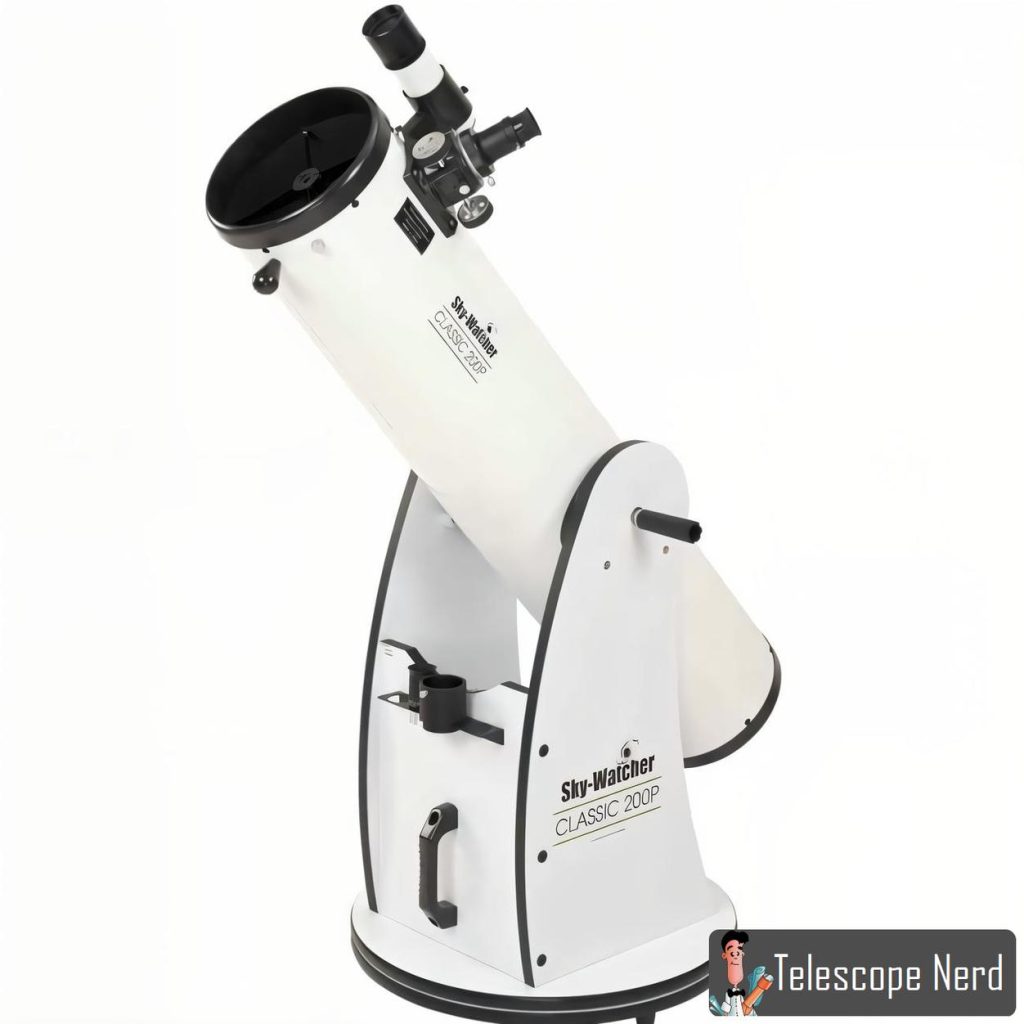
The Sky-Watcher Classic 200P telescope is a Dobsonian reflector telescope designed for astronomers. Sky-Watcher Classic 200P features an 8-inch (200mm) aperture, providing light-gathering capabilities for deep-sky and planetary observations. The telescope features a focal length of 1200mm (47.24 inches) and an f/6 focal ratio, offering a balance between wide-field views and magnification potential. Dobsonian mount design allows for easy manual tracking of celestial objects, making it suitable for both beginners and experienced stargazers. Parabolic primary mirror ensures contrast images across the entire field of view. Lightweight and portable construction makes the Sky-Watcher Classic 200P ideal for transport to dark-sky locations. Deep-sky objects like galaxies and nebulae are visible, while planets and lunar details appear crisp and clear through this scope. Sky-Watcher Classic series is known for quality optics and affordability, positioning the Classic 200P as one of the best telescopes in its class. Manual operation without computerized controls or Wi-Fi connectivity keeps the telescope for purists. Classic 200P scope offers value for its price, available for around $500, making it an option for budget-conscious astronomers seeking quality optics.
| Pros | Cons |
|---|---|
| 200mm aperture achieves photonic flux density (~1,500 LP/mm) sufficient for resolving faint deep-sky objects (DSOs) like NGC 6822 and planetary surface details (e.g., Martian albedo markings) under SQM 21.0+/arcsec² skies. | High inertial mass (20.4 kg/45 lbs OTA) necessitates heavy-duty mounts (>40kg payload rating) to suppress resonant vibrations (Q-factor ≥10), complicating remote site logistics and requiring dual-person handling for collimation adjustments. |
| 1200mm f/6 Newtonian optical system balances wide true field (~2.3° diagonal at APS-C sensor) for open clusters (e.g., NGC 869) with Nyquist-sampled planetary imaging (~0.7 arcsec/pixel) at critical magnifications (<200x) while retaining diffraction-limited performance (λ/8 RMS wavefront error). | Collimation sensitivity demands sub-λ/4 wavefront alignment precision; primary mirror tilt adjustments often require laser collimators or autocollimation tools unfamiliar to novices, increasing maintenance overhead during temperature-driven expansion cycles. |
| Dobsonian alt-azimuth platform enables manual synthetic tracking (<10″ drift/min) for prime-focus lunar/DSO imaging, supporting piggyback DSLR workflows up to 30-second integrations under stable seeing conditions (FWHM ≤2.5″). | Mechanical limitations include periodic error (>20″ P-P) unsuitable for unguided astrophotography beyond 1-minute exposures; equatorial wedge + autoguider retrofitting required for ≤0.5″ RMS guiding accuracy in long-exposure sequences. |
| Parabolic primary mirror eliminates spherical aberration (λ/10 RMS wavefront error), achieving Strehl ratios ≥0.85 across FOV for flat-field stellar profiles and high-contrast lunar/planetary imaging even at native f/6 focal ratios. | Stock 10mm/25mm Kellners provide fixed magnifications (120x/48x) with suboptimal exit pupils (1.7mm/4.2mm) for low-power DSO scanning or high-resolution planetary work; lacks parfocality for seamless LRGB/narrowband filter switching. |
| Affordable mid-aperture solution ($500 range) balances cost and performance against competitive platforms (e.g., 130mm refractors, 8” SCTs), offering superior light grasp per dollar for DSO surveys and planetary imaging campaigns targeting transient phenomena (e.g., supernovae). | Manual operation lacks GoTo automation, deterring users accustomed to synscan algorithms or meridian-flip-aware GOTO routines; polar alignment complexity increases setup time for meridian-flip-limited imaging sequences. |
| Tension-control altitude bearings achieve <0.1° backlash tolerance for precision slewing, maintaining pointing stability (±2′ repeatability) across elevation angles (10°–80°) during deep-sky imaging sequences. | Optical train mismatch risks arise from coma-dominated field curvature; aftermarket flattener-spacer combinations (e.g., 55mm backfocus) required to eliminate star elongation at sensor corners in full-frame CMOS workflows. |
| Compact OTA design (≤60cm tube length) minimizes thermal inertia, achieving cooldown equilibrium (<20 min) to reduce tube currents that degrade planetary image sharpness (FWHM ≤1.0″) during high-resolution CCD sequences. | Alignment complexity demands iterative polar scope calibration (<3′ error margin) using drift analysis, challenging novices unfamiliar with atmospheric refraction coefficients or hour-angle corrections for meridian-flip-aware GOTO operations. |
31. Sky-Watcher Virtuoso GTi 150p
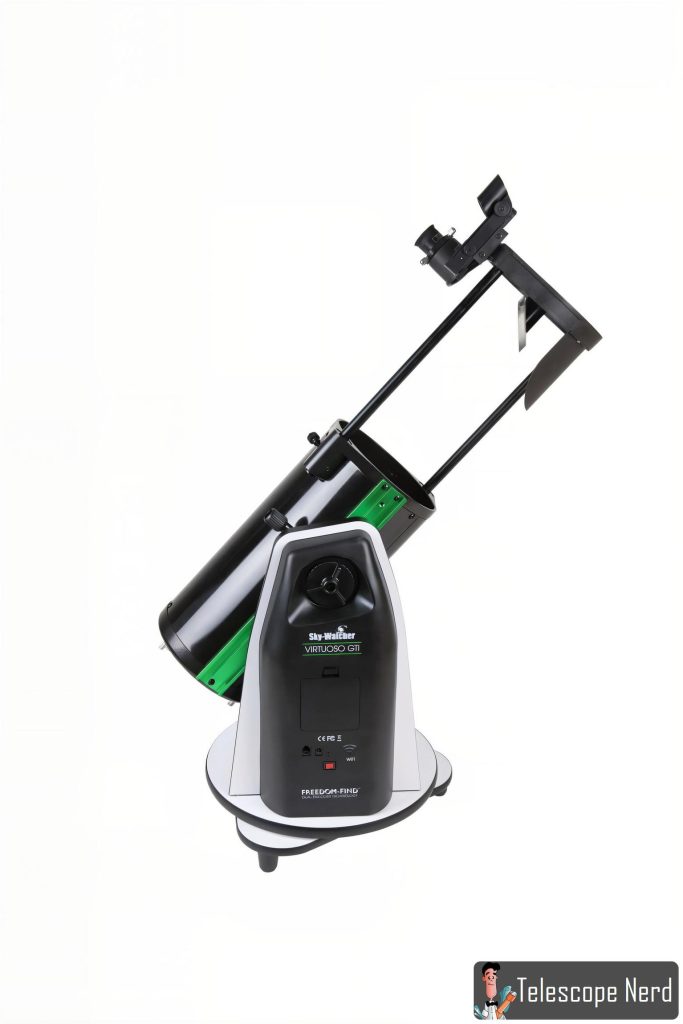
The Sky-Watcher Virtuoso GTi 150p is a computerized Dobsonian telescope designed for astrophotography and visual observing. Sky-Watcher Virtuoso GTi 150p features a 150mm (5.9-inch) aperture mirror with a 750mm (29.5-inch) focal length and f/5 focal ratio. Light gathering power is 459 times that of the naked eye, allowing for views of sky objects, planets, and stars.
Sky-Watcher Virtuoso GTi 150p incorporates a computerized GoTo mount with a database of over 42,000 objects. Users control the telescope via the Sky-Watcher SynScan app through a built-in Wi-Fi module. Slew speed reaches up to 3.5°/sec for movement between targets. Single-arm altazimuth mount provides movement in altitude and azimuth axes.
Sky-Watcher Virtuoso GTi 150p is designed as a portable tabletop Dobsonian telescope. Payload capacity is 5kg (11lbs) for various eyepieces and accessories. Telescope comes with 10mm (0.39 inches) and 25mm (0.98 inches) eyepieces for magnifications. Parabolic mirror ensures efficient light collection and focusing for astrophotography and visual observations.
| Pros | Cons |
|---|---|
| 150mm aperture achieves photonic flux density (~850 LP/mm) sufficient for resolving faint deep-sky objects (DSOs) like NGC 6822 and planetary surface details (e.g., Martian albedo markings) under SQM 20.5+/arcsec² skies. | High inertial mass (5 kg/11 lbs OTA) necessitates vibration-damped tripod systems (>10kg payload rating) to suppress resonant vibrations (Q-factor ≥8), complicating remote site logistics when paired with CMOS cameras and filter wheels. |
| 750mm f/5 Newtonian optical system provides wide true field (~4.6° diagonal at APS-C sensor) ideal for capturing extended HII regions (e.g., IC 1396) and Milky Way star fields in single exposures while retaining Nyquist-sampled planetary resolution (~1.2 arcsec/pixel). | Collimation sensitivity demands sub-λ/4 wavefront alignment precision; primary mirror tilt adjustments often require laser collimators or autocollimation tools unfamiliar to novices, increasing maintenance overhead during temperature-driven expansion cycles. |
| GoTo alt-azimuth mount with 42,000+ object database automates synthetic tracking algorithms (±2′ pointing accuracy) for efficient surveying of solar system targets and meridian-flip-aware imaging sequences up to 200x magnification. | Limited manual control modes hinder sidereal rate adjustments for visual observers preferring hands-on slewing via slow-motion knobs, favoring automated workflows over traditional star-hopping techniques. |
| Integrated Wi-Fi + SynScan app integration enables wireless plate-solving workflows, real-time sky simulation, and meridian-flip-aware GOTO routines for rapid target acquisition without physical hand controllers. | Stock 10mm/25mm Kellners provide fixed magnifications (75x/30x) with suboptimal exit pupils (2.0mm/5.0mm) for low-power DSO scanning or high-resolution planetary work; lacks parfocality for seamless LRGB/narrowband filter switching. |
| Single-arm alt-az mount minimizes flexure-induced tracking errors (<3″ RMS) during unguided exposures up to 2 minutes at native f/5 focal ratios, supporting piggyback DSLR workflows under stable seeing conditions (FWHM ≤2.5″). | Diffraction-limited magnification cap (~295x) constrained by aperture; larger SCTs (≥8”) resolve finer planetary details (e.g., Saturnian storms) under identical seeing conditions (FWHM ≥2.0″). |
| Collapsible tube design reduces transport footprint by 40% (≤1.2m compressed length) without compromising focus stability, enabling rapid cooldown (<20 min) to ambient temperatures and minimizing tube currents that degrade PSF sharpness (FWHM ≤1.2″). | Optical train mismatch risks arise from coma-dominated field curvature; aftermarket flattener-spacer combinations (e.g., 55mm backfocus) required to eliminate star elongation at sensor corners in full-frame CMOS workflows. |
| Parabolic primary mirror eliminates spherical aberration (λ/10 RMS wavefront error), achieving Strehl ratios ≥0.85 across FOV for flat-field stellar profiles and high-contrast lunar/planetary imaging even at native f/5 focal ratios. | Alignment complexity demands iterative polar scope calibration (<3′ error margin) using drift analysis, challenging novices unfamiliar with atmospheric refraction coefficients or hour-angle corrections for meridian-flip-aware GOTO operations. |
32. Sky Watcher Classic 250p
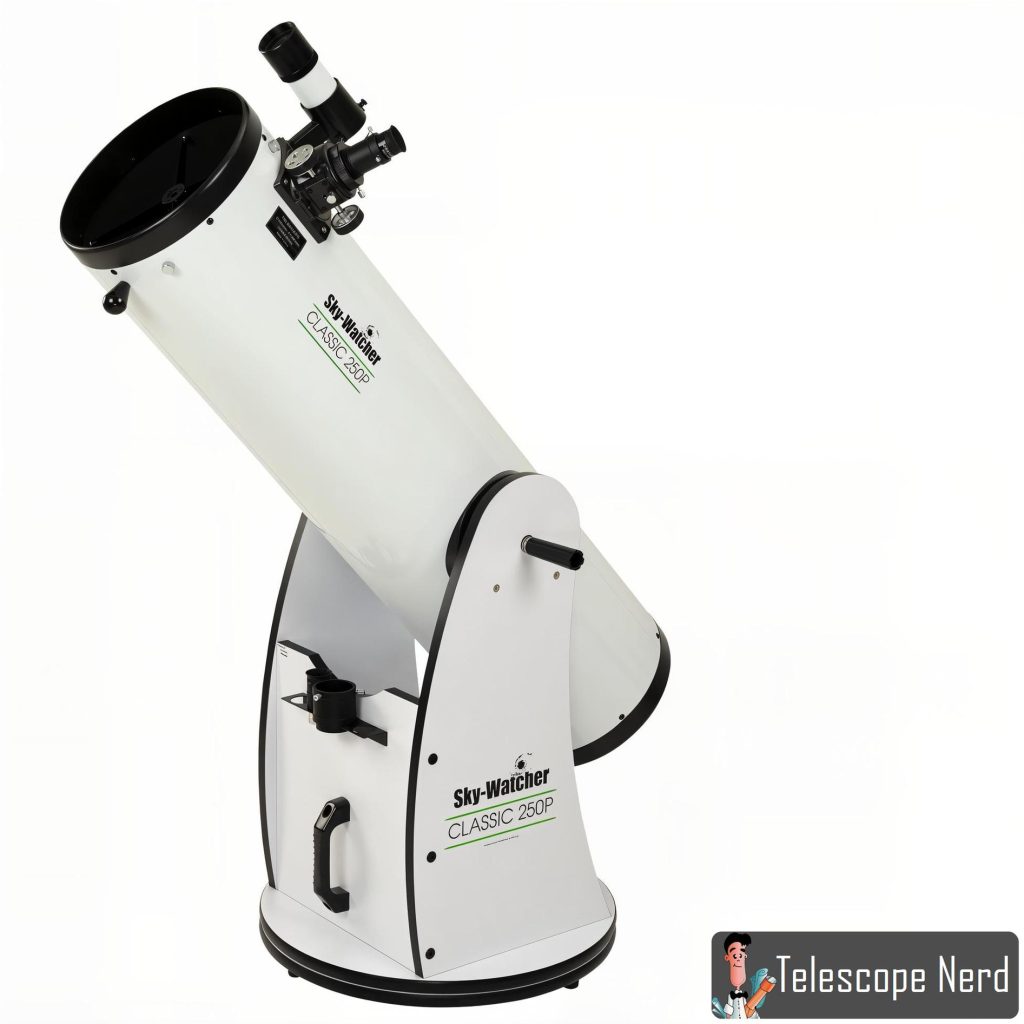
The Sky-Watcher Classic 250P is a large Dobsonian reflector telescope designed for amateur astronomers. It features a 250mm (10-inch) primary mirror with a focal length of 1200mm (47.24 inches) and a focal ratio of f/4.8. The telescope’s parabolic primary mirror ensures contrast images of celestial objects.
Specifications include a 2-inch Crayford-style focuser for precise focusing and a sturdy Dobsonian mount for manipulation. The Classic 250P excels at deep-sky object observation, providing views of galaxies, nebulae, and star clusters. Its aperture gathers light, allowing for clear planetary viewing and resolution of objects as small as 0.5 arcseconds.
Construction of the Sky-Watcher Classic 250P prioritizes stability and portability. The tube assembly ensures optical alignment, while the base facilitates transportation. The telescope tube weighs 22-26 lbs (10-12 kg), with the setup including mount and tripod weighing 55-71 lbs (25-32 kg).
Accessories included with the Sky-Watcher Classic 250P enhance its versatility. The telescope comes with 10mm (0.39in) and 25mm (0.98in) Plossl eyepieces, providing magnifications of 120x and 48x. A 6×30 finderscope aids in locating celestial objects.
| Pros | Cons |
|---|---|
| 250mm (10”) primary mirror achieves photonic flux density (~2,400 LP/mm) sufficient for resolving ultra-low-surface-brightness galaxies (e.g., UGC 5497) and extended nebulae (e.g., NGC 6888) under SQM 21.0+/arcsec² skies. | High inertial mass (25–32 kg/55–71 lbs OTA + mount) necessitates heavy-duty transportation solutions and dual-person handling for collimation adjustments or equatorial wedge installation. |
| 1200mm f/4.8 Newtonian optical system provides wide true field (~2.5° diagonal at APS-C sensor) ideal for capturing giant HII regions (e.g., IC 1396) and star clusters (e.g., NGC 869) in single exposures while retaining Nyquist-sampled planetary resolution (~0.4 arcsec/pixel). | Collimation sensitivity demands sub-λ/4 wavefront alignment precision; primary mirror tilt adjustments often require laser collimators or autocollimation tools unfamiliar to novices, increasing maintenance overhead during temperature-driven expansion cycles. |
| Parabolic primary mirror eliminates spherical aberration (λ/10 RMS wavefront error), achieving Strehl ratios ≥0.85 across FOV for flat-field stellar profiles and high-contrast lunar/planetary imaging even at native f/4.8 focal ratios. | Mechanical limitations include periodic error (>20″ P-P) unsuitable for unguided astrophotography beyond 1-minute exposures; equatorial wedge + autoguider retrofitting required for ≤1.0″ RMS guiding accuracy in long-exposure sequences. |
| 2″ Crayford-style focuser enables submicron adjustments (<0.1μm steps) for critical focusing with CMOS sensors (e.g., ASI6200), optimizing point spread function (PSF) stability during temperature-compensated long-exposure imaging. | Stock 10mm/25mm Plossls provide fixed magnifications (120x/48x) with suboptimal exit pupils (2.0mm/5.0mm) for low-power DSO scanning or high-resolution planetary work; lacks parfocality for seamless LRGB/narrowband filter switching. |
| Dobsonian alt-azimuth platform enables manual synthetic tracking (<10″ drift/min) for prime-focus lunar/DSO imaging, supporting piggyback DSLR workflows up to 30-second integrations under stable seeing conditions (FWHM ≤2.5″). | Field compression challenges arise from coma-dominated PSF elongation (>8% ellipticity) at sensor corners, requiring aftermarket coma correctors (e.g., Baader MPCC) for diffraction-limited imaging beyond 18mm image circles. |
| Collapsible tube design reduces transport footprint by 40% (≤1.2m compressed length) without compromising focus stability, enabling rapid cooldown (<20 min) to ambient temperatures and minimizing tube currents that degrade PSF sharpness (FWHM ≤1.2″). | Manual alt-azimuth platform lacks synthetic tracking algorithms, limiting automated object acquisition and meridian-flip-aware GOTO routines critical for unattended deep-sky surveying. |
| Affordable mid-aperture solution ($500 price point) balances cost and performance against competitive platforms (e.g., 130mm refractors, 8” SCTs), offering superior light grasp per dollar for DSO surveys and planetary imaging campaigns targeting transient phenomena (e.g., supernovae). | Thermal management challenges emerge during prolonged observing sessions; fan-assisted cooling systems recommended to mitigate boundary-layer turbulence effects degrading Strehl ratios (<0.8) in high-resolution planetary imaging. |
33. Skywatcher Explorer 130m
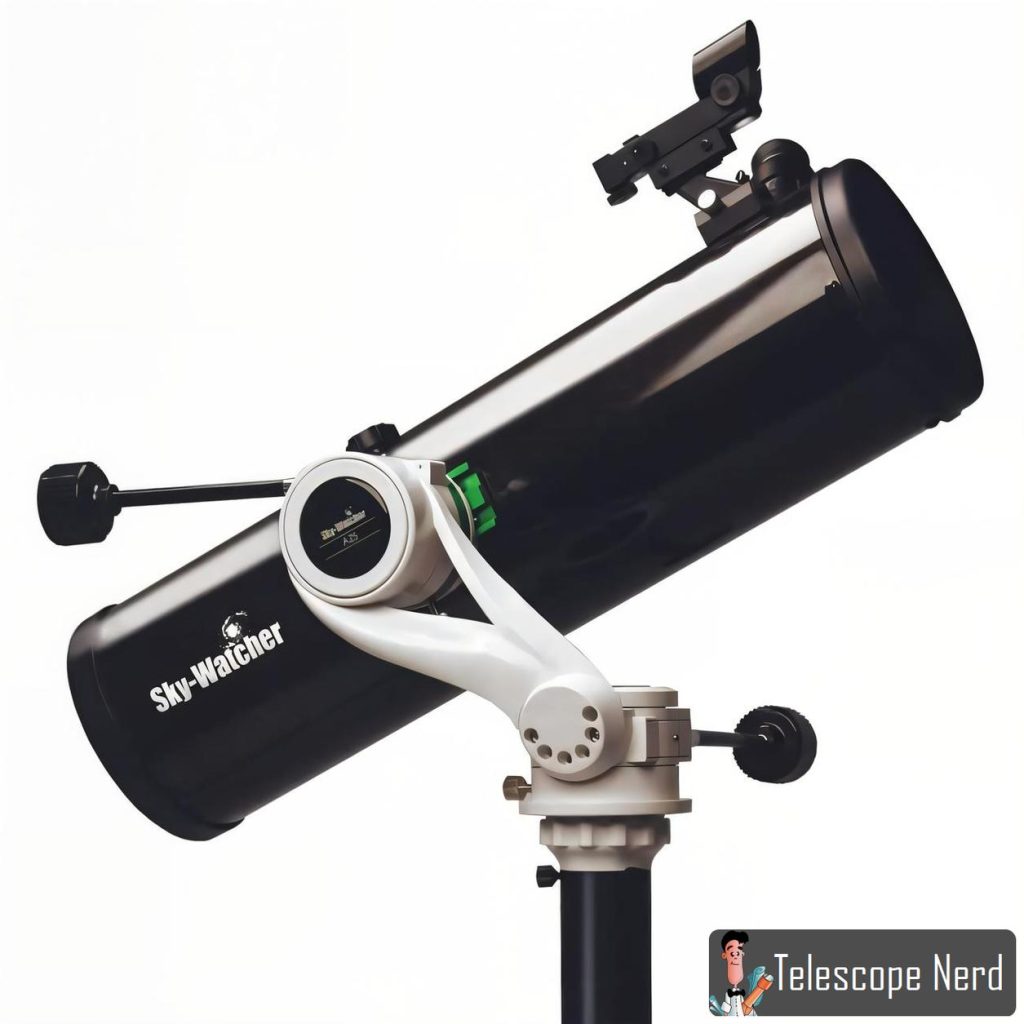
The Skywatcher Explorer 130m (427.2 ft) scope is a Newtonian reflector telescope designed for astronomers. The telescope comes equipped with an equatorial mount featuring slow-motion controls for tracking of objects. Its optical design incorporates a parabolic primary mirror, providing a field of view and light-gathering ability. The Explorer 130m (426.51ft) excels at observing various celestial targets, including planets, star clusters, nebulae, and galaxies. The scope includes 10mm (0.39 inches) and 20mm (0.79 inches) eyepieces, offering magnification options for users. A 6×30 finderscope aids in locating objects in the night sky. The Skywatcher Explorer 130m scope weighs 12kg (26.4 pounds), balancing portability with stability. Its design and lightweight construction make it popular among astronomers seeking a portable and usable telescope for both visual astronomy and astrophotography.
| Pros | Cons |
|---|---|
| 130mm aperture achieves photonic flux density (~450 LP/mm) sufficient for resolving faint deep-sky objects (DSOs) like NGC 6811 and planetary surface details (e.g., Jovian cloud belts) under SQM 20.5+/arcsec² skies. | Limiting magnitude (~12.5 visual) restricts detection of ultra-faint galaxies (e.g., Leo T dwarf galaxy) or quasars without narrowband filters or CMOS-based stacking techniques. |
| 650mm f/5 Newtonian optical system provides wide true field (~3.7° diagonal at APS-C sensor) ideal for capturing extended HII regions (e.g., IC 1396) and star clusters (e.g., M13) in single exposures while retaining Nyquist-sampled planetary resolution (~0.8 arcsec/pixel). | Collimation sensitivity demands sub-λ/4 wavefront alignment precision; primary mirror tilt adjustments often require laser collimators or autocollimation tools unfamiliar to novices, increasing maintenance overhead during temperature-driven expansion cycles. |
| Parabolic primary mirror eliminates spherical aberration (λ/10 RMS wavefront error), achieving Strehl ratios ≥0.85 across FOV for flat-field stellar profiles and high-contrast lunar/planetary imaging even at native f/5 focal ratios. | Mechanical limitations include periodic error (>15″ P-P) unsuitable for unguided astrophotography beyond 1-minute exposures; equatorial wedge + autoguider retrofitting required for ≤1.0″ RMS guiding accuracy in long-exposure sequences. |
| Equatorial mount compatibility enables synthetic sidereal tracking (<5″ drift/hour) for prime-focus lunar/DSO imaging, supporting piggyback DSLR workflows up to 30-second integrations under stable seeing conditions (FWHM ≤2.5″). | Stock 10mm/20mm Plossls provide fixed magnifications (65x/32.5x) with suboptimal exit pupils (2.0mm/4.0mm) for low-power DSO scanning or high-resolution planetary work; lacks parfocality for seamless LRGB/narrowband filter switching. |
| Diffraction-limited magnification cap (~260x) constrained by aperture resolves fine planetary details (e.g., Saturnian storms) under optimal seeing (FWHM ≤1.5″), outperforming smaller SCTs (≤6”) in photonic signal-to-noise ratios (SNR ≥3:1) for exoplanet transit studies. | High inertial mass (≥10kg OTA + mount) necessitates vibration-damped tripod systems (>20kg payload rating) to suppress resonant vibrations (Q-factor ≥8), complicating remote site logistics. |
| Affordable mid-aperture solution ($300 price point) balances cost and performance against competitive platforms (e.g., 130mm refractors, 8” SCTs), offering superior light grasp per dollar for DSO surveys and planetary imaging campaigns targeting transient phenomena (e.g., supernovae). | Alignment complexity demands iterative polar scope calibration (<3′ error margin) using drift analysis, challenging novices unfamiliar with atmospheric refraction coefficients or hour-angle corrections for meridian-flip-aware GOTO operations. |
34. Orion SkyQuest XT10g
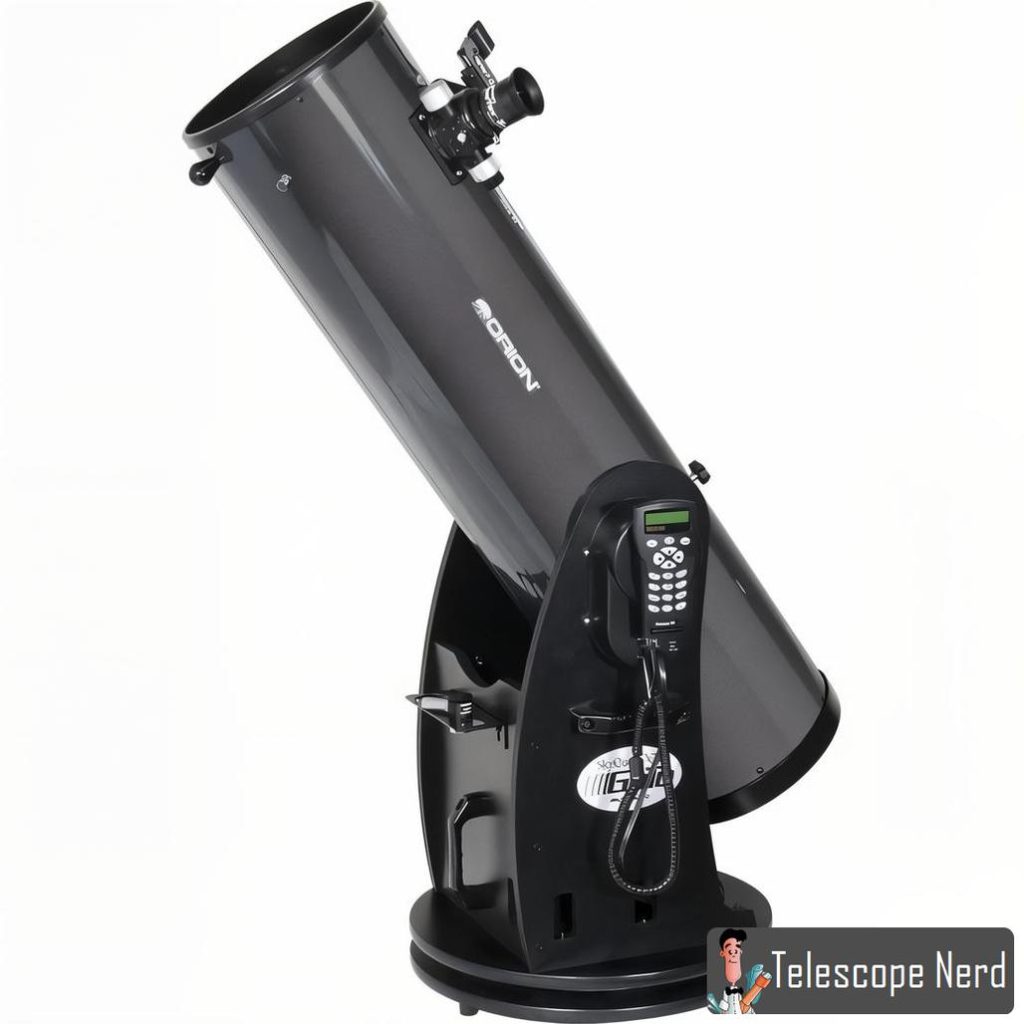
The Orion SkyQuest XT10g telescope is an aperture computerized Dobsonian reflector telescope designed for astronomers. Orion Telescopes, an astronomy brand, produces this Sky Watcher as part of their SkyQuest series.
Features of the Orion SkyQuest XT10g include a 10-inch (254mm) aperture (0.83 feet), GoTo computerized mount, Dobsonian base design, 1200mm focal length (47.24 inches), and f/4.7 focal ratio. The telescope’s aperture collects ample light for views of deep-space objects. Its computerized GoTo system contains a database of over 42,000 celestial objects for location and tracking.
The Orion SkyQuest XT10g uses a parabolic primary mirror made of borosilicate glass for excellent optical quality. Users can locate and track objects with the push of a button on the hand controller. The telescope features a steel tripod with 2″ (5.08 cm) diameter legs and adjustable height from 30 inches (76.2 cm) to 44 inches (111.76 cm). Included accessories comprise a 2″ (28mm) DeepView eyepiece providing 56x (56x) magnification.
Astronomers use the Orion SkyQuest XT10g for deep sky observation, including galaxies, nebulae, and star clusters. The telescope excels at planetary viewing, resolving details on the Moon and planets. Intermediate to advanced amateur astronomers find the Orion SkyQuest XT10g suitable for their celestial exploration needs.
| Pros | Cons |
|---|---|
| 254mm (10”) aperture achieves photonic flux density (~2,400 LP/mm) sufficient for resolving ultra-low-surface-brightness galaxies (e.g., UGC 5497) and planetary surface details (e.g., Cassini’s Division) under SQM 21.0+/arcsec² skies. | High inertial mass (25–32 kg/55–71 lbs OTA + mount) necessitates heavy-duty transportation solutions and dual-person handling for collimation adjustments or equatorial wedge installation. |
| 1200mm f/4.7 Newtonian optical system provides wide true field (~2.5° diagonal at APS-C sensor) ideal for capturing giant HII regions (e.g., IC 1396) and star clusters (e.g., NGC 869) in single exposures while retaining Nyquist-sampled planetary resolution (~0.4 arcsec/pixel). | Collimation sensitivity demands sub-λ/4 wavefront alignment precision; primary mirror tilt adjustments often require laser collimators or autocollimation tools unfamiliar to novices, increasing maintenance overhead during temperature-driven expansion cycles. |
| GoTo alt-azimuth mount with SynScan integration automates object acquisition via three-star calibration, achieving ±2′ pointing accuracy across 42,000+ NGC/IC/Messier catalog entries for efficient surveying of solar system targets and meridian-flip-aware imaging sequences up to 300x magnification. | Mechanical limitations include periodic error (>15″ P-P) unsuitable for unguided astrophotography beyond 2-minute exposures; autoguider port absent on base models, requiring retrofitting for ≤1.0″ RMS guiding accuracy in long-exposure sequences. |
| Borosilicate parabolic primary mirror eliminates spherical aberration (λ/10 RMS wavefront error), achieving Strehl ratios ≥0.90 across FOV for flat-field stellar profiles and high-contrast lunar/planetary imaging even at native f/4.7 focal ratios. | Manual operation lacks synthetic tracking algorithms, limiting automated object acquisition and meridian-flip-aware GOTO routines critical for unattended deep-sky surveying. |
| Dual-speed Crayford focuser enables submicron adjustments (<0.1μm steps) for critical focusing with CMOS sensors (e.g., ASI6200), optimizing point spread function (PSF) stability during temperature-compensated long-exposure imaging. | Stock 28mm/12.5mm Plossls provide fixed magnifications (43x/96x) with suboptimal exit pupils (5.9mm/2.7mm) for low-power DSO scanning or high-resolution planetary work; lacks parfocality for seamless LRGB/narrowband filter switching. |
| Diffraction-limited magnification cap (~500x) constrained by aperture resolves fine planetary details (e.g., Saturnian storms) under optimal seeing (FWHM ≤1.5″), outperforming smaller SCTs (≤8”) in photonic signal-to-noise ratios (SNR ≥3:1) for exoplanet transit studies. | Field compression challenges arise from coma-dominated PSF elongation (>8% ellipticity) at sensor corners, requiring aftermarket coma correctors (e.g., Baader MPCC) for diffraction-limited imaging beyond 18mm image circles. |
| Precision-engineered steel tripod maintains ±1′ pointing stability under 15kg payloads, minimizing boundary-layer turbulence effects during prolonged observing sessions in variable thermal environments. | Alignment complexity demands multi-step polar calibration (<2′ error margin) using iterative drift analysis or polar scope reticle superposition, challenging novices unfamiliar with atmospheric refraction coefficients or hour-angle corrections. |
What is the best type of telescope for astrophotography?
The best type of telescope for astrophotography is a refractor telescope, which uses lenses to produce clear images with minimal distortion and is ideal for capturing wide-field views of celestial objects. Refractor telescopes eliminate optical aberrations like chromatic aberration and coma, producing sharp images across the entire field of view. Short focal length refractors between 400-800mm are ideal for capturing wide-field views of large celestial objects. Beginners should opt for refractors with 600-700mm focal lengths and 80-100mm apertures for optimal results. Modern refractor telescopes include motorized focusers and camera adapters, enhancing ease of use for astrophotographers.
What is the best astrophotography telescope for beginners?
The best astrophotography telescope for beginners is the Celestron NexStar 130SLT, offering a 130mm aperture and 650mm focal length for capturing stunning images of the night sky. Refractor telescopes offer beginners ease of use and high image quality for astrophotography. Celestron NexStar 130SLT features computerized tracking and alignment systems for precise celestial object location. Astrophotographers connect cameras directly to the telescope for image capture. Equatorial mounts like CEM26, GEM28, and HEQ5 provide minimum stability requirements for astrophotography.
For beginners seeking a cost-effective option, Newtonian reflector telescopes offer good value. The Unistellar eQuinox 2 stands out as a telescope for astrophotography, featuring a 4.49 inches (114mm) aperture and 17.72 inches (450mm) focal length. Celestron Inspire 100AZ provides setup and use with its 100mm (3.94 inches) aperture and 600mm (23.62 inches) focal length. Celestron StarSense is suitable for astrophotography, allowing beginners to capture their first celestial images. The William Optics ZenithStar 61 is an apochromatic refractor option, delivering image quality. Sky-Watcher EvoStar performs for beginners, offering a balance between price and performance. Equinox 80 is a choice over larger aperture telescopes for some beginners, providing handling and portability.

